Better not sell the old man short

This story originally appeared in the Sept. 29, 1980 issue of Sports Illustrated. Subscribe to the magazine here.
The Terrible Table stands on shining aluminum legs that dig deep into the thick carpeting of Suite 301 of Caesars Palace in Las Vegas. The table, a three-by-seven-foot instrument of torture, like much of the decor in the suite, is a glaring orange, and it is on its shiny vinyl surface that Muhammad Ali, at the age of 38, will win—or lose—in his bid for an unprecedented fourth world heavyweight championship. The table is Ali’s rack, his Iron Maiden. On it he has torn down and rebuilt the body that had become so bloated during the past 25 months. Whatever happens on Oct. 2, when Ali meets Larry Holmes, the undefeated WBC heavyweight champion, in the specially erected $800,000 outdoor stadium at Caesars, one irrefutable fact will stand out: Ali, grossly out of shape only a few months ago, will be in better physical condition than at any time since he fought Joe Frazier in Manila in 1975. And in better physical and mental condition than at any time since he battled George Foreman in Zaire in 1974.
Once this figured to be the fight no one would want to see: Ali, flabby and floundering, would be stung into submission by the flashing jab of a man eight years younger; he would inevitably be hammered onto the canvas by a boxer who had 27 knockouts in 35 fights. It would be no more than a grotesque replay of the 28-year-old Rocky Marciano vs. the 37-year-old Joe Louis, of the tough young fighter against the venerated but vulnerable former champion whose comeback could end in nothing but the sad tolling of nine-ten-and-out.
It won’t happen that way.
From The Vault: Every Ali Cover Story
- Cassius invades Britain
- My $1,000,000 Getaway
- Cassius—His Fight And His Future
- The Big Fight: Can Clay Do It Again?
- Cassius Clay vs. Sonny Liston
- The Fight You Didn't See
- The Big Fight: Clay vs. Patterson
- Cassius Clay: The Man, the Muslim, the Mystery
- The Big Fight: Clay vs. Terrell
- Scramble for Ali's title
- Ali-Clay; the once and future king?
- The Slugger And The Boxer
- End of the Ali legend
- The future is a mist
- The Jaw is broken
- Ali Again
- Muhammad Ali: Sportsman of the Year
- Boxing's New Barnum
- The Epic Battle
- Ali's Road Show Rolls On
- Ali's Desperate Hour
- The Champ Again
- Look Who's Back!
- He's no Liston. He's no Frazier.
- The Last Hurrah
- The man and his entourage today
- 35th anniversary
- Once and Forever
- Battle of Champions: Ali vs. Frazier
- Who's that guy with Howard Bingham?
It is 6:15 a.m. and Ali, after a six-mile run alone across the Dunes Golf Course that began at 3:30, sits in the drawn-curtain half-light of his bedroom and watches a videotape replay of Holmes knocking out Mike Weaver—now the WBA champion—last year at Madison Square Garden. In the kitchen, Lana Shabazz yawns as she sets about preparing Ali’s breakfast: scrambled eggs, whole wheat toast and two large carafes of fruit juice. In the living room, asleep on a sofa near the Terrible Table, is Luis Sarria, the silent Cuban who directs Ali’s calisthenics and rubs him down.
As he watches the Holmes-Weaver fight, Ali speaks, at first softly: “When I was 256 pounds of fat and all out of shape and watching this film, I was worried. I didn’t know if I could do it. It was sooo strange. I asked myself: Can I do it? Can I make myself fast enough to beat this man? I was [his smile can be seen in the blue-white light of the TV set] worried. Very worried.”
A few days before, Ali had shaved the mustache that, together with a facial softening resulting from no exercise and too many sweets, had prematurely made him look middle-aged. Now his face is slim and firm. So is his body. It is as if he has turned the clock back to 1971, when he was 29.
“Look at that,” Ali, now shouting, remarks as he watches the two small figures pummeling each other on the screen. “Holmes is slow and wide open.” Ali’s left hand snakes out, jabbing and, before the eye can focus on it, cocking and jabbing again. “There! There is where I get him. Pop! Pop!” Leaping from the bed, Ali concentrates on the screen. “Pop! Pop! Bam!” The left flicks twice, quickly followed by a streaking right.
“Holmes is down!” Ali yells as he narrates the picture he sees in his mind. “Ali goes to a neutral corner ... seven, eight, nine, 10! And for the world-record-setting, never-to-be-broken fourth time, Muhammad Ali is the heavyweight champion of the world. I can see it happening. It’s there. Now that I got my weight down and I’m in shape, I know I can do it. Man, I got confidence. I can see it in my mind just as if it was happening right there on the screen. Look at that: Weaver is sooo slow, and Holmes is having trouble hitting him. Right now Holmes is tired. You got to walk to Holmes, just keep walking at him and make him work. He gets tired. Sooo tired. Man, I’ll eat him alive.”
Pumping jabs, Ali comes perilously close to flooring the TV set as he shouts, “Pow! Pow! Pow! I see it all now: He’s exhausted, it’s my fight now. Bam! The right hand over the tired jab. Look, he’s talking to Weaver. Well, he ain’t heard no talking like I’m going to talk to him. I’ll really talk to him. He’s no Liston. He’s no Foreman. He’s no Frazier. He’s only Larry Holmes, and he’s nothin’. He’s just the man between me and my fourth title, and I’m going to beat him so bad it’s going to be a total mismatch. Look at that,” he says, pointing toward the TV. “That’s awful. If I didn’t know Holmes, hadn’t seen all that publicity, I’d ask: Who’s that bum?”
In another wing of Caesars Palace, on a floor one story higher, Larry Holmes is lying face down on a light purple couch. The champion has complained of a slight soreness in his back, and Richie Giachetti, his burly trainer and co-manager, kneels as he massages ointment into Holmes’s thick, distinctly defined latissimus dorsi muscles.
On the floor, his feet stuck under one end of the curved couch, is Jake Holmes, the champion’s older brother, who is sweating through 35 sit-ups. A short, powerful man, Jake has a weight problem, which leads to training camp bets with his brother. So far during training for the Ali fight, Jake has dropped 28 pounds, putting him at a trim 198 and leaving him $200 heavier in the wallet. Another 18 pounds would earn him a $10,000 bonus. “Only way I can get that low,” Jake moans, “would be to cut off a leg.”
“Might not be enough,” observes the champion. He winks at Giachetti.
A knock at the door cuts short the repartee. It’s room service. A liveried waiter, in obvious awe, wheels in a cart carrying Holmes’s breakfast: scrambled eggs, three slices of ham, toast and a couple of carafes of fruit juice.
“What’s that stuff on top of the juice?” Jake asks suspiciously.
“Pulp,” says the waiter, who is busy getting two autographs from the champion. “It is fresh squeezed.”
Holmes shifts to a sitting position and begins to eat, not as if he’s hungry but as if he’s performing an act dictated by the time of day. There is growing concern that he will enter the ring in the same mood. For certain, Holmes wants to beat Ali, to beat him badly, and to that end he has trained long and arduously. But the fierce compulsion that drove him to become the heavyweight champion may have become diluted, not so much by his success as by his maturation from a tough junior high dropout to a respected businessman-benefactor in his hometown of Easton, Pa. Additional fame and fortune have little appeal for Holmes. The change has clearly left him more of a man, but perhaps less of a fighter.
Since winning the championship from Ken Norton in June of 1978, Holmes hasn’t been in against anyone who came within a long ton of his class. Yet, both Weaver and Earnie Shavers—one no more than a muscular journeyman, the other well past his prime—almost toppled him from his hard-won throne. In each instance only Holmes’s great courage and pride brought him back from defeat: a rally after Shavers dropped him in the seventh round that resulted in an 11th-round TKO of Shavers and a return from lethargy against Weaver that had the same result in the 12th round.
“There’s something very wrong with Holmes,” says Angelo Dundee, Ali’s trainer for 19 years. “It’s physiological. I don’t know what it is, but after seven or eight rounds he runs out of gas. He has nothing left. It’s the George Foreman thing. But then, like Foreman, he’s only an earthling. People fail to understand that: Muhammad Ali is Muhammad Ali, and compared to him all other men are mere earthlings.”
But in confronting mere earthlings Ali can call upon only three weapons: a stinging left jab, a righthand counter over the top of his opponent’s jab and the mystique of being Ali. The last is the most powerful weapon in this limited arsenal.
“Bull,” growls Holmes, almost spilling his orange juice. “To me Ali is not God, but godless. Not Superman. Not a miracle worker. He’s a human being, just like you and me. He got his weight down, and he thinks that will make him young again. Well, it won’t. Ali can’t turn back the clock; no one can. And look at who he beat. Frazier was a midget. Foreman a robot. [Floyd] Patterson a rabbit. [Archie] Moore was old. [Cleveland] Williams old. [Sonny] Liston old. Just about everybody he fought was old. Now he’s going to find out how it feels to be an old man fighting a good, fast young man. I really believe I’ll knock him out. I have a great deal of respect for myself. I know what I can do. And I know what he will do—and I’m ready for it.”
What Ali intends to do is fight in flurries lasting a maximum of 30 or 40 seconds. The rest of the time Ali must rest and marshal his reconstituted body to wring another burst of 29-year-old power from muscles that have lived another decade. And all the time, fighting or resting, he must keep Holmes busy. The strategy is to keep the champ working until he tires, as he has in recent fights. Then, about the ninth or 10th round, Ali will throw that stunning right counter over a wearied jab and it will end. If it doesn’t, no matter. Ali, fighting for another title at an age when a lot of cops and firemen are thinking of their pensions, can go 15 rounds. Like a wild horse, he’ll keep going until he drops. But to avoid an early fall, he must not only control his own pace but dictate Holmes’s as well.
“Holmes expects me to run, to grab and hold,” says Ali. “The man is in for a surprise. I am going to win the first four or five rounds and then he’s going to get scared and make a mistake. Holmes can’t come from behind. He panics. If he panics against me, the right hand will end it. If he doesn’t panic, it won’t matter. I’ll win the early rounds, he can have the middle rounds if he earns them, but the late rounds will be mine because he’ll be too tired to do anything more than try to survive.”
Panic and too much regard for the Ali mystique are what Holmes must avoid. Holmes is a superior boxer. He could do some things as a preliminary fighter that Ali never tried to do as a champion. His jab is as good as Ali’s, perhaps better. That classic weapon is what Holmes’s reputation is built on. But because his jab is so quick and powerful, it has tended to obscure the fact that Holmes has a repertoire of effective combinations. He can throw combinations that Ali may not have had thrown at him. And certainly Holmes’s hook is far superior, if for no other reason than that Ali throws a hook about as often as Halley’s Comet emblazons the sky. “I don’t hook,” says Ali. “It leaves me open to a right hand. I don’t like getting hit by right hands.”
As well he might. Holmes’s right hand can be devastating. The question is: Can Holmes throw the right hand, or a hook, when it will finish a fighter? Against Shavers last year, Holmes repeatedly begged Shavers to retire honorably, on his feet. As Shavers staggered about the ring, Holmes pleaded, “Earnie, quit. I’m afraid I’m going to hurt you bad.”
“Screw you,” Shavers snarled back. “You’re making a million dollars. Fight!”
And Holmes needed almost four rounds from the time he regained control of the bout to stop the stumbling Shavers.
With his ability as a finisher in question, it becomes all the more imperative that Holmes devise a strategy that will prevent Ali from setting the tempo of the fight. When Ali goes into his rope-a-dope to rest, which he will do frequently, Holmes must not wear himself out banging uselessly against Ali’s protective shell of arms. He must take a step to either side and then unleash his potent hook to the kidneys to make Ali lower his guard. That was how Spinks won the title in his first fight with Ali.
And Holmes must have an answer to Ali’s habit of grabbing an opponent behind the neck and pulling his head strongly downward. He did it 137 times in his second, victorious fight with Frazier. While to onlookers this maneuver appears to be only annoying, part of Ali’s disdainful ring showmanship, in fact it tends over the course of several rounds to paralyze the vertebrae of an opponent’s neck as he bucks and twists to free himself. The tactic subtly wears a man down. It’s innocuous enough at first, when it causes just the neck to tighten up. But as the rounds go by, the weariness spreads from the beleaguered neck to the arms, then the legs, and eventually even a superbly conditioned body rebels against the need to maintain balance while trying to press forward.
“I hope he tries that,” says Holmes, finishing off a piece of toast. “He grabs my neck and I’ll kill his kidneys.”
The rope-a-dope?
“Then I’ll show you a dope on the rope.” Standing, Larry uses Jake to demonstrate how he’ll attack Ali. He loops wide hooks to the lower back, he fires a quick right uppercut and then hooks to the temple with his left. “The uppercut turns his head and sets up the chin and the temple area for the left hook,” Holmes explains. “This is where you hit Ali: high on the side of the head in the area of the temple. That’s what’ll get him. That, and moving side to side and hooking to his kidneys.”
The demonstration complete, Holmes resumes his breakfast. For a moment he appears deep in thought; then: “This is not only Ali’s last hurrah, but it could be mine, too. If I lose this fight, I might never fight again.”
To the observer, it seems the thought of never fighting again doesn’t disturb Holmes, an impression reinforced by the champion’s next words. “I traveled with Ali as a sparring partner and I saw all the things I thought I wanted,” he says, speaking as much to himself as to those in the room. “But now I’ve got all those things, and I’ve learned that they aren’t as important as I once thought they were. Sure, I want to beat Ali, to finally get the recognition that I'm the real champ. But I’m not crazy about the limelight. I get up in the morning, I want to be alone. I go out to dinner, I want to be alone. This Ali fight has given me more publicity than I’ve ever had, more than I want. I belong to the public, but I belong to myself, too.”
Holmes leaves part of his breakfast on the table. Hunger—for food or fame or even fortune—is no longer the driving force in his life.
It is the following morning, and Ali, draped with a white bath towel, is lying belly down on the Terrible Table. Lloyd Wells, the keeper of the calisthenics log, is reading aloud newspaper stories about the upcoming fight. Ali half listens as he watches Today on television. Wells finishes a story written by Tommy Lopez in The Las Vegas Review-Journal.
“That it?” Ali asks.
“Yeah,” says Wells as he turns through the sports pages. “Wait, here is a story where Don King picks Holmes to win.”
“Read it,” Ali orders.
“... King said, ‘Father Time has caught up with Ali. Yesterday’s champ will not be today’s champ....’”
There is an angry look on Ali’s face and he suddenly rolls over on his back. With a grunt Ali does his first sit-up of the day. There are 13 cruel variations of the exercise that have been given names like the Belly Buster, the Scissors Mambo, the Leg Spin, the Bo Bo Circle and, the worst, the Green Bay Packer Run-’Em-Out-of-Camp Rock.
It was to the Terrible Table that Ali went to get into condition to destroy Spinks in their second fight more than two years ago. For that one he did 8,024 sit-ups in 39 days. “What was the one-day record for Spinks?” Ali asks after his 42nd Belly Buster.
Wells looks up from the purple ledger he uses to record each day’s work. “It was 517,” he says.
“I’ll beat that today,” says Ali, as he resumes driving his body back through the years. The total for this day will be 536 sit-ups. It is Ali’s 39th day of serious training, and his sit-up total is already 10,000, even. There are still 22 days until the fight with Holmes.
On the afternoon of this day, Ali also boxes 36 straight minutes without rest, using seven sparring partners. He weighs 224 pounds, and the rolls of fat that jiggled through his most recent fights have disappeared. He’s 29 again.
The betting had opened with Holmes favored 3–1 and had dropped to 2–1. On the day Ali sparred nonstop for more than a half-hour, the odds were 9–5. The next day they dipped to 8–5. “The odds are dropping like my waistline,” says Ali with a laugh. Then his voice hardens and the words come as darts. “They say I’m going to get hurt. When did I ever get hurt? They say I got brain damage. Liver damage. They all lied. I spent three days at the Mayo Clinic. They stuck wires in me; I looked like Frankenstein’s monster. I passed every test. Look how pretty I talk. How could I have brain damage? I’ll show those lying....”
For Ali, this 60th professional fight, for which he’ll receive $8 million, is The Big One. Again. That’s all he needs. It has been said that he has made a critical mistake by not having a tune-up. The simple truth is that he probably couldn’t beat any other decent heavyweight because any other heavyweight would be, to him, meaningless. Ali has always had a problem walking up a gently sloping hill, but he can race up a mountain.
“I’m the underdog,” he bellows happily. “God, I love it. Just tell me I can’t do something. Tell me it’s impossible. Tell me I’m not the greatest.”
Put it all in a computer and the winner comes out Holmes. He’s a superb champion, he’s eight years younger than Ali and he’s in excellent condition. In the last two years he has had seven fights to Ali’s none. He’s unbeaten.
There’s just one thing that he isn’t: he isn’t Muhammad Ali. No other earthling could be.
SI's 100 Greatest Photos of Muhammad Ali
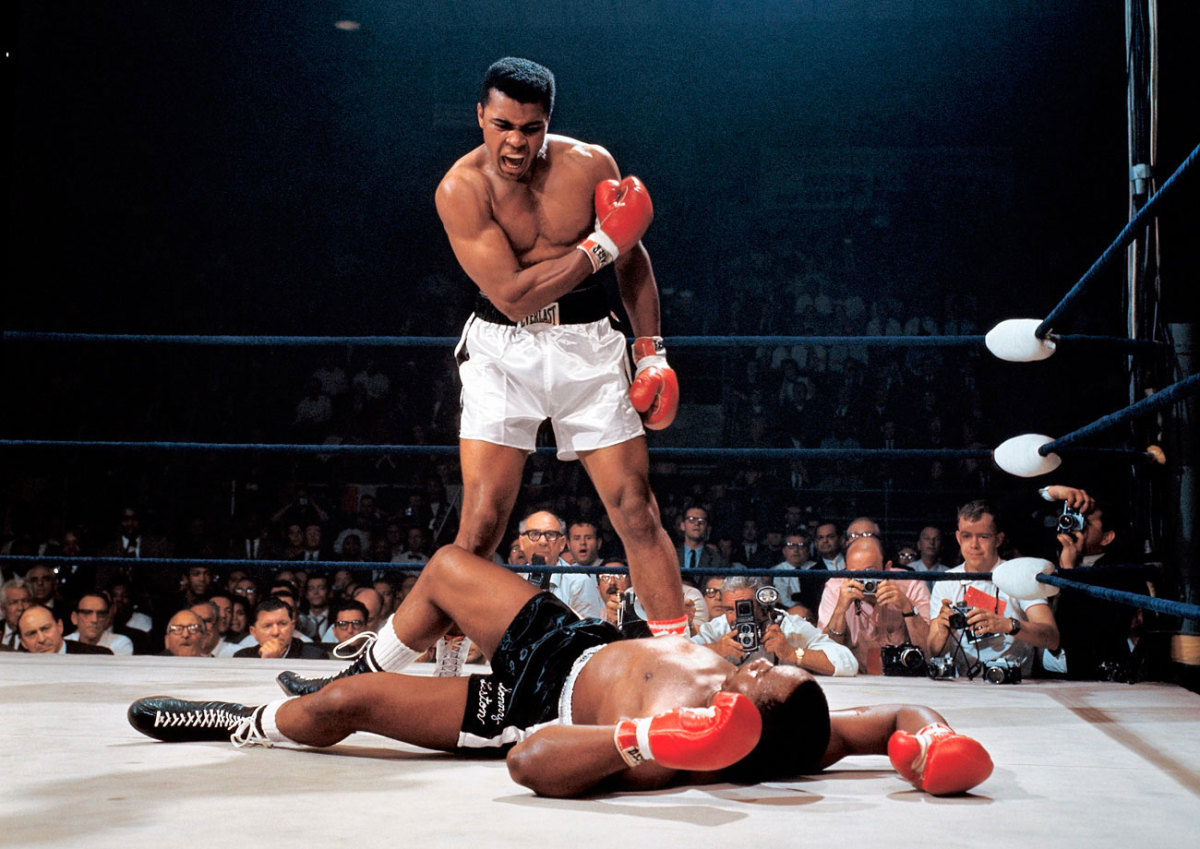
In one of the most iconic and controversial moments of his career, Ali stands over Sonny Liston and yells at him after knocking the former champ down in the first round of their 1965 rematch. Skeptics dubbed it "the Phantom Punch," but films show Ali's flashing right caught Liston flush, knocking him to the canvas. Refusing to go to a neutral corner, Ali stood over Liston and told him to "get up and fight, sucker."
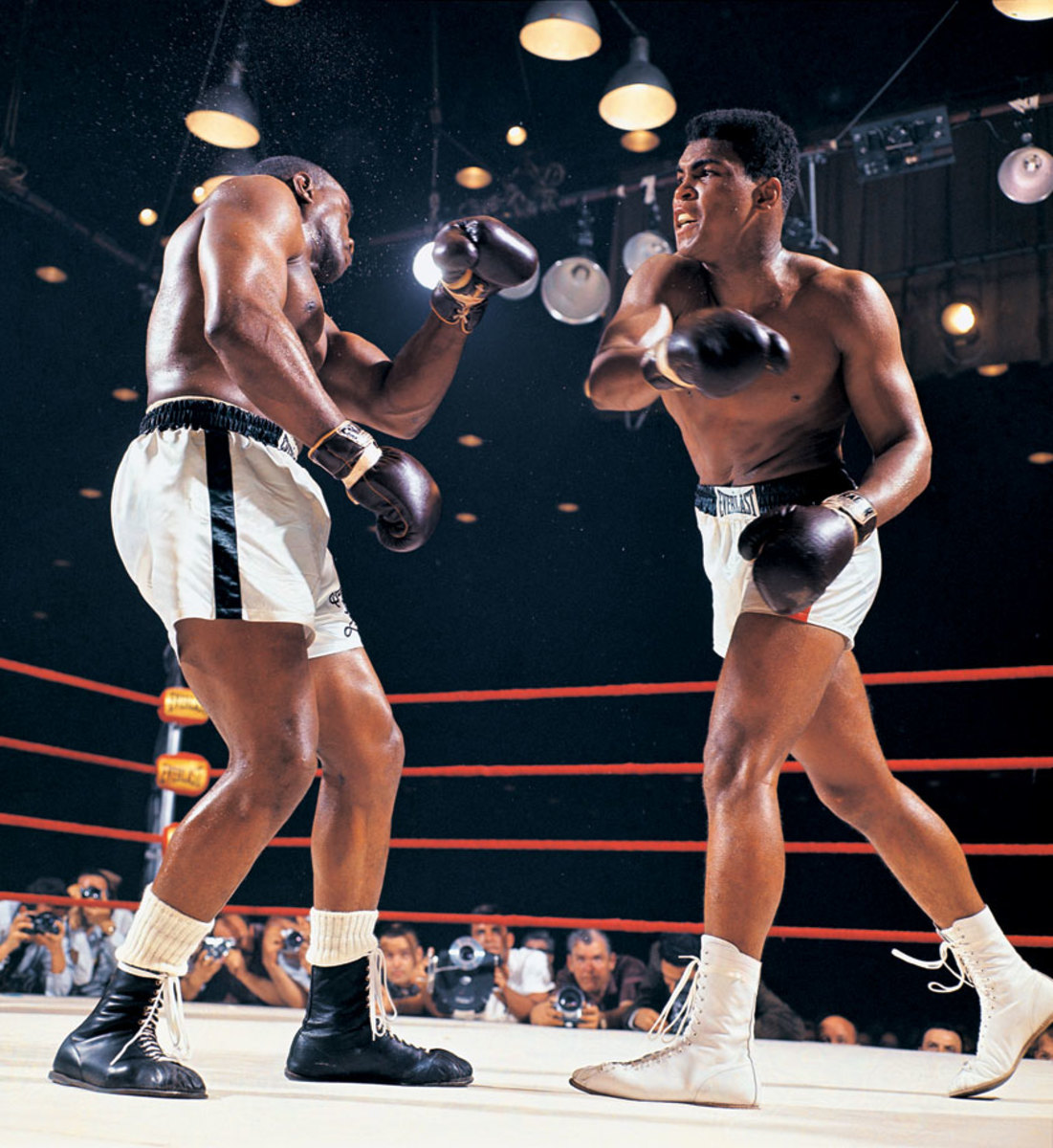
At 22-years-old, Cassius Clay (Muhammad Ali) battered the heavily favored Sonny Liston in a bout that shook the boxing world. The fight ignited the career of one of sports' most charismatic and controversial figures, whose bouts often became social and political events rather than simply sports contests. At the peak of his fame, Muhammad Ali was the best known athlete in the world. Liston, one of the most feared heavyweight champions in history, was a 1-8 favorite over the young challenger known as the Louisville Lip. But Clay, here stinging the champ with a right, used his dazzling speed and constant movement to dominate the action and pile up points.
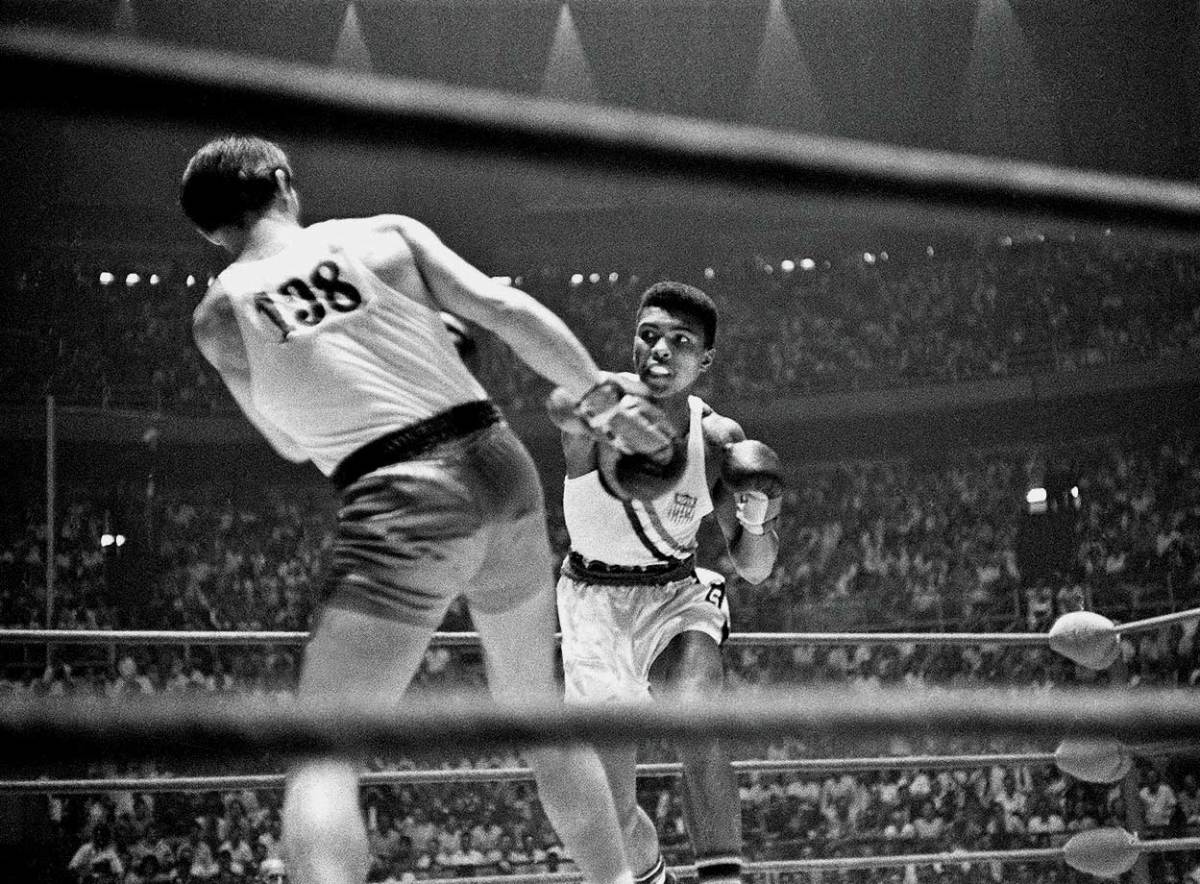
Cassius Clay punches Zbigniew Pietrzykowski of Poland during their gold medal bout at the 1960 Rome Olympics. Clay defeated Pietrzykowski 5-0 for the light heavyweight gold medal.
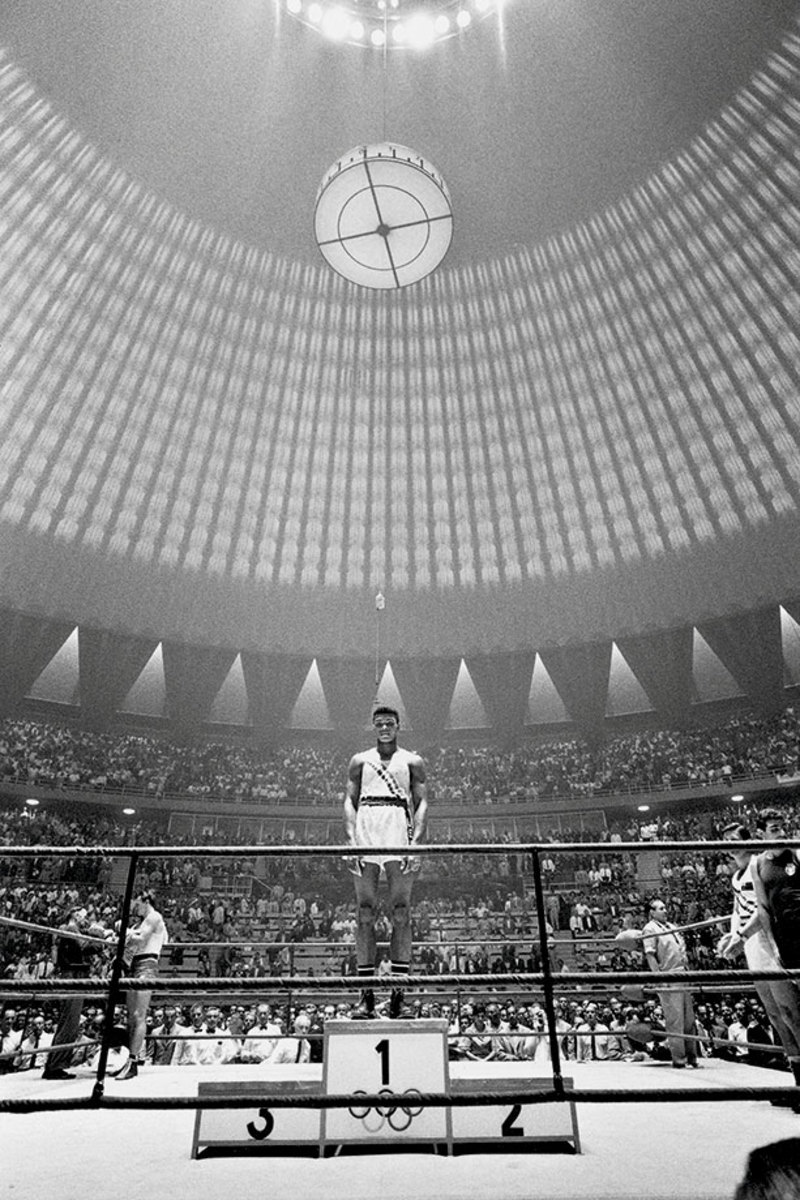
For the 18-year-old from Louisville, here atop the medal stand after his Olympic victory, all roads led from Rome. Clay finished his amateur career with a record of 100-5 and made his professional debut two months after the Games.
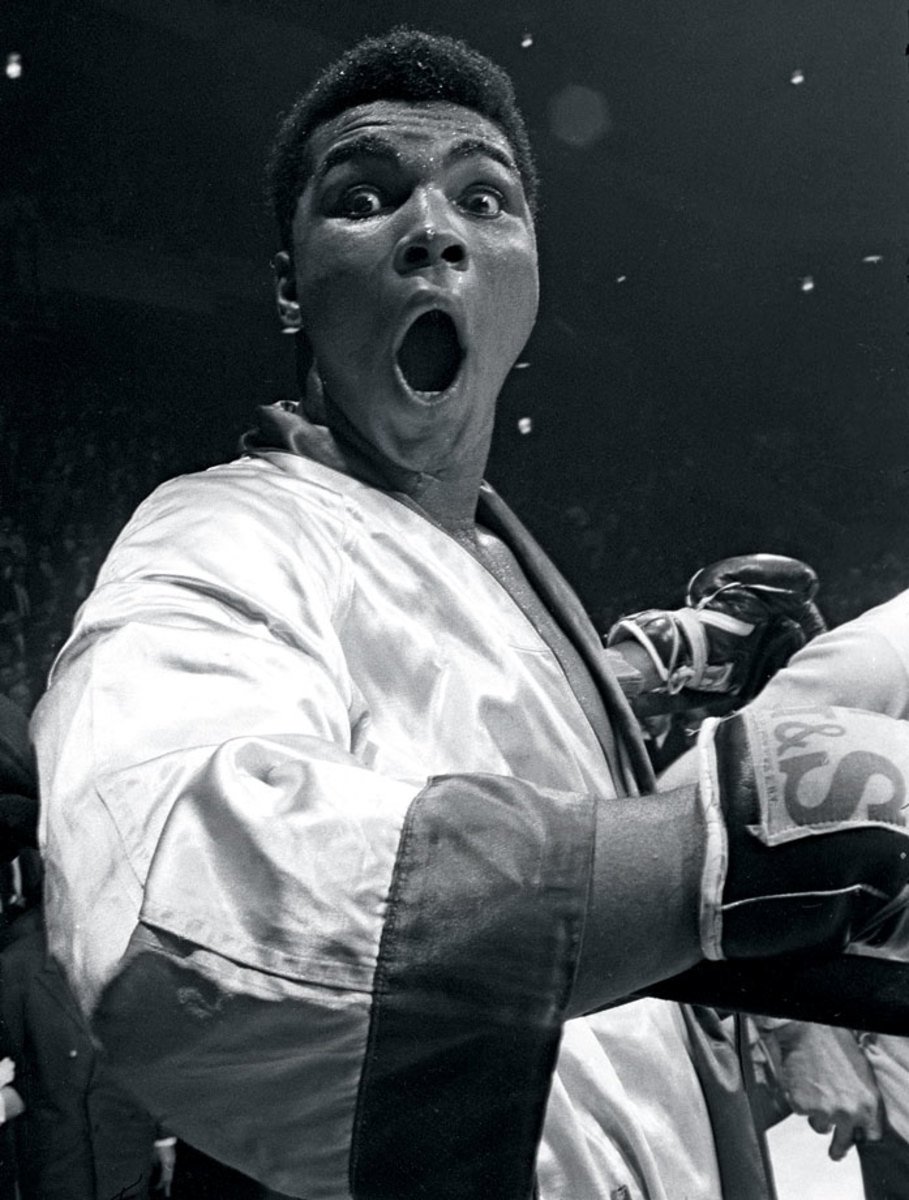
Undefeated in his first 17 pro fights, Clay mugged for the camera before the start of his 1963 bout against Doug Jones in Madison Square Garden.
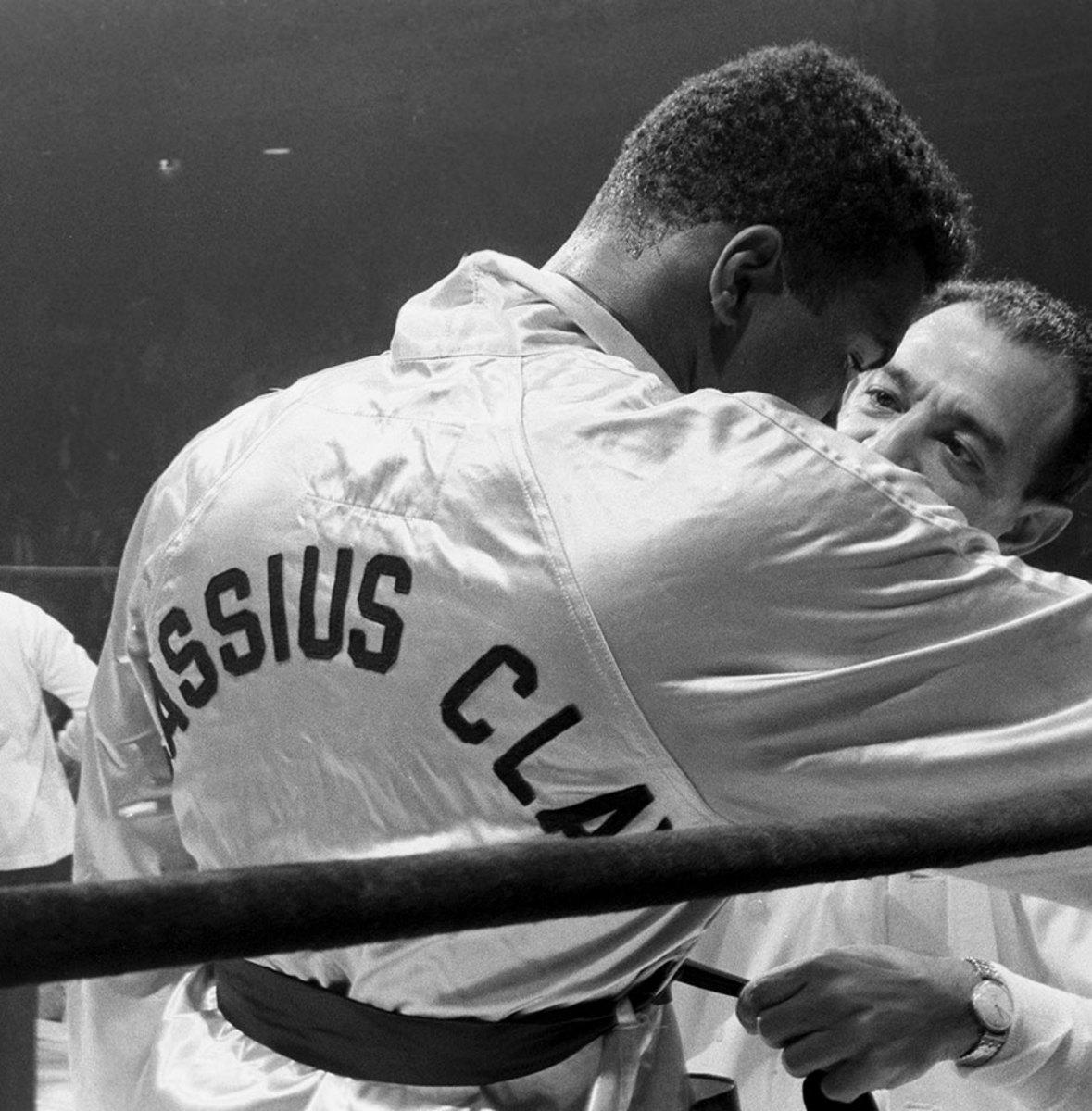
Trainer Angelo Dundee urged his young charge to get serious before the opening bell against Jones. Clay followed instructions and emerged from a tough fight with a unanimous decision victory. Three months later he would stop Henry Cooper and close out 1963 at 19-0.
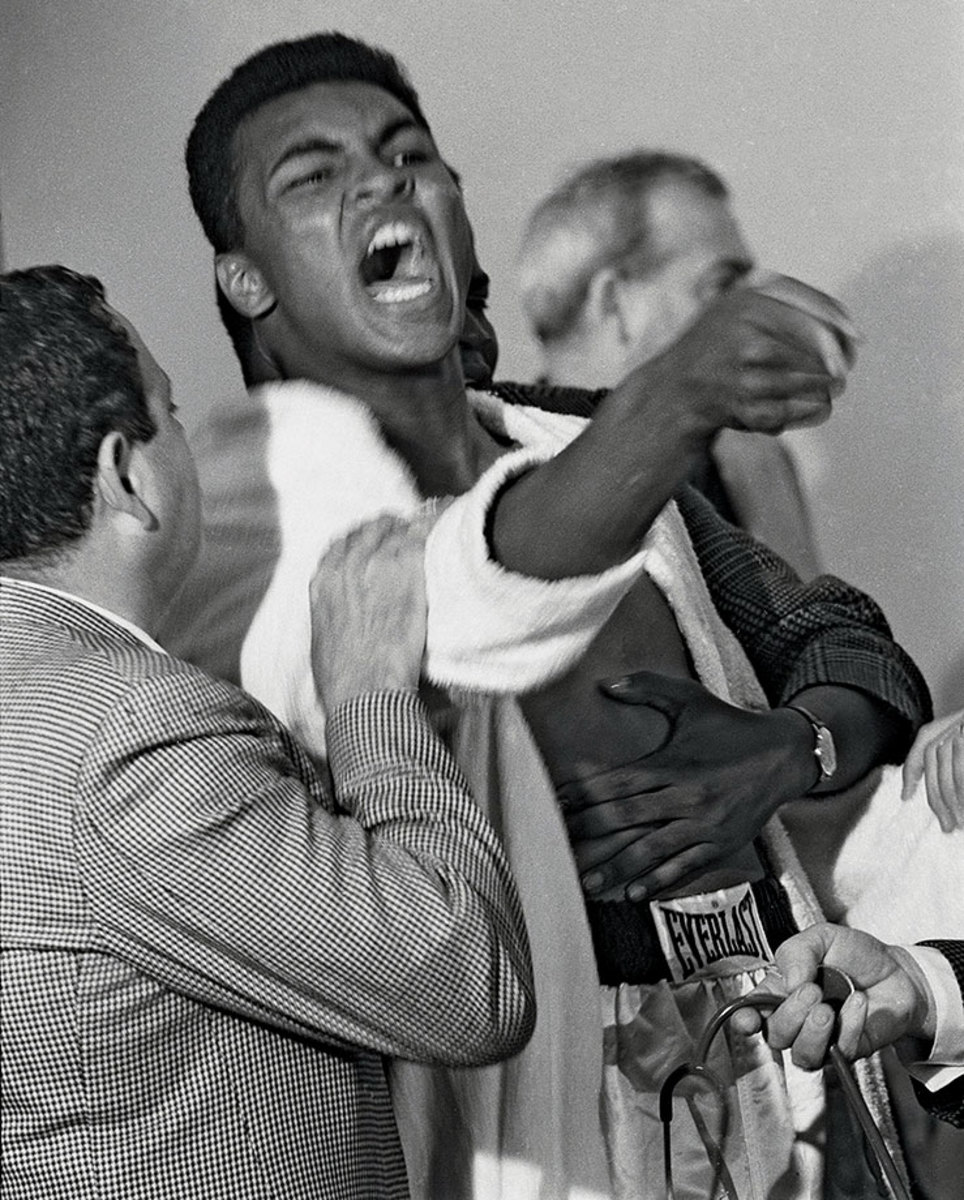
A seemingly hysterical Clay taunted Sonny Liston during the pre-fight physical for their 1964 bout. He had consistently baited the Big Bear during the lead-up to the fight, saying he was going to "use him as a bearskin rug ... after I whup him." The Miami Boxing Commission would fine Clay $2,500 for his outburst at the physical.
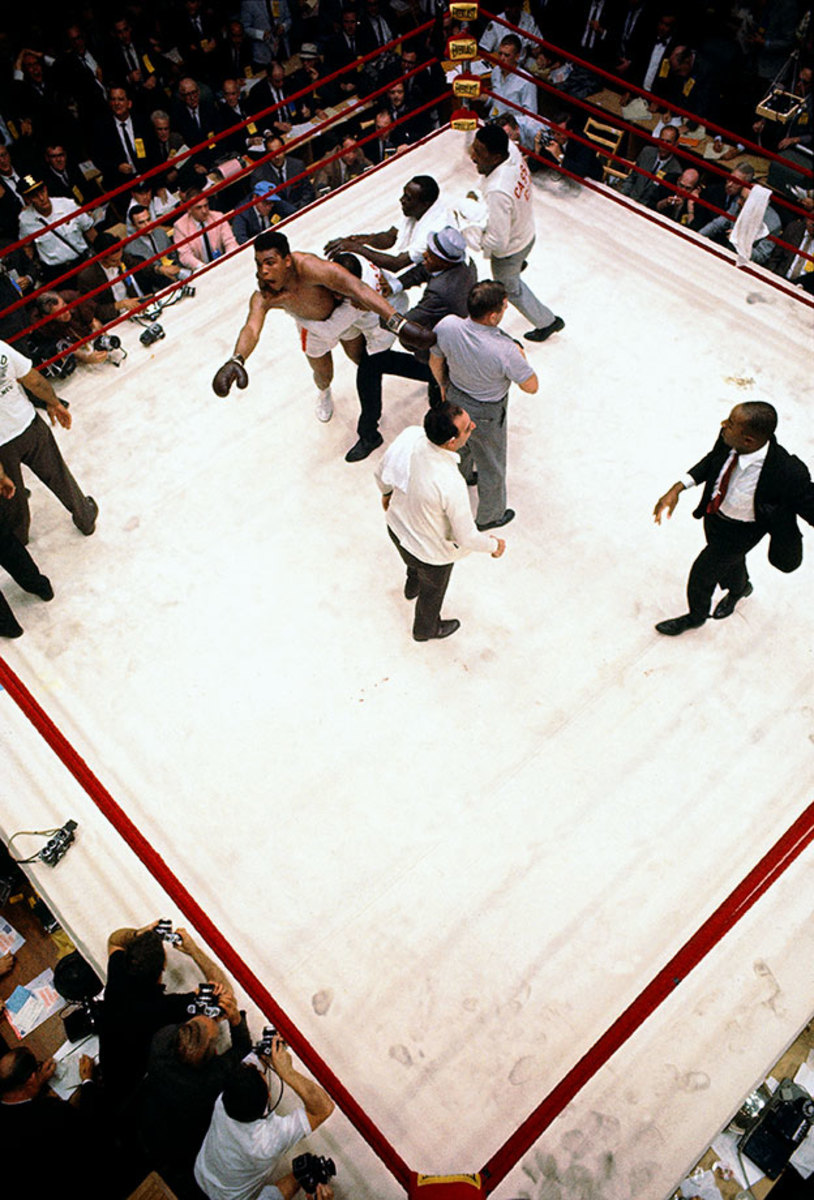
"I shook up the world!" an emotional Clay hollered to ringside reporters after his shocking defeat of Liston. And he did just that, claiming the heavyweight title at age 21 after a clearly beaten Liston, complaining of a shoulder injury, failed to answer the bell for the seventh round.
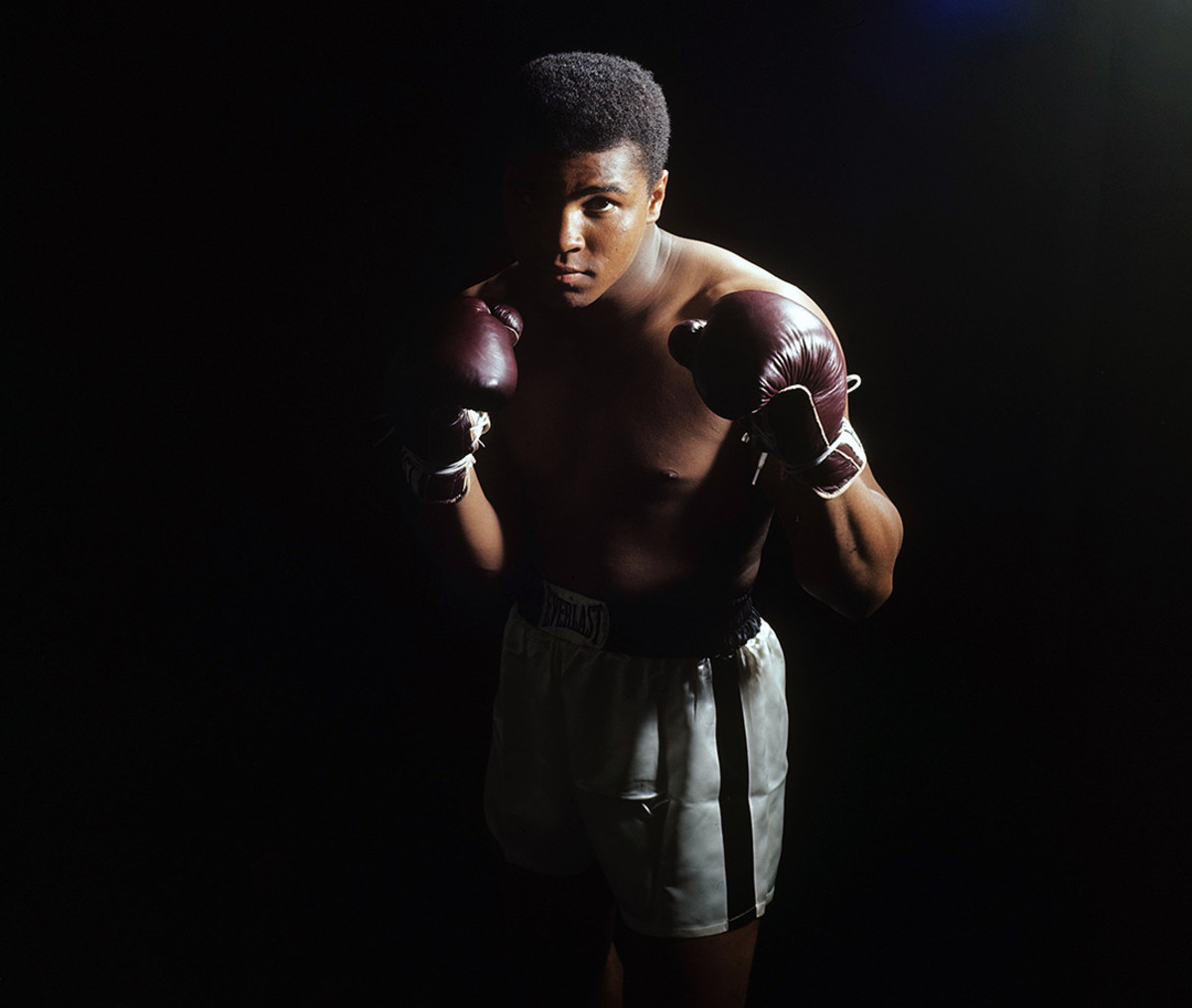
Draped in shadow, the young king — now known as Muhammad Ali — stared down the camera during a photo shoot in April 1965, one month before his rematch against Sonny Liston.
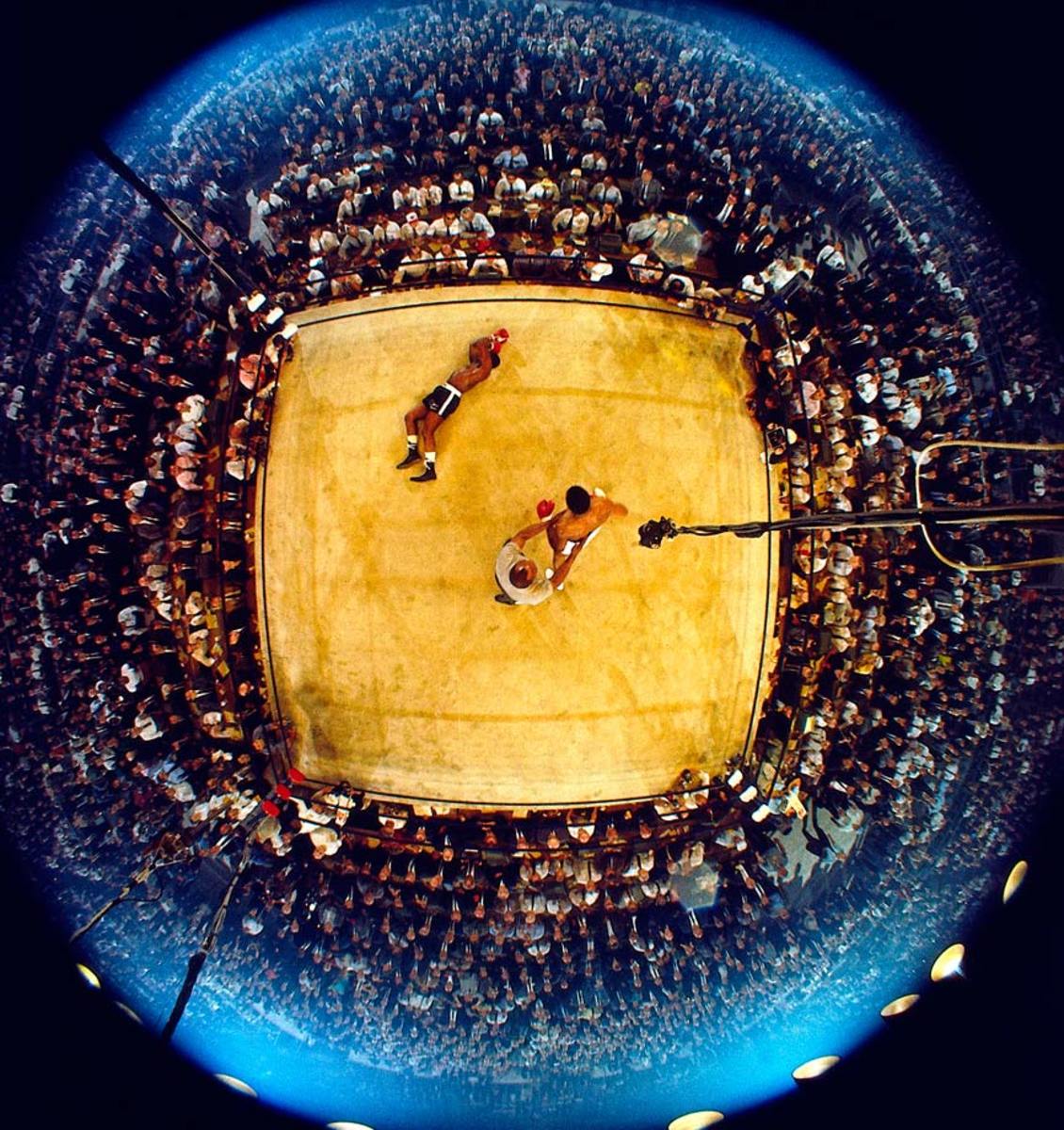
As Liston lingered on the canvas and the referee, former heavyweight champ Jersey Joe Walcott, tried to control Ali, the 2,434 spectators on hand in the Lewiston, Me., hockey arena — a record low for a heavyweight championship fight — tried to make sense of what all that had happened in less than two minutes after the opening bell.
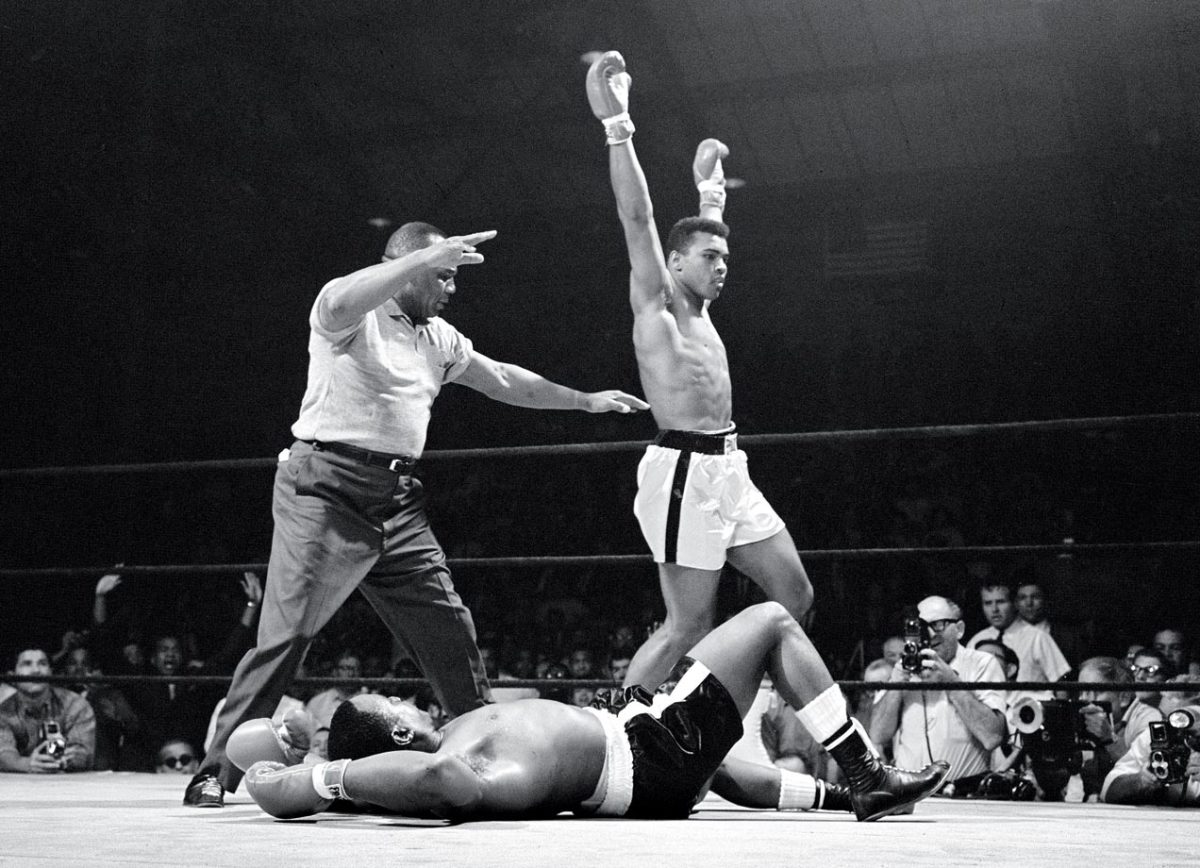
The celebration over Liston continued. In a chaotic ending, Ali was awarded a knockout when Nat Fleischer, publisher of The Ring, informed referee Jersey Joe Walcott from ringside that Liston had been on the canvas for longer than 10 seconds after Ali knocked him down. The bout remains one of the most controversial in boxing history, with many observers insisting that Liston took a dive.
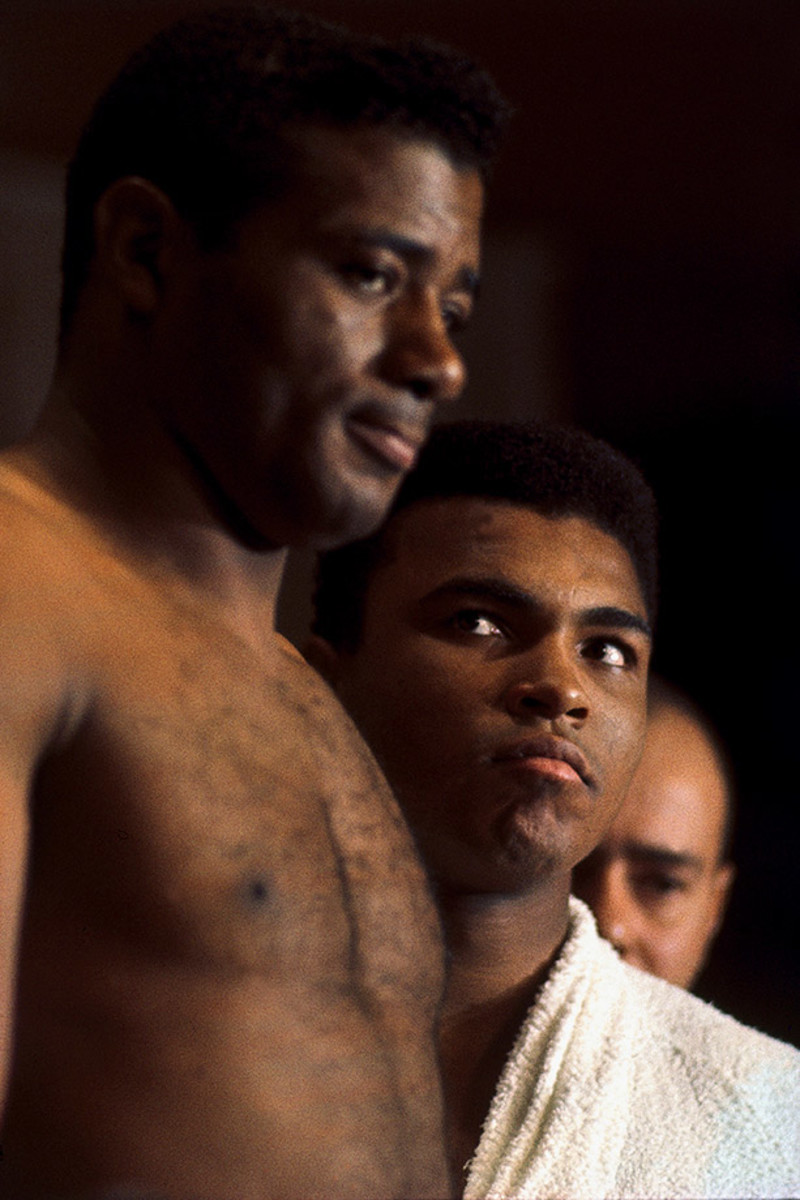
Ali's second title defense came in November 1965, against former two-time heavyweight champion Floyd Patterson. During the build-up to the bout, the normally soft-spoken Patterson earned the new champ's wrath by refusing to call Ali by his Muslim name. At the weigh-in, Ali's glare made it clear that he intended Patterson to pay for the disrespect.
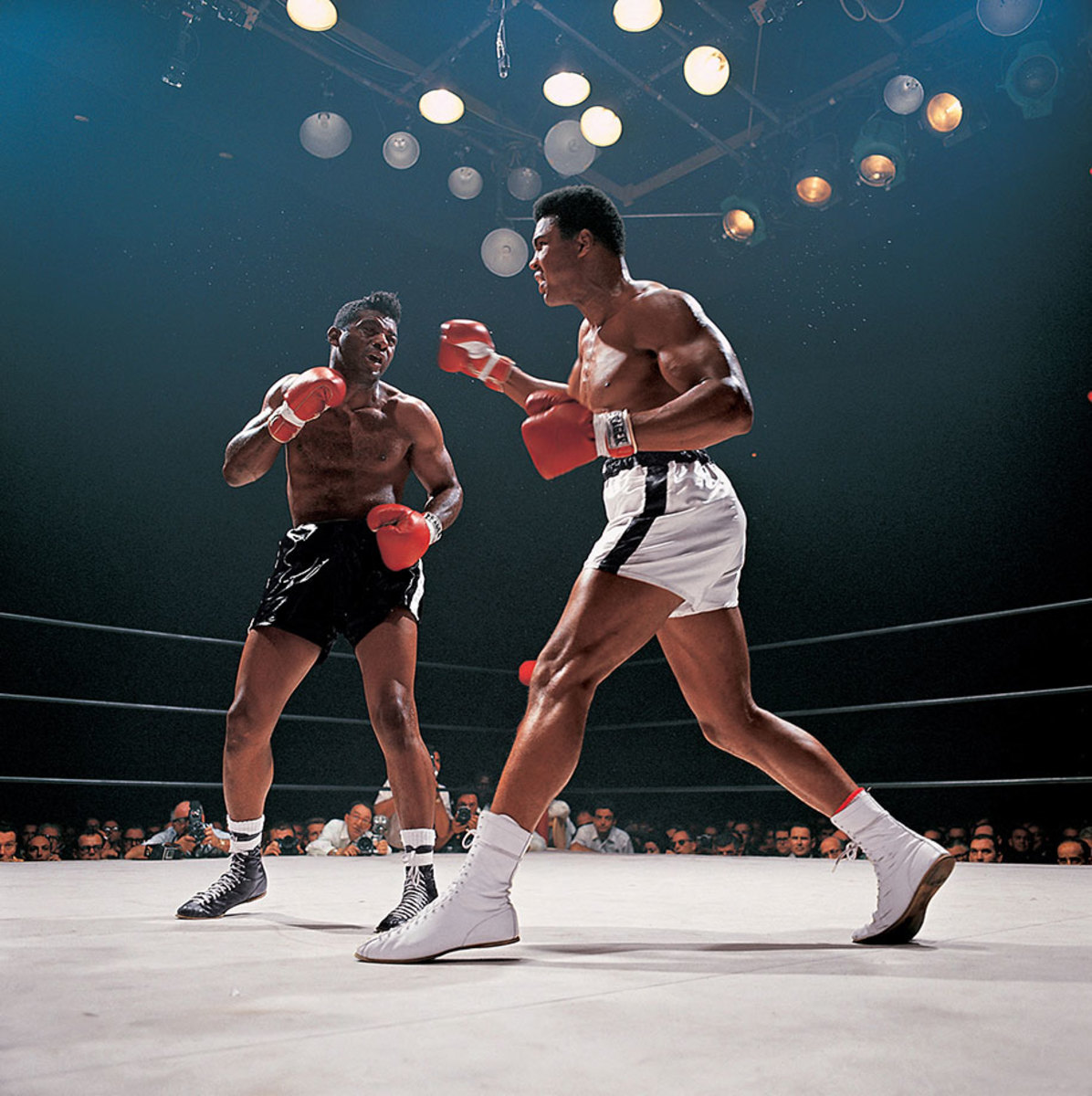
In cruelly efficient performance, Ali punished Patterson — who was hobbled by a painful back injury — seemingly toying with the former champ throughout the bout, hitting him at will and calling, "What's my name?" before finally winning on a 12th-round TKO.
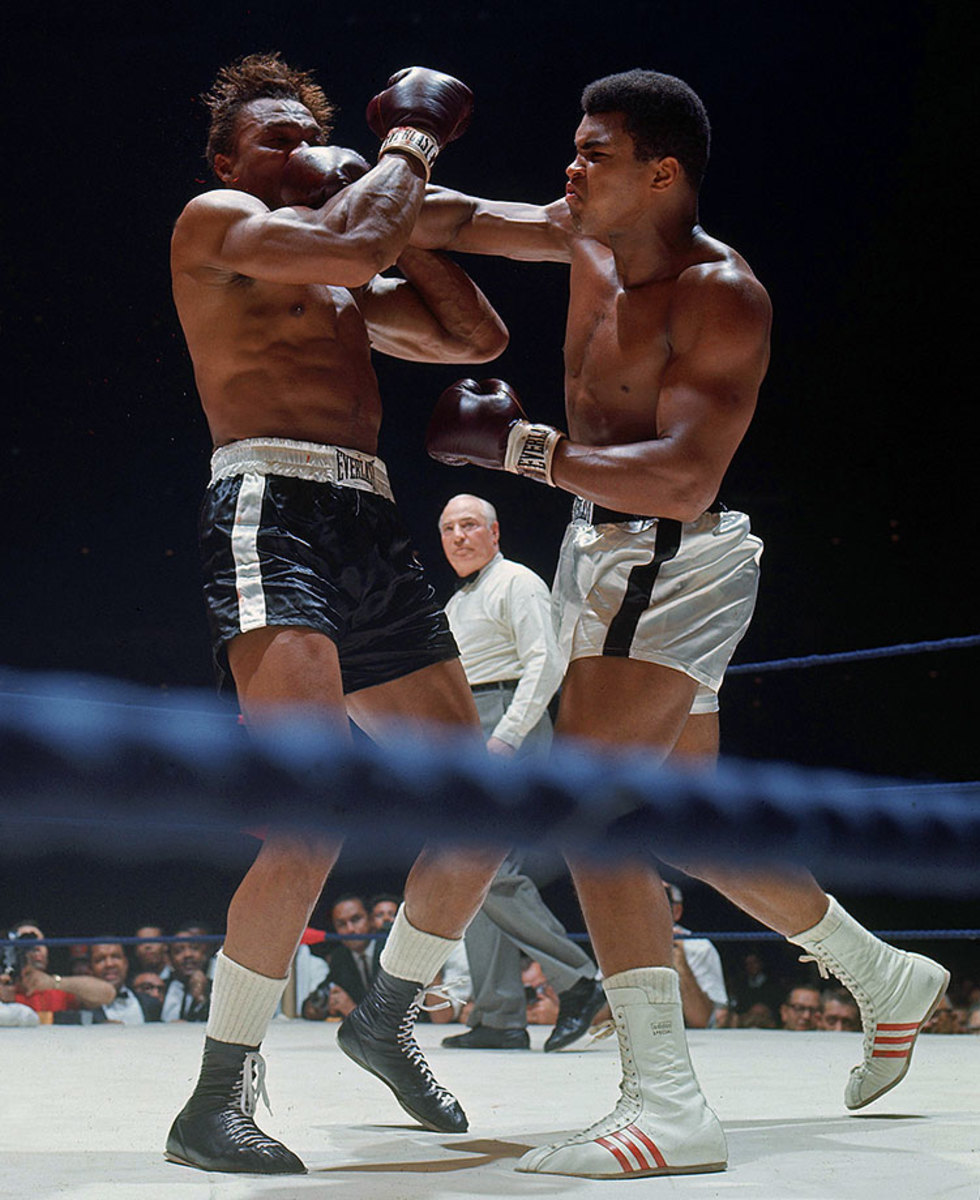
Capping off a five-fight campaign in 1966, Ali faced Cleveland Williams in the Houston Astrodome on Nov. 14. Known as the Big Cat, the heavily-muscled Williams was a power puncher who had racked up 51 knockouts in 71 fights. But he was also 33, barely recovered from a gunshot wound sustained the year before, and up against a young champion very much in his prime. Ali wasted little time in unleashing a withering attack.
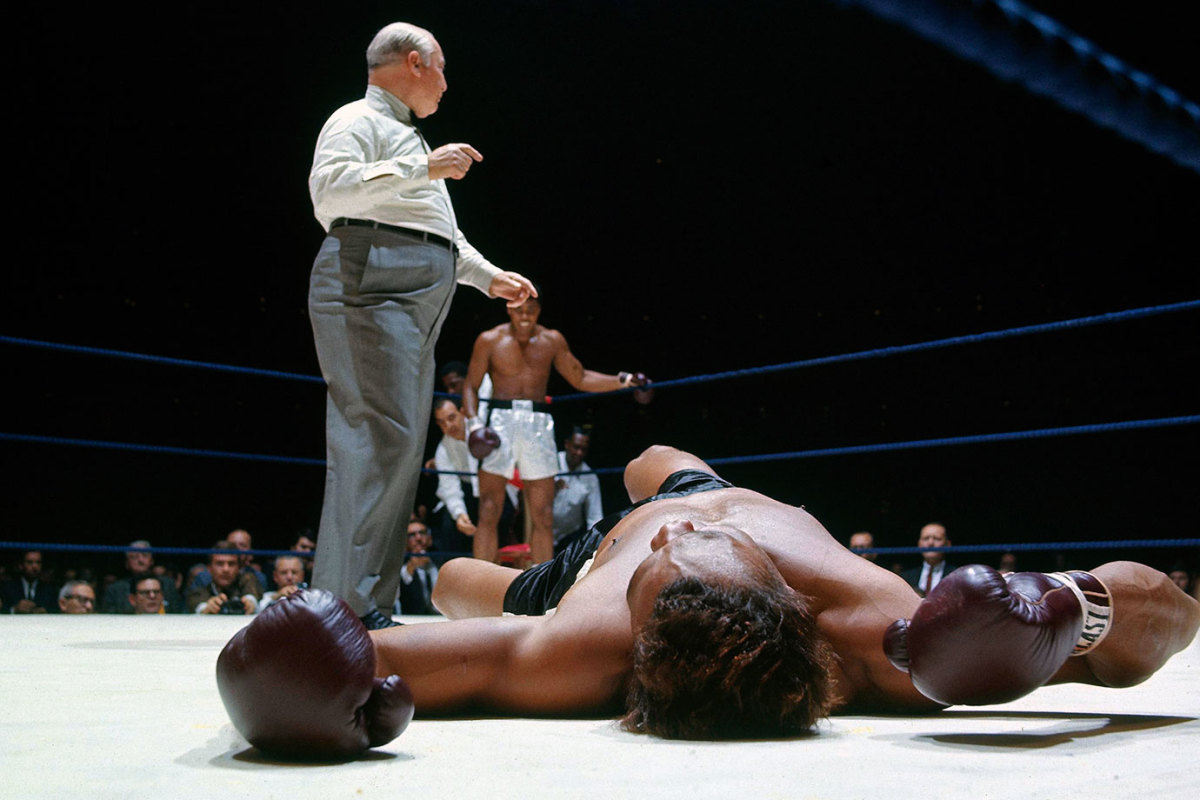
Float and sting: In a display of speed and combination punching unmatched in heavyweight history, Ali overwhelmed Williams from the start. The challenger, here down for the third time in round 2, would be saved by the bell before referee Harry Kessler could count him out, but it would only postpone the inevitable.
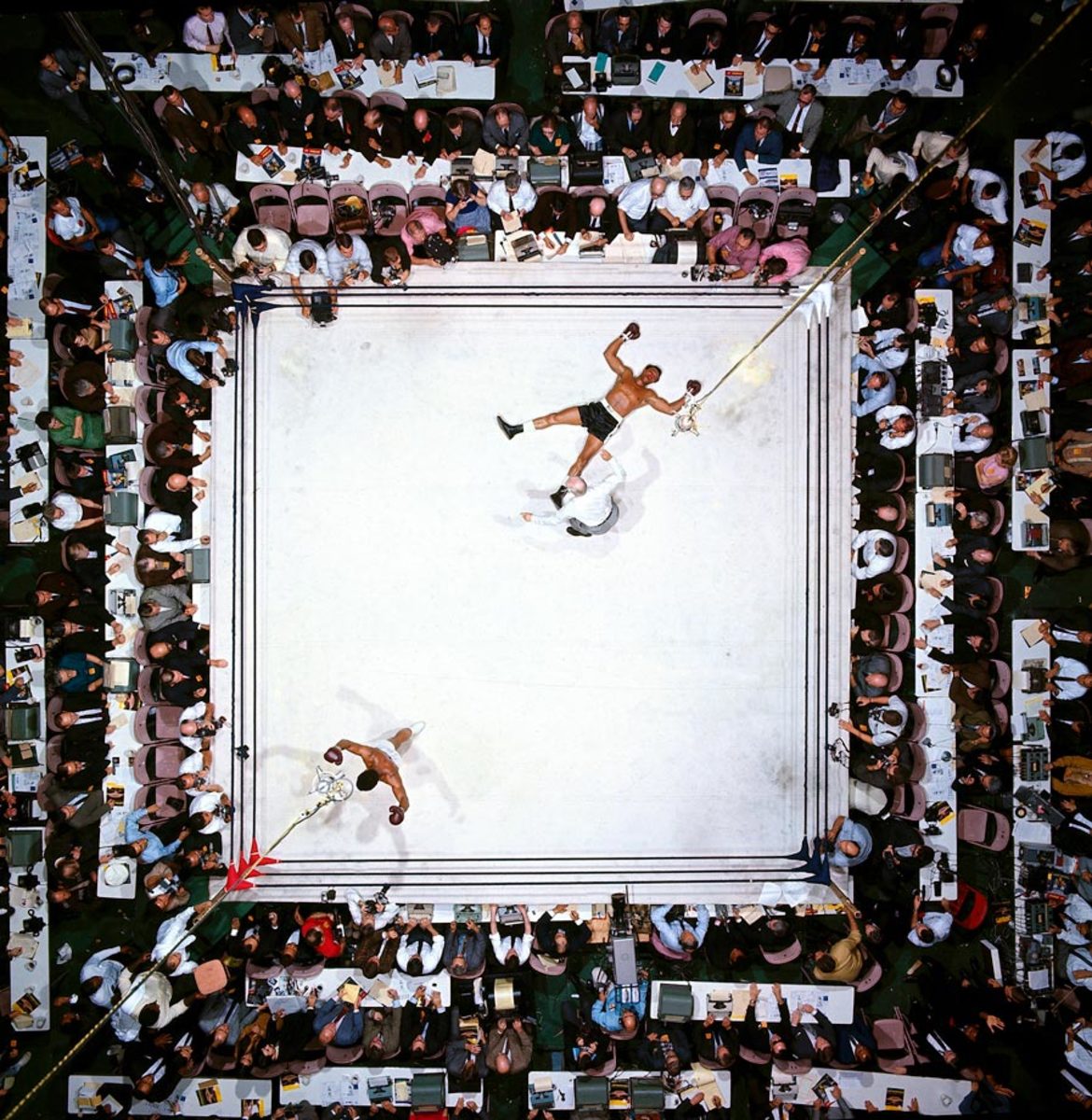
Ali dropped Williams again early in the third round, and Kessler waved the mismatch over at 1:08 of the third.
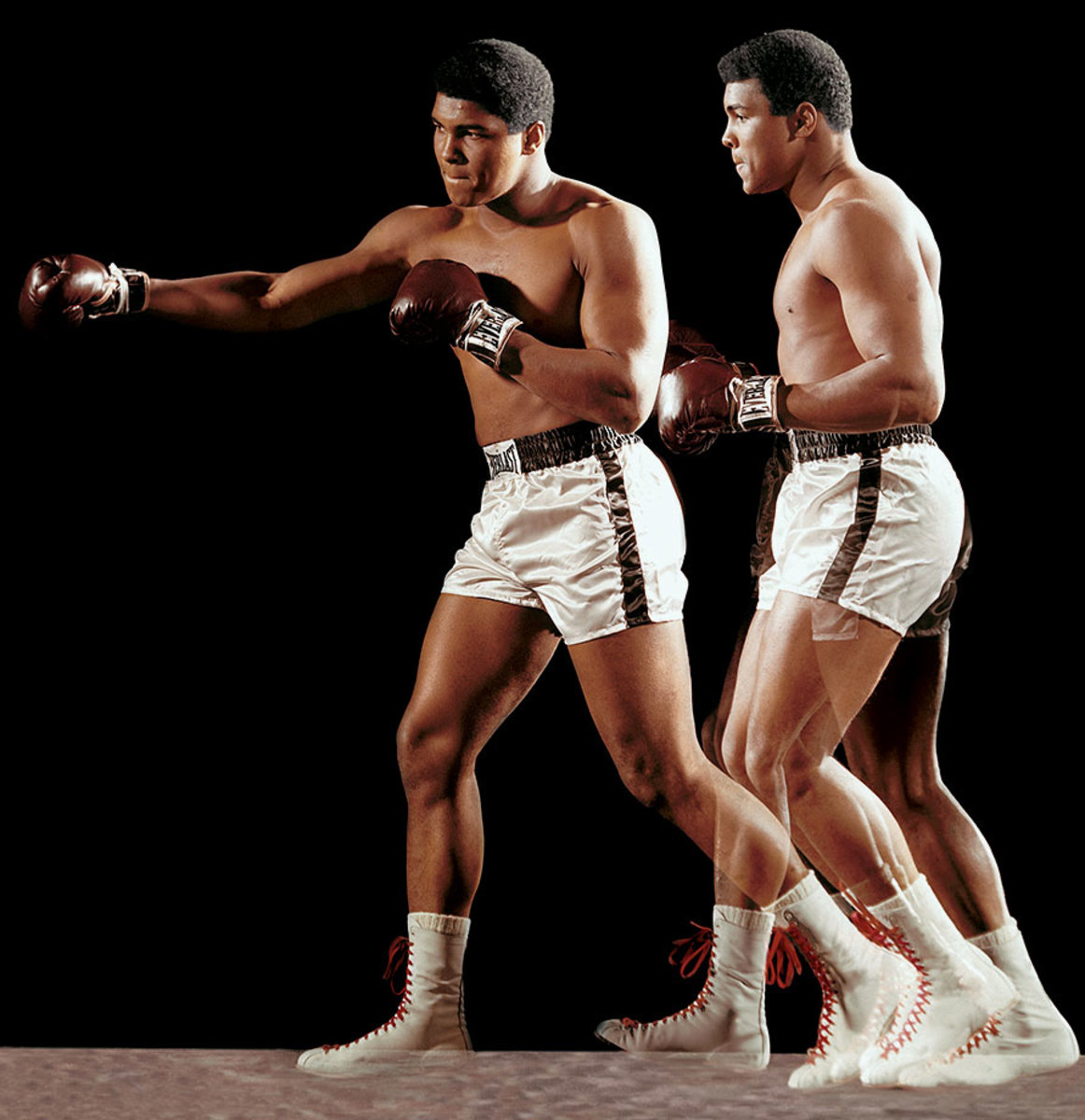
In a multiple-exposure portrait, Ali demonstrates his signature double-clutch shuffle during a photo shoot in December 1966.
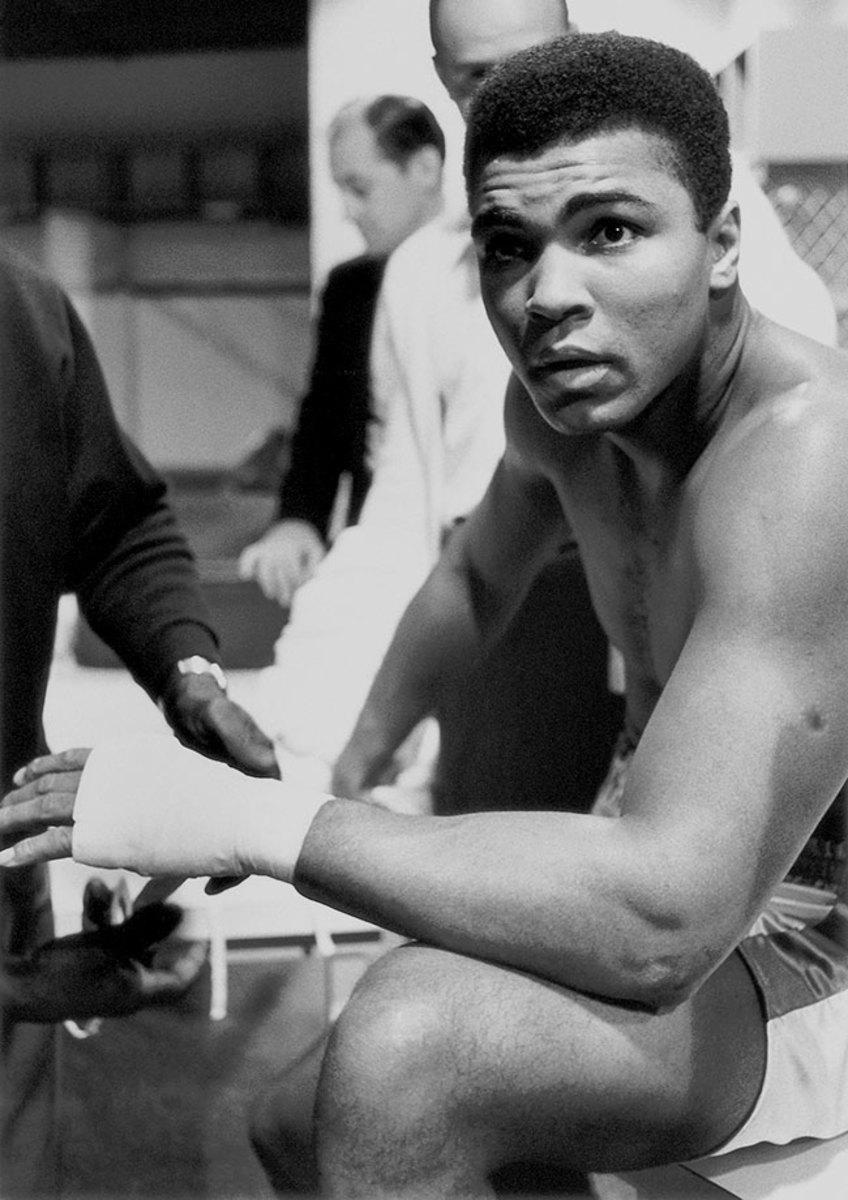
Ali sits in the locker room before his February 1967 fight against Ernie Terrell. Like Patterson before him, Terrell refused to call the champion by his Muslim name. Also like Patterson, he paid a stiff price, as Ali punished Terrell for 15 ugly rounds before winning by unanimous decision.
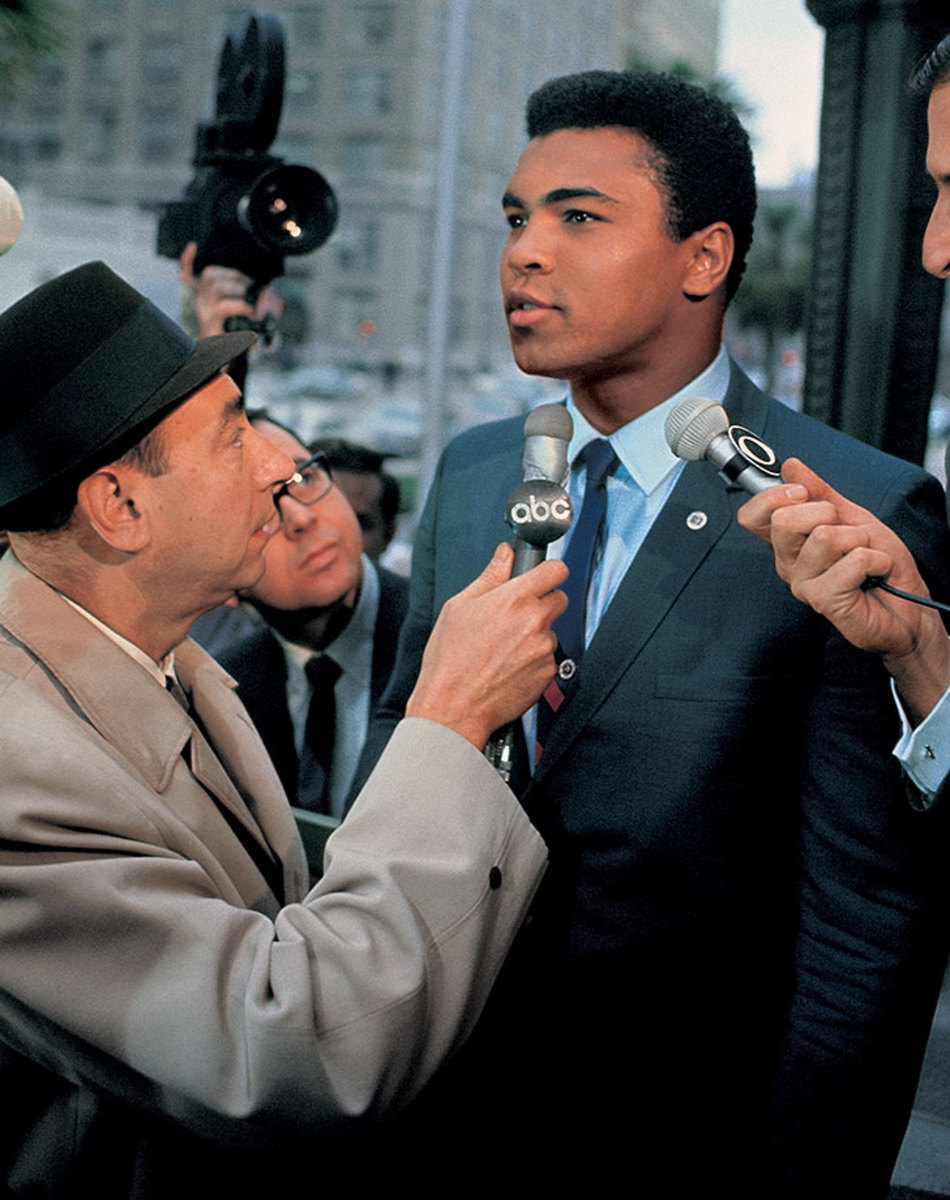
Outside the Armed Forces Examining and Entrance Station in Houston in April 1967, Ali spoke to the press about his refusal to be inducted into military service. Among those on hand was ABC's Howard Cosell, who would be a staunch supporter of the fighter's stance. The decision cost Ali his boxing license and his heavyweight title, and he was sentenced to five years in prison but remained free pending an appeal.
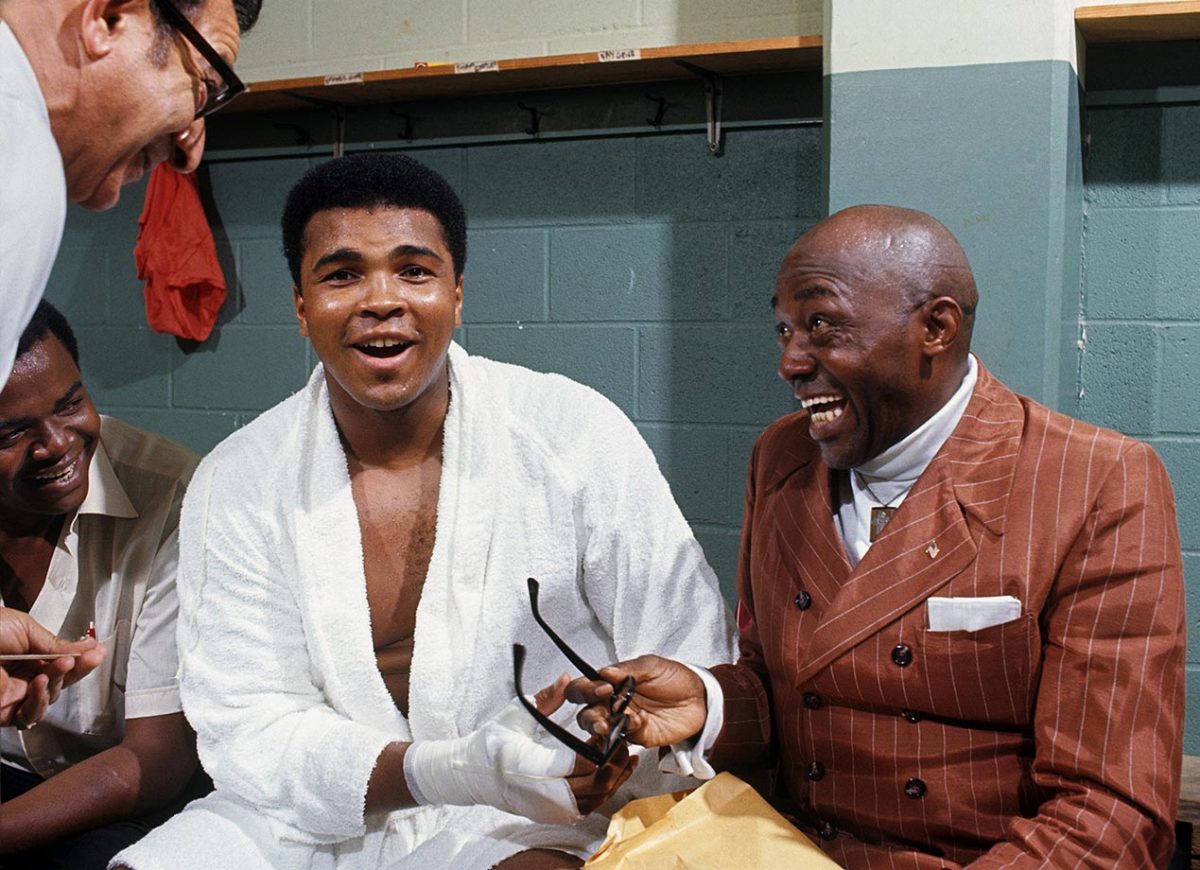
In professional exile for three and a half years because of his draft case, Ali sought to return to boxing in 1970. He began with a night of exhibition bouts at Morehouse College in Atlanta, where before going into the ring, he shared a locker room laugh with actor and comedian Lincoln Perry (right), better known by his stage name of Stepin Fetchit. The friendship between the two black icons would later be examined in an acclaimed play by Will Power, Fetch Clay, Make Man.
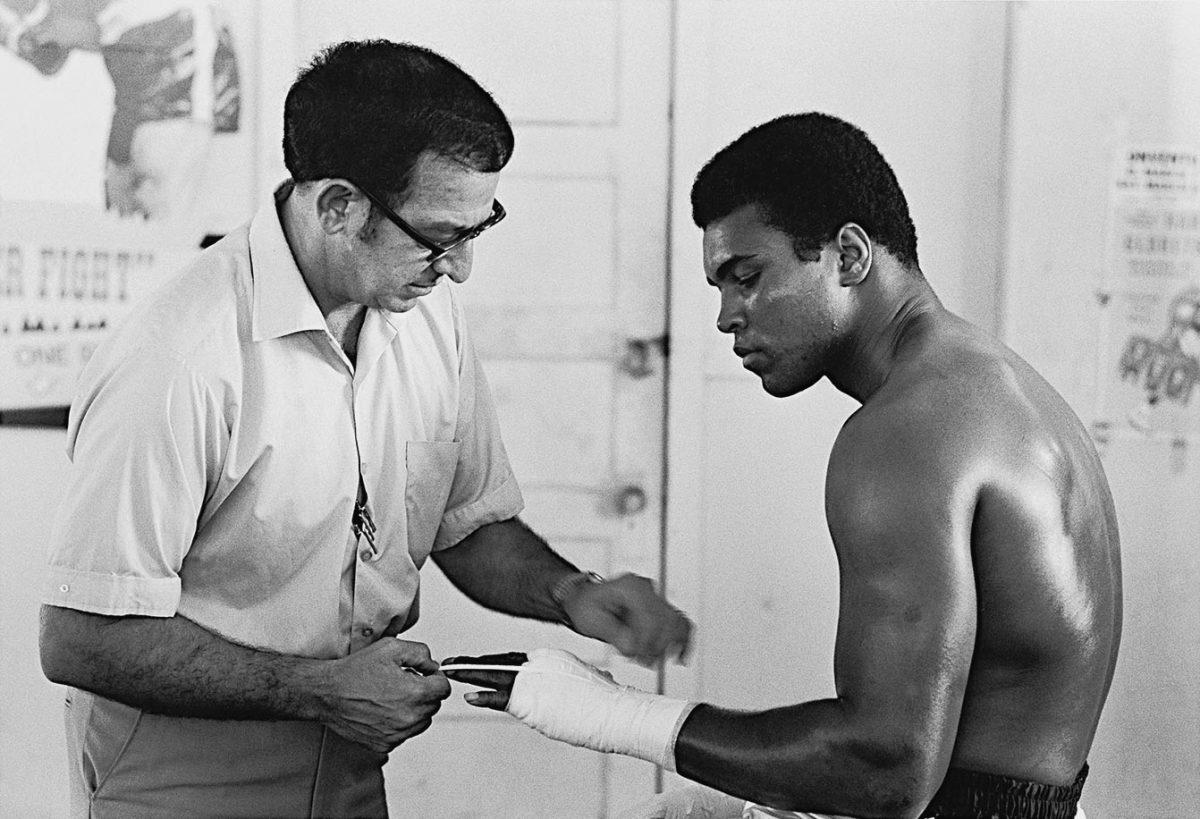
After the Atlanta Athletic Commission at last granted Ali a license, the deposed champion went back into serious training. He was, as ever, in the capable hands of trainer Angelo Dundee, here wrapping boxing's most famous fists at the 5th Street Gym in Miami in October 1970.
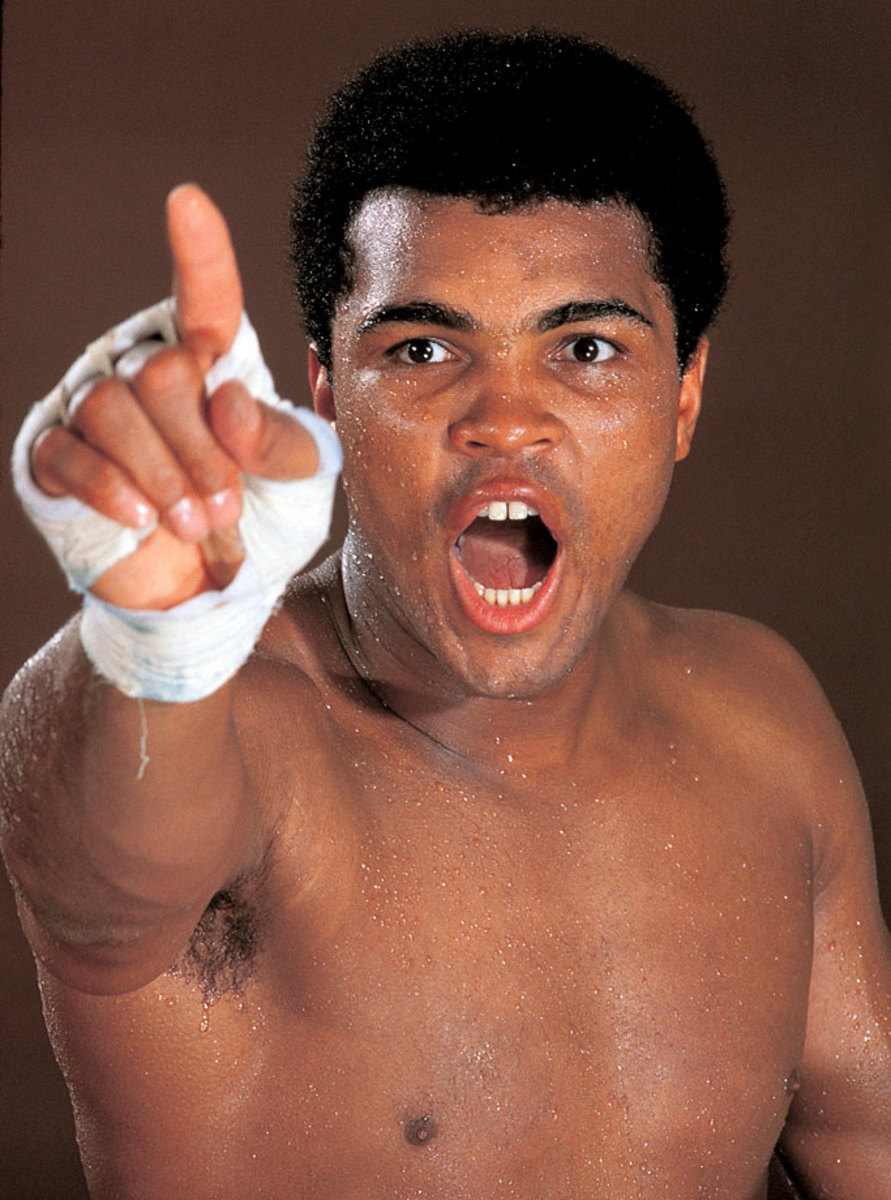
With his return to the ring scheduled for Oct. 26, 1970 in Atlanta, against dangerous contender Jerry Quarry, Ali made it clear to all who would listen that he was on a mission to reclaim the title that had been stripped of him.
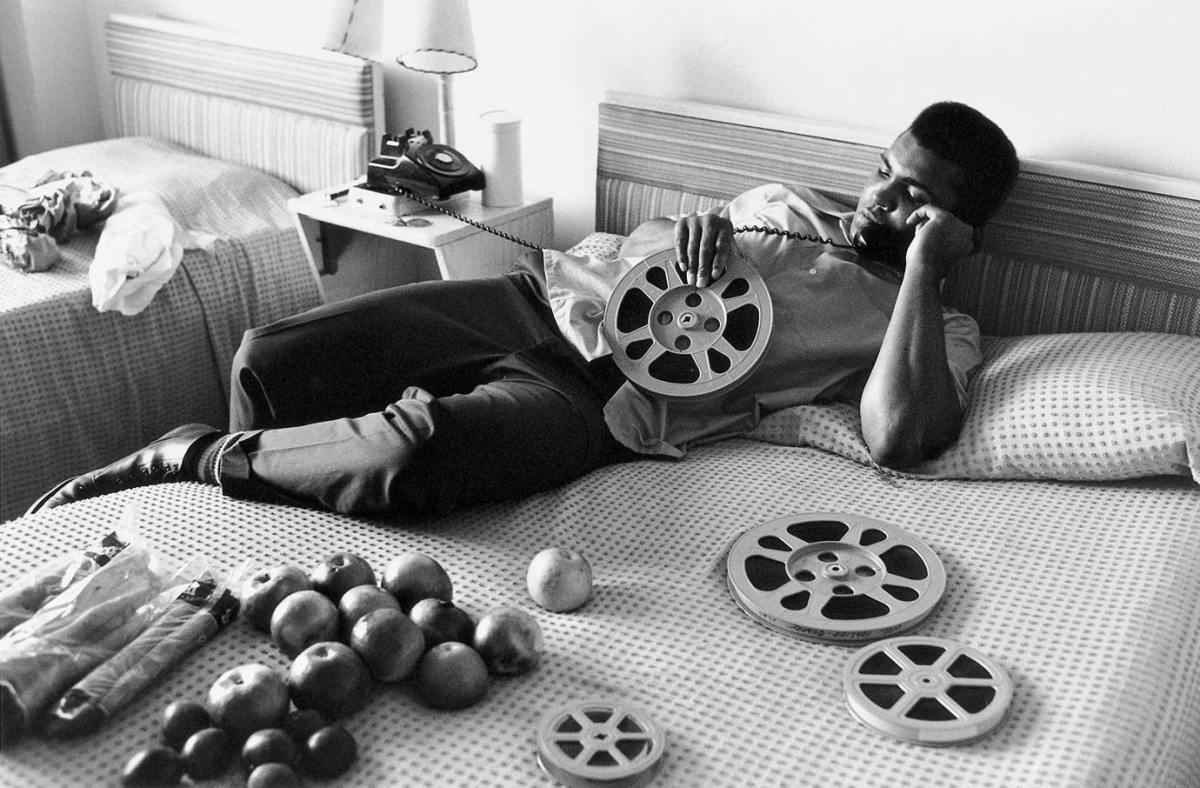
Reel to spiel: For the ever-loquacious Ali, even a rare moment of down time — like this afternoon in 1970 in a Miami hotel room — was a chance to do some talking.
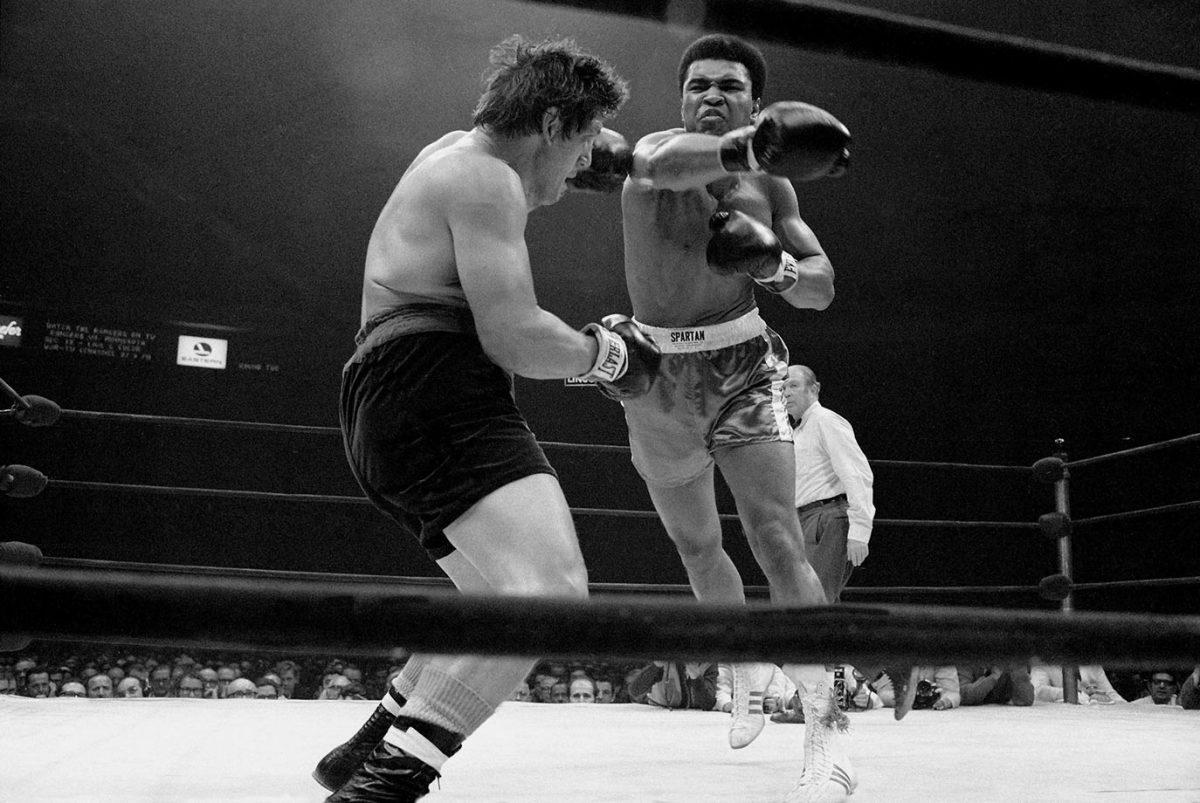
Despite Ali's long layoff, his comeback campaign would include no easy tune-up bouts. He stopped Quarry in three rounds on Oct. 26, 1970, then, just six weeks later — an unthinkably short interlude by today's standards — took on Argentine contender Oscar Bonavena in Madison Square Garden. Here, Ali fires a right at the rugged and awkward Bonavena, who took the fight to the former champion all night.
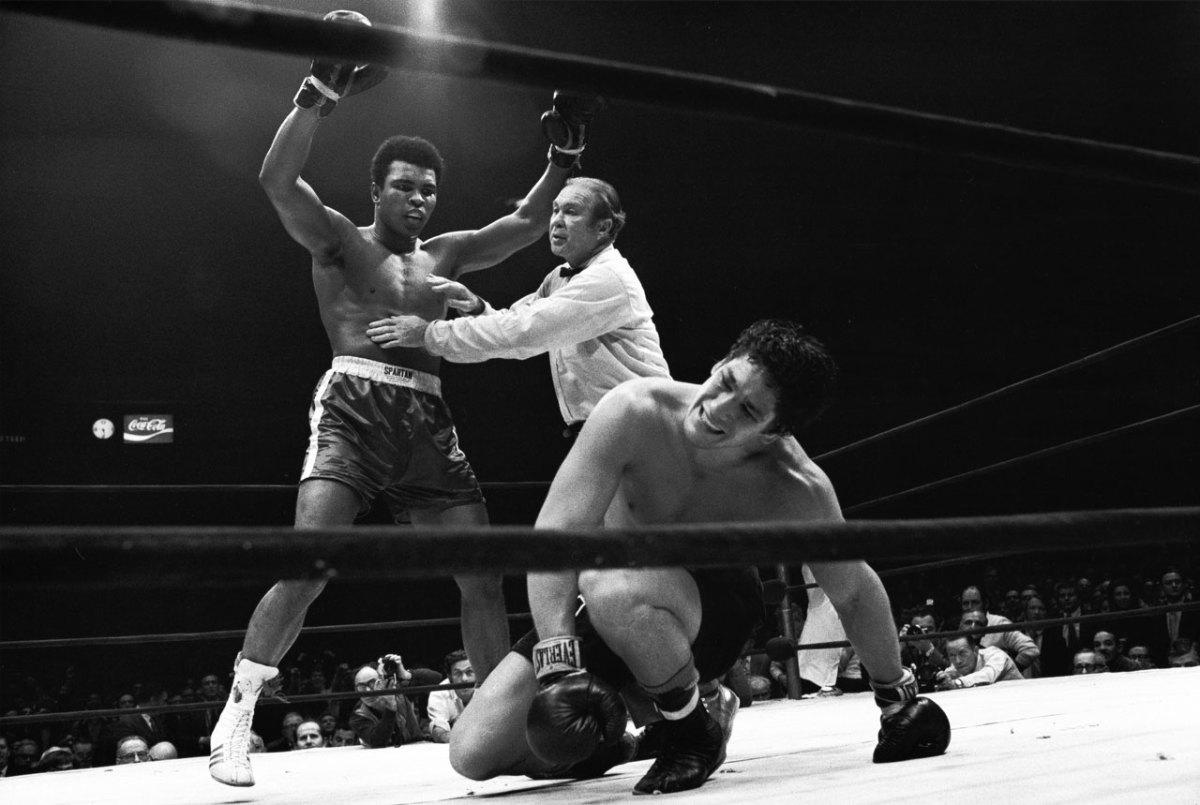
After a long, often sloppy bout, Ali — here being held back by referee Mark Conn — produced one of the most dramatic finishes of his career, dropping Bonavena three times in the 15th and final round to automatically end the fight. The win cleared the way for a showdown with Joe Frazier, the man who had taken the heavyweight title in Ali's absence.
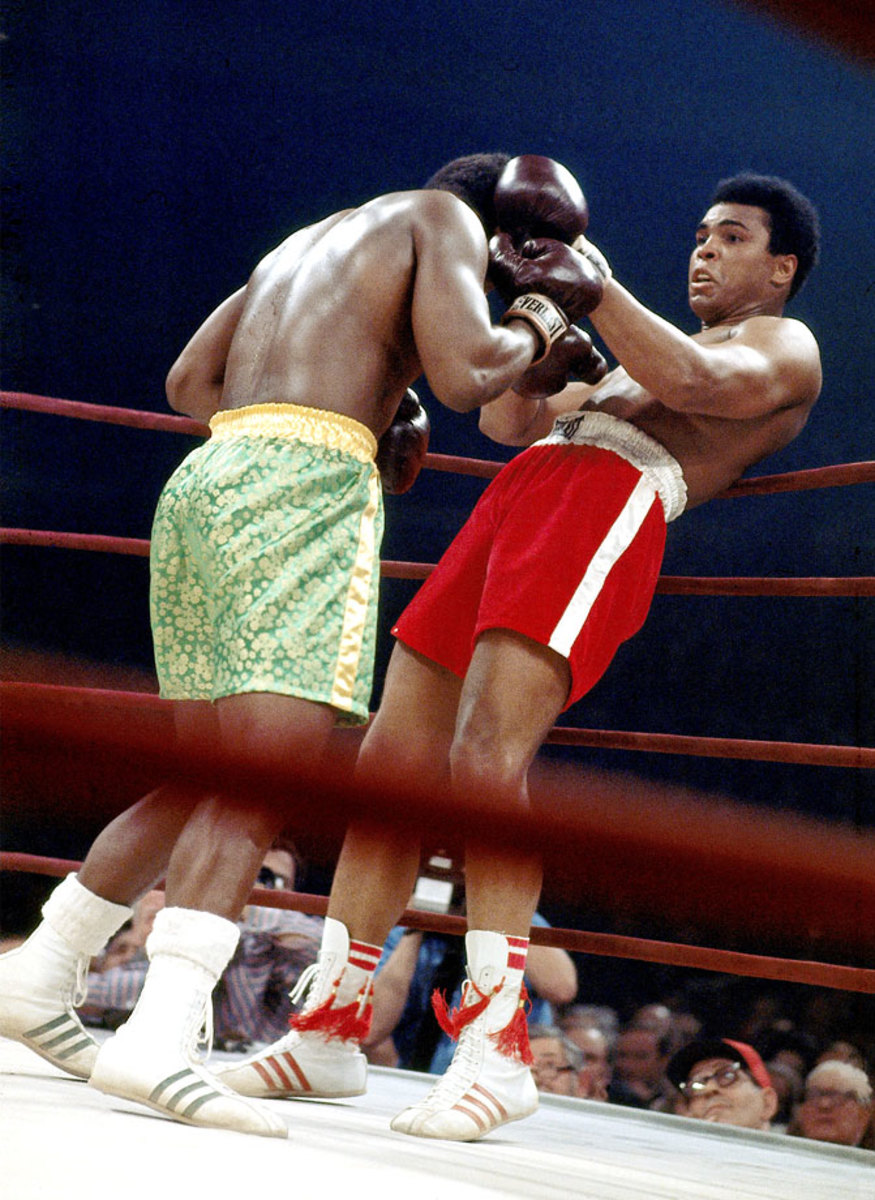
On the night of March 8, 1971, the eyes of the world were on a square patch of white canvas in the center of Madison Square Garden. There, Ali and Joe Frazier met in what was billed at the time simply as The Fight, but has come to be known, justifiably, as the Fight of the Century. For 15 rounds the two undefeated heavyweights battled at a furious pace, with each man sustaining tremendous punishment. In the end Frazier prevailed, dropping Ali in the final round with a tremendous left hook to seal a unanimous decision and hand The Greatest his first loss in 32 professional fights.
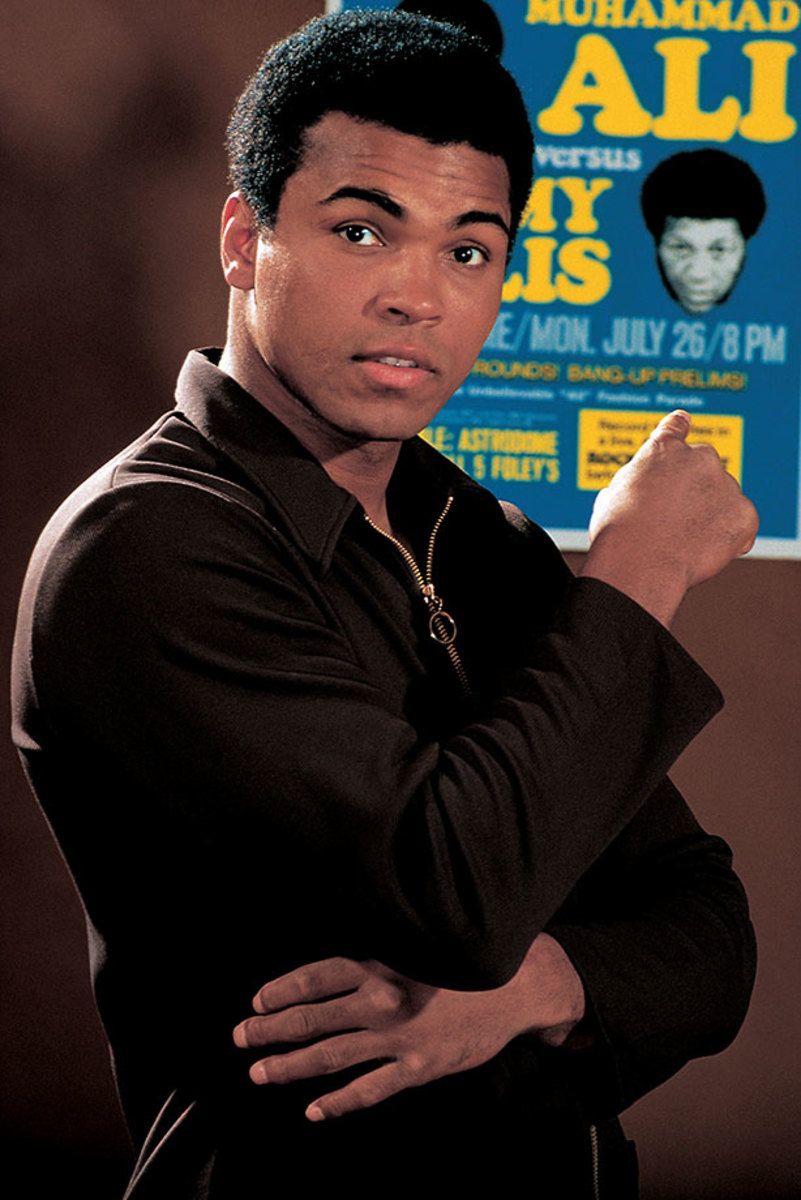
Ali poses with the fight poster for his upcoming fight against Jimmy Ellis during a photo shoot in July 1971. Ellis was an old friend of Ali's — both were trained by Angelo Dundee — and knew his fighting style well from many rounds of sparring.
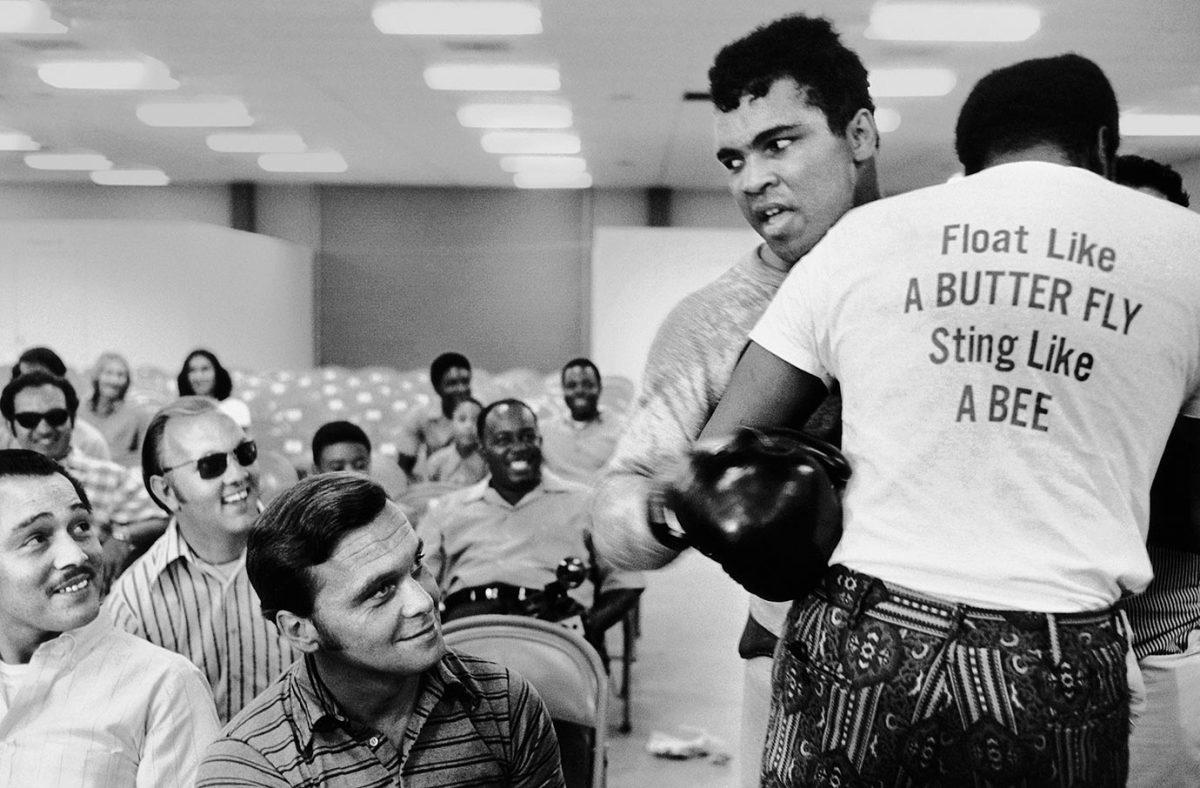
For those sportswriters lucky enough to cover Ali on a regular basis, each day brought surprises and, more often than not, plenty of laughs. of Trainer Drew Bundini Brown helps Ali train for his fight against Ellis. Ali won the bout by technical knockout in the 12th round to claim the vacant NABF heavyweight title.
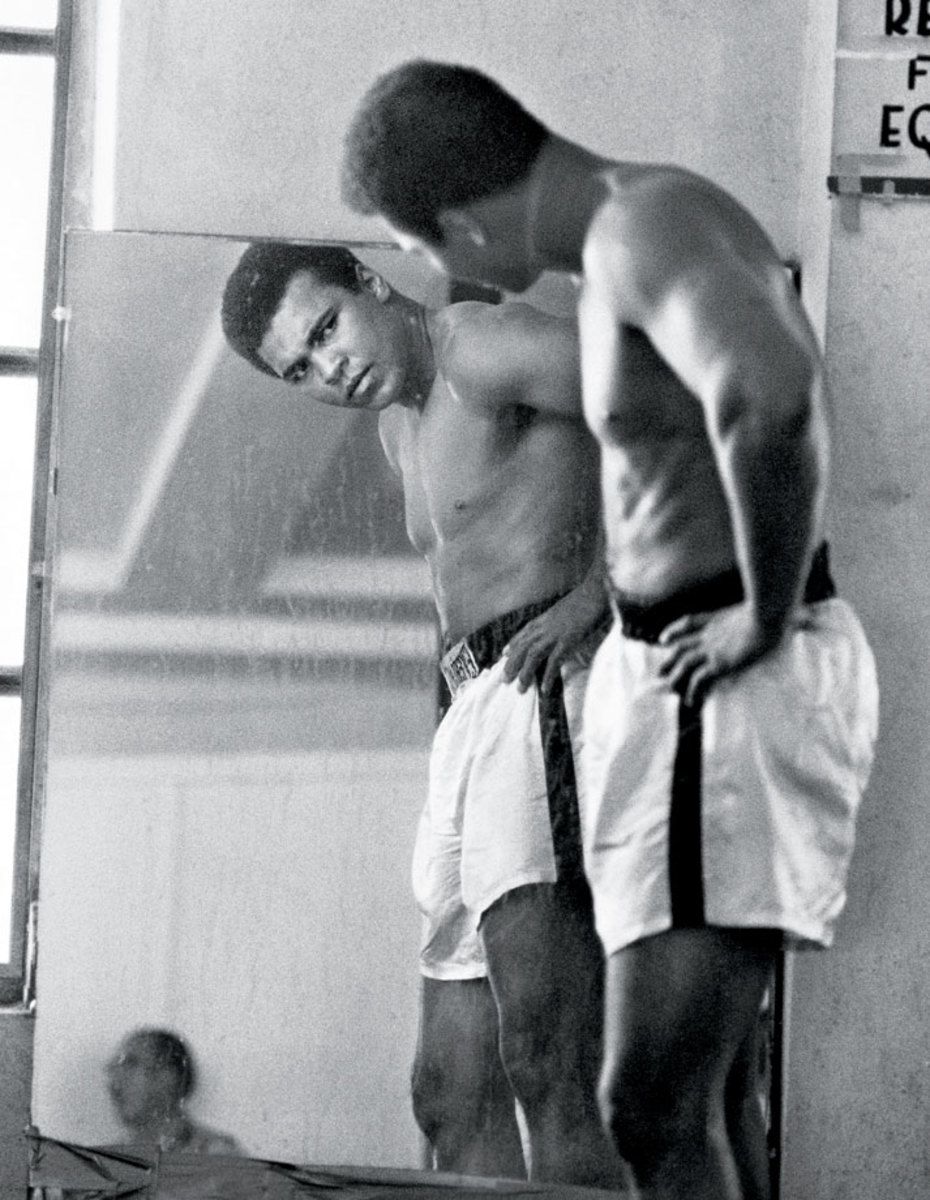
The man in the mirror stares back as Ali examines himself while training for a fight in 1972. He won all six of his fights that year.

The Louisville Lip stands next to George Foreman before Ali's fight versus Jerry Quarry in June 1972. Ali won by technical knockout in the seventh round. Foreman at the time was 36-0. Ali would not get his shot against Foreman for more than two years.
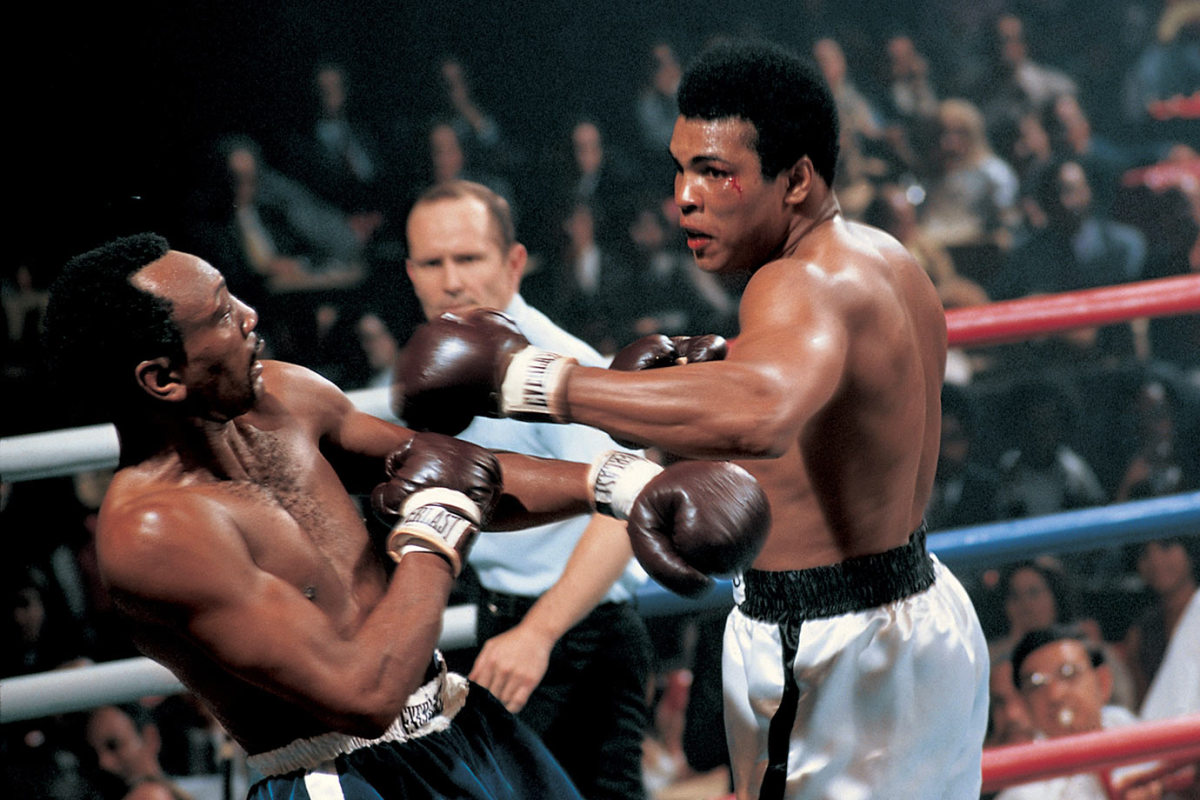
Ali throws a left hook at Bob Foster in their 1972 fight at Stateline, Nev. Although Ali knocked Foster out, Foster did leave his mark: a cut above Ali's left eye, his first as a professional.
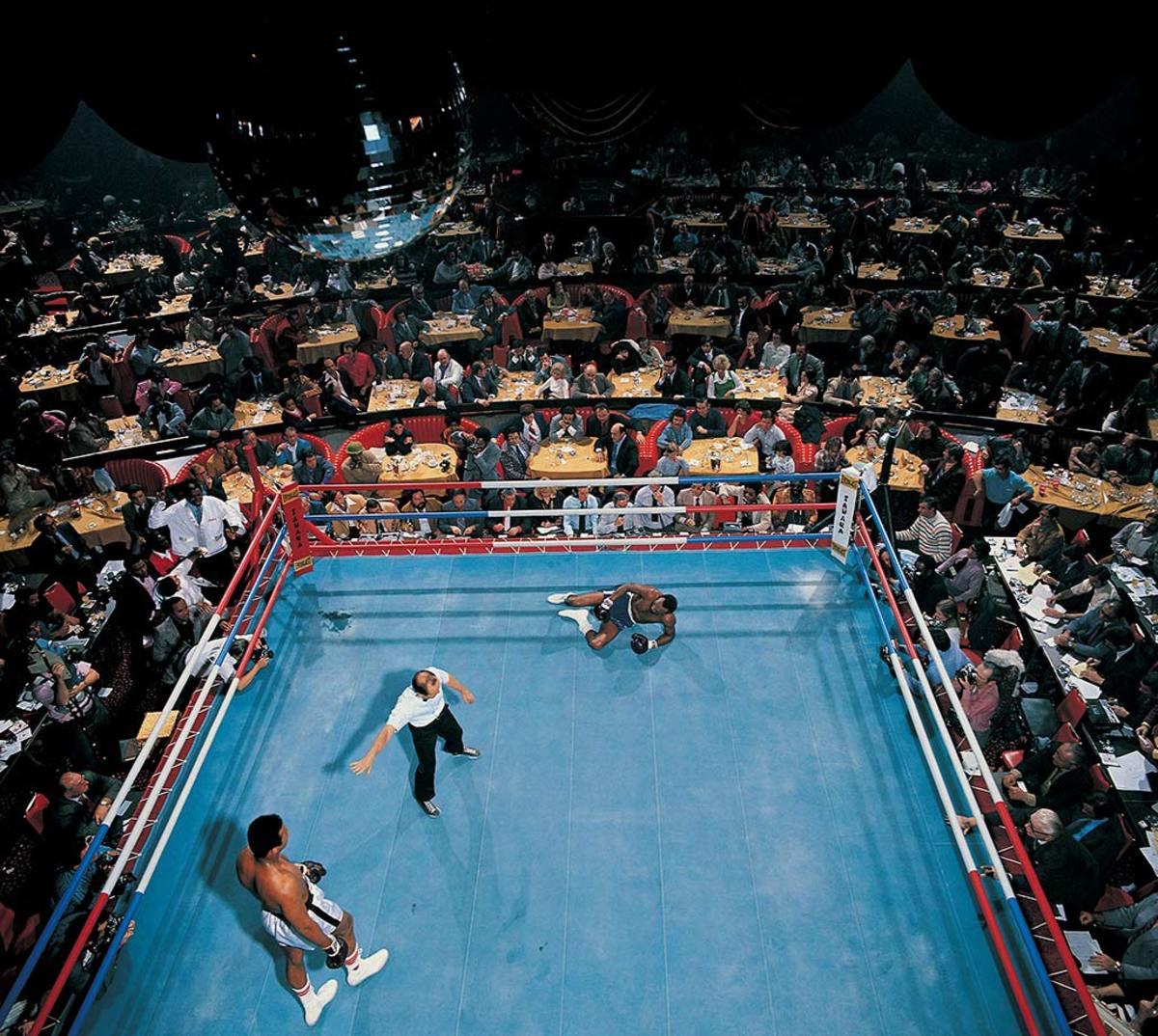
Foster lies on the canvas after getting knocked down by Ali. Ali knocked Foster down four times in the fifth round and twice more in the seventh round before he was finally counted out after Ali knocked him down again in the eighth round.
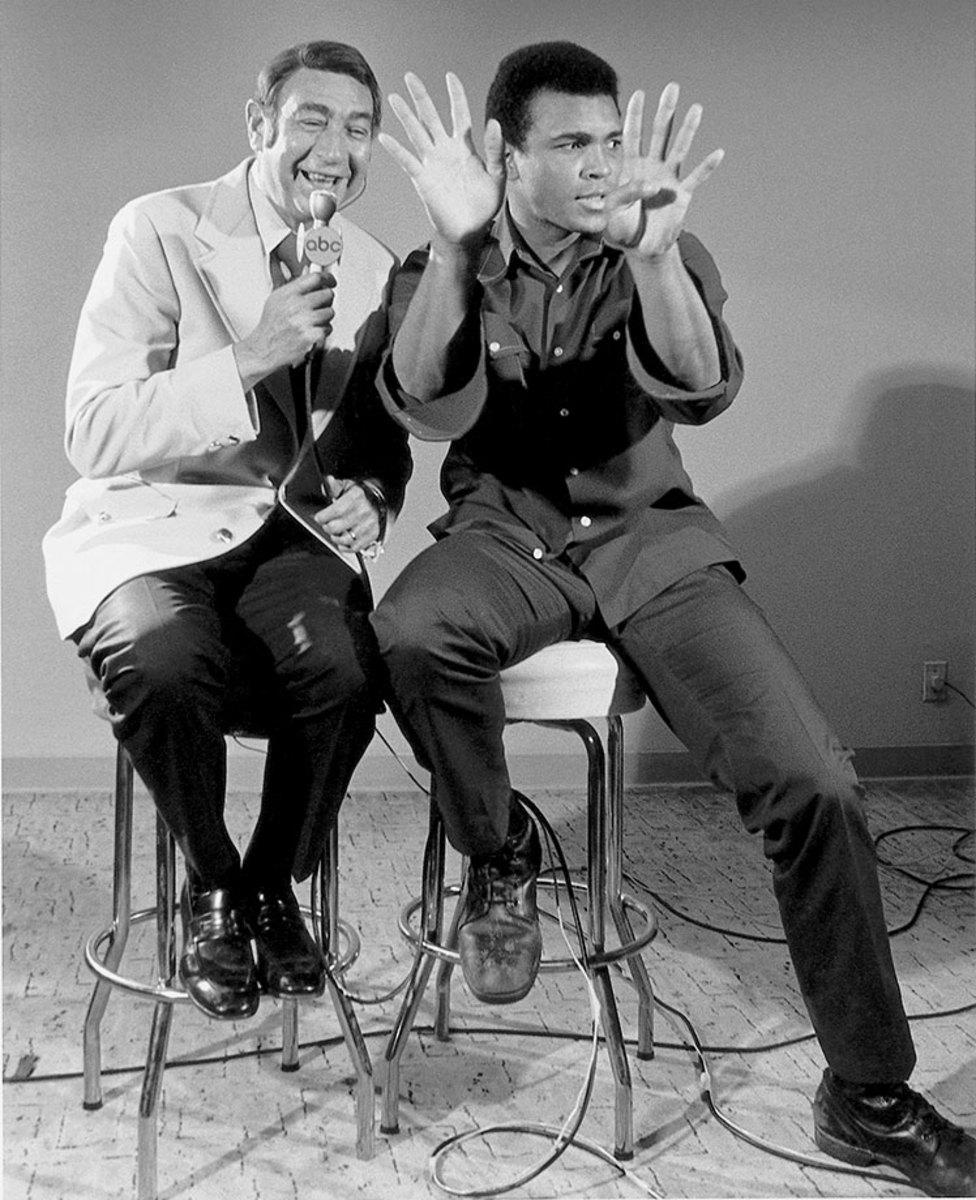
Ali sits with sportscaster Howard Cosell before his fight with Joe Bugner in February 1973. Although unable to knock Bugner out, Ali won comfortably by unanimous decision.
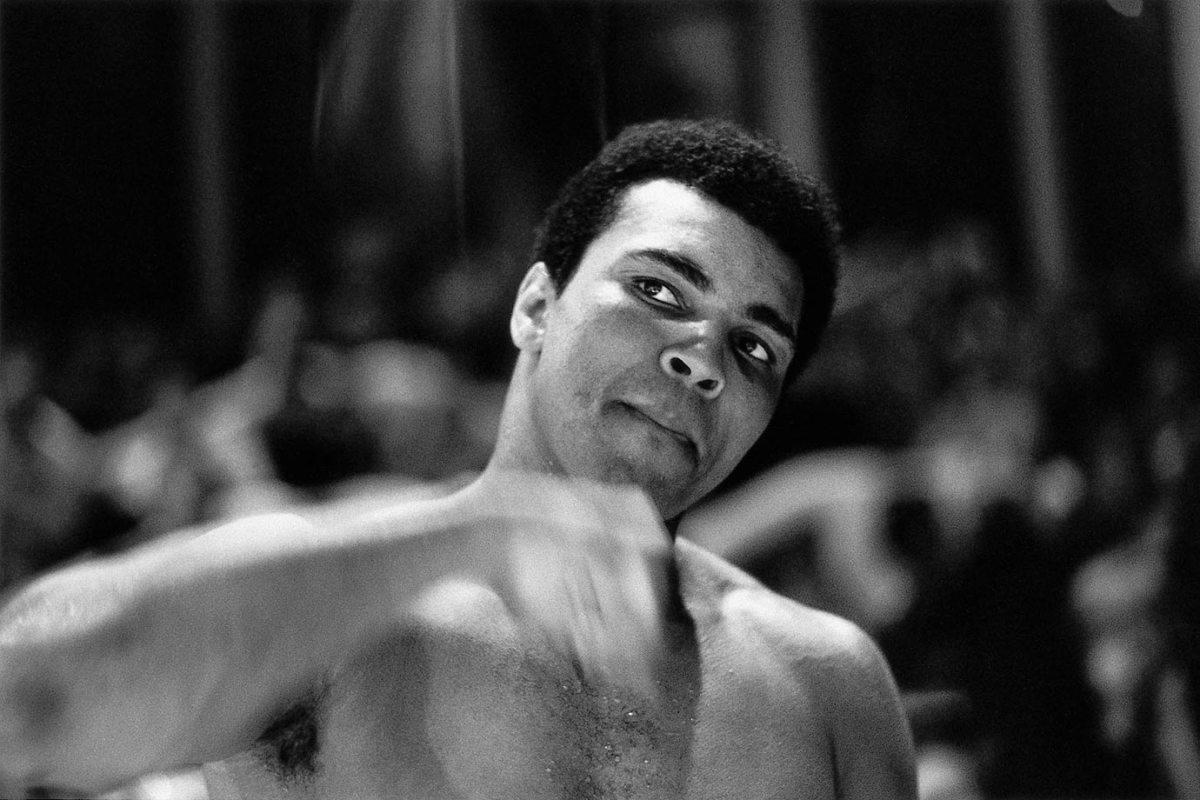
Ali hits a speed bag while warming up for his bout with Bugner in Las Vegas. Ali prepared ferociously for the fight, training 67 rounds the week leading up to the fight, including six rounds the day before the fight.
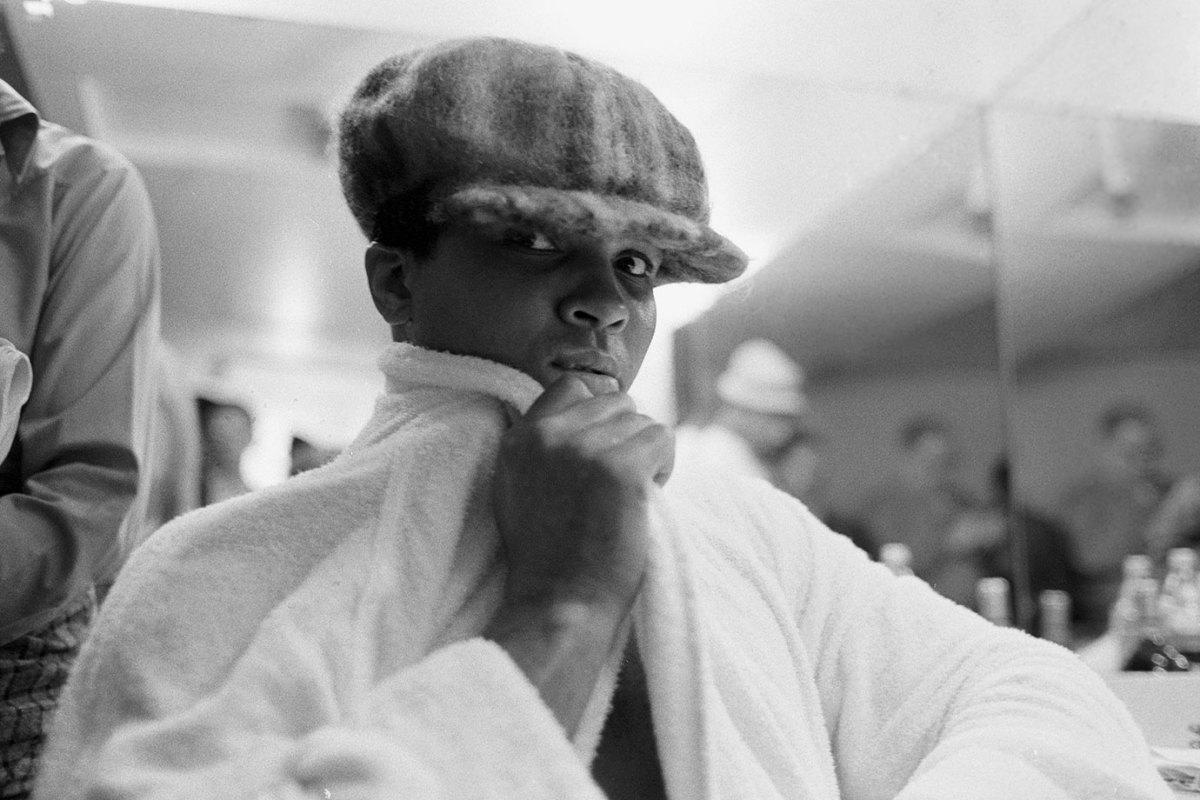
In a lighter pre-fight moment, Ali poses for a portrait wearing a hat in his dressing room before the match with Bugner.
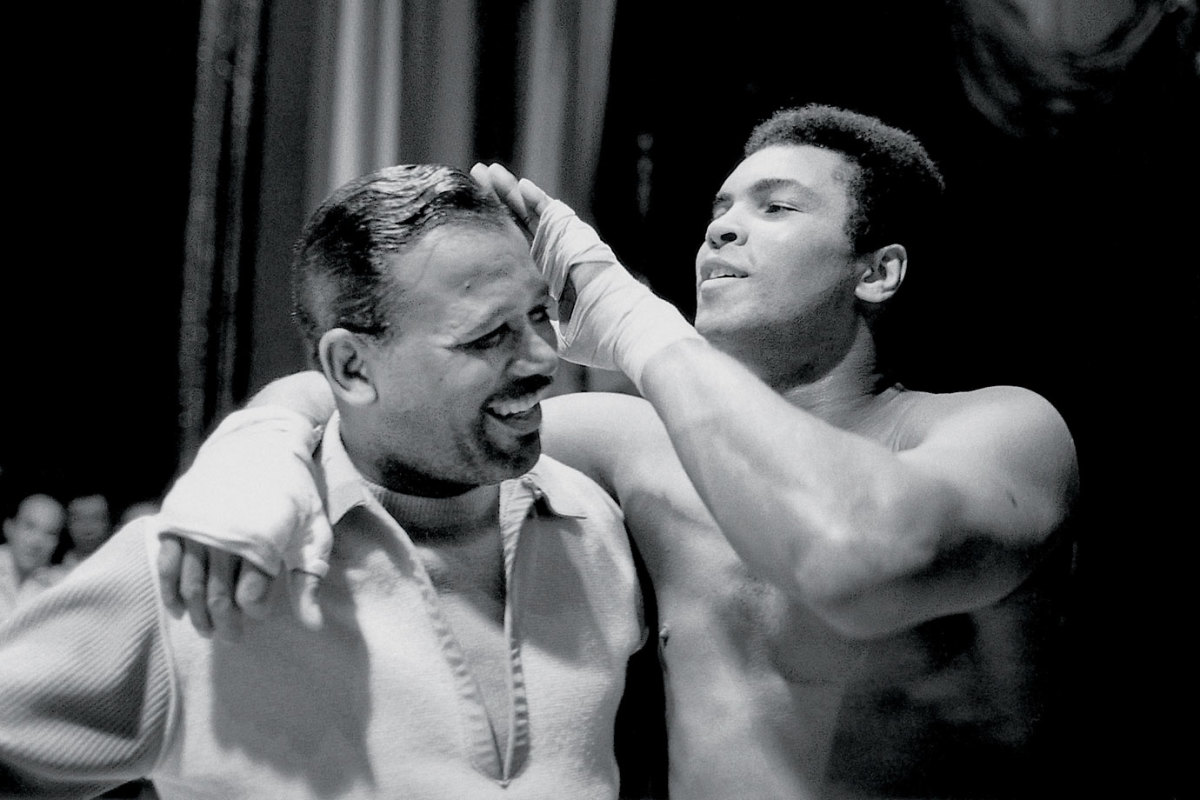
Ali plays with Sugar Ray Robinson's hair in the locker room before his bout with Bugner. The former welterweight and middleweight champion was Ali's childhood idol.
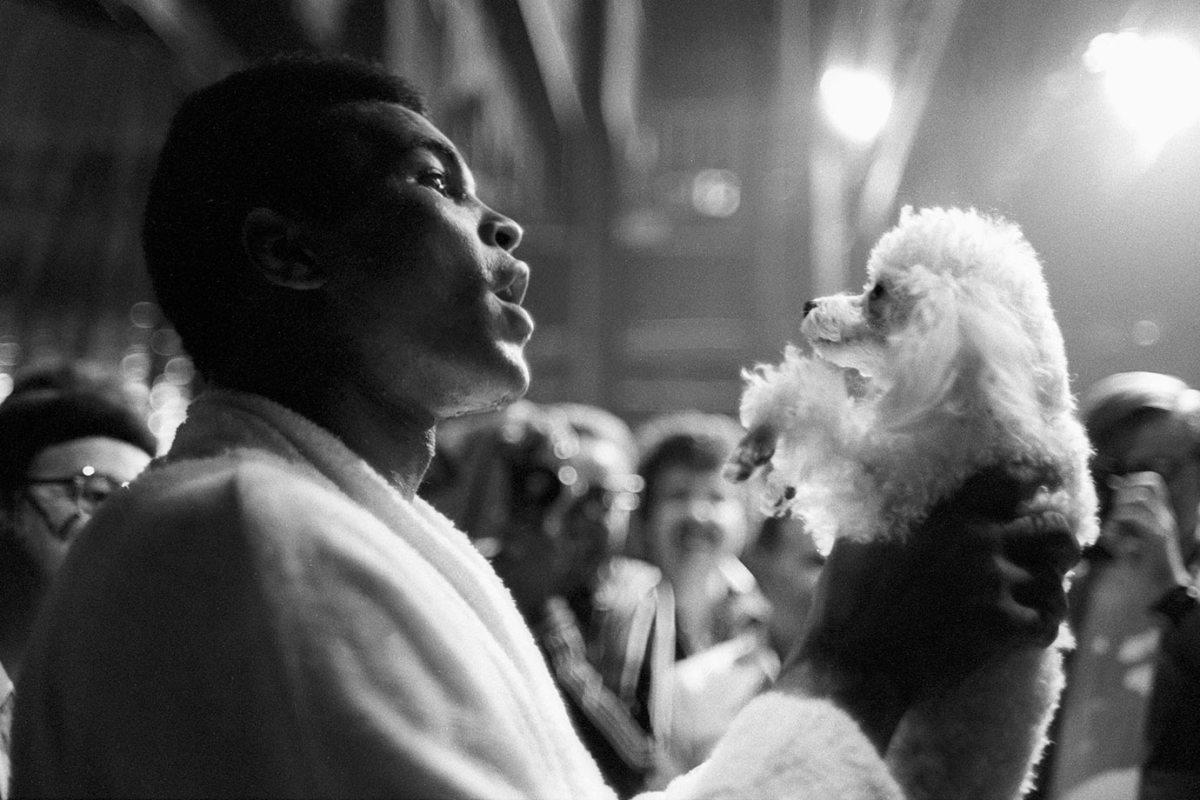
Before the fight with Bugner, Muhammad Ali enjoys a relaxed moment with a poodle at Caesars Palace Hotel. He won the fight with Bugner by unanimous decision.
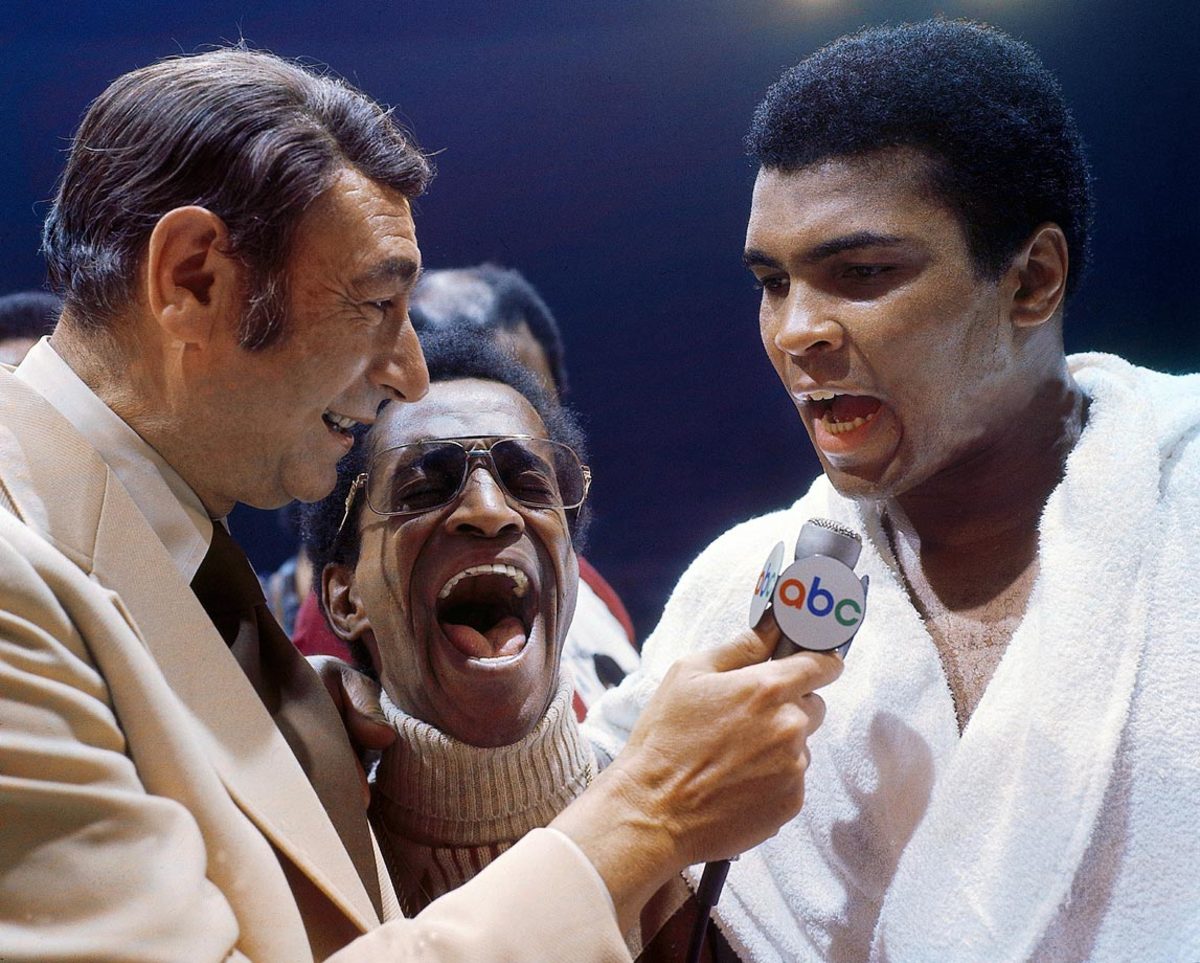
Howard Cosell interviews Ali, with entertainer Sammy Davis Jr. in the middle, after his victory over Joe Bugner by unanimous decision in. Although the fight was never in jeopardy of getting away from him, Ali praised Bugner's legs and said he could be a champion in a few years.
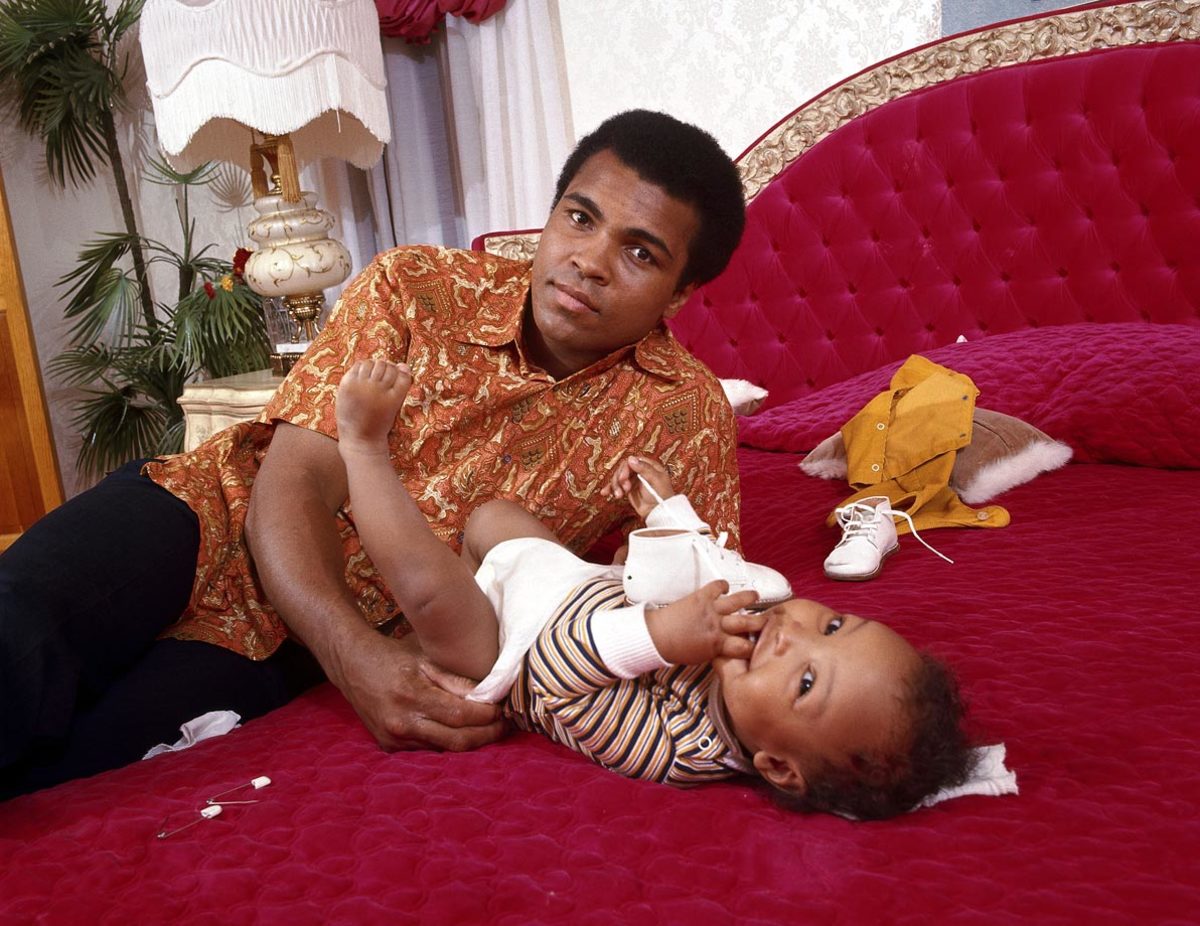
Ali changes the diaper of his son in his bedroom during a photo shoot at the family's home in April 1973. Ali had suffered a broken jaw less than a month earlier in his fight against Ken Norton.
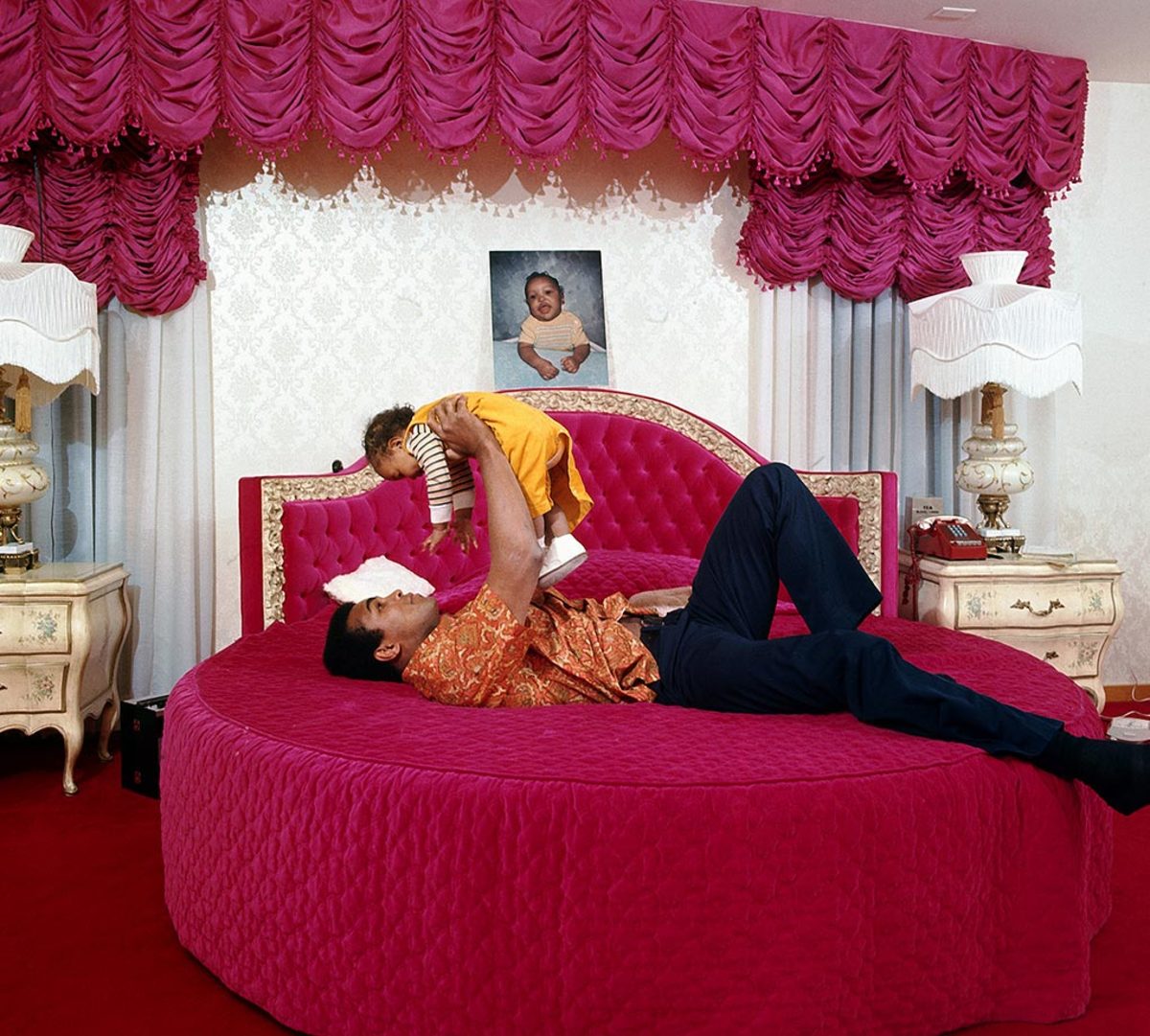
In the wake of his split decision loss to Norton, Ali plays with his son in his bedroom at home in Cherry Hill, N.J.
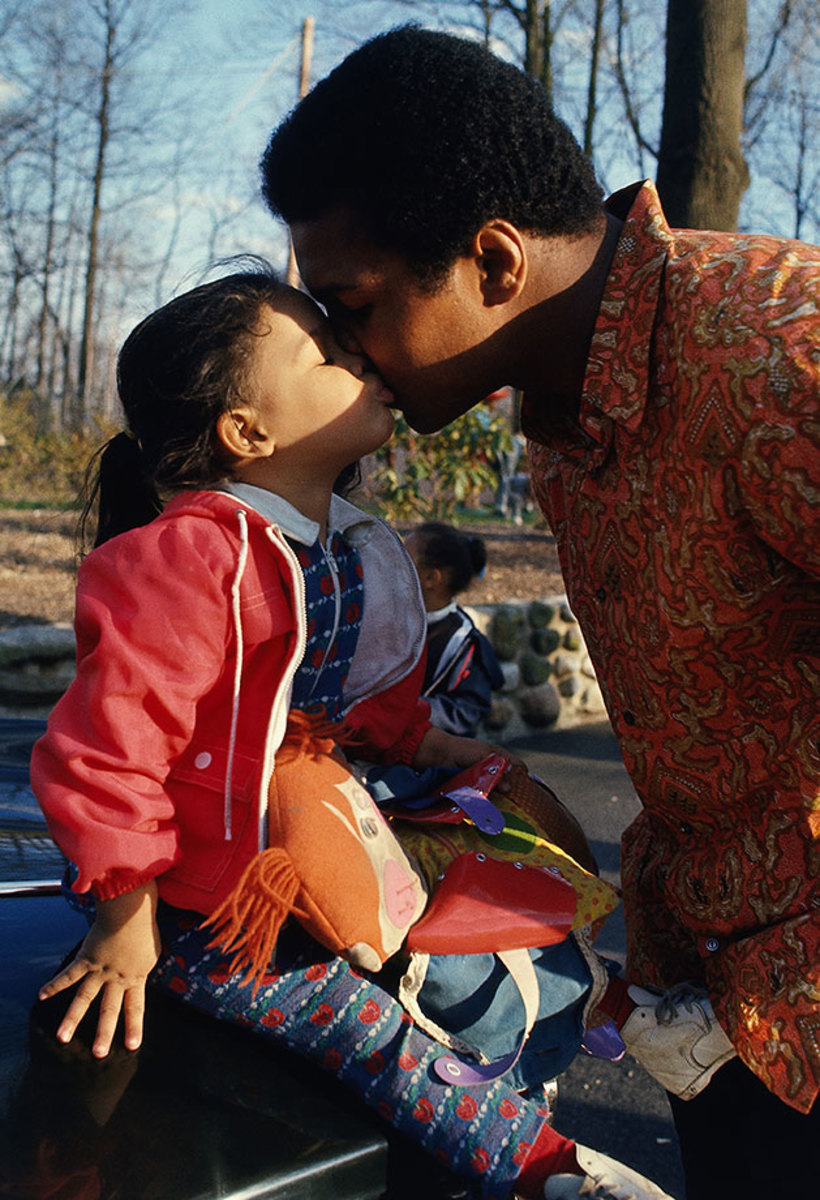
Ali kisses his daughter Jamillah outside of their home following the loss to Norton, just the second defeat of his career.
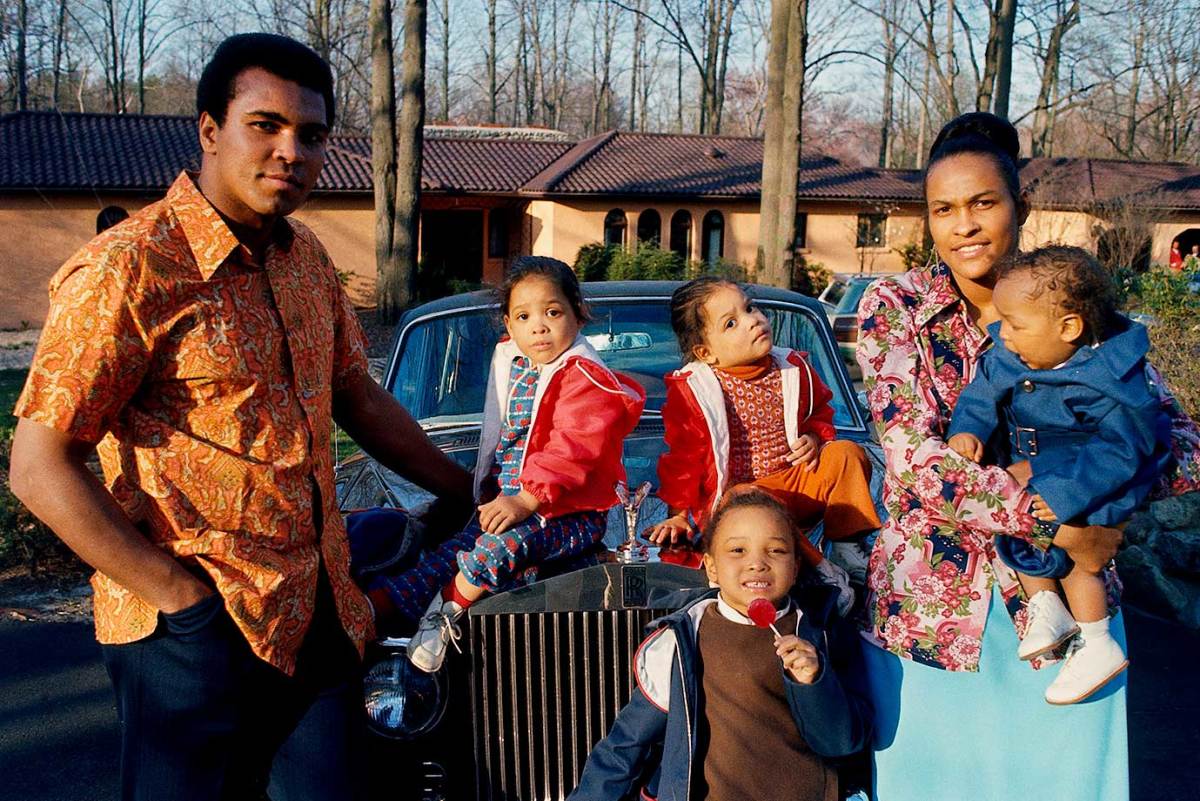
The Ali family standing outside their New Jersey home. To the right of Muhammad Ali are his twin daughters, Jamilllah and Rasheda, daughter Maryum and his wife, Khalilah, holding their son Ibn Muhammad Ali Jr.
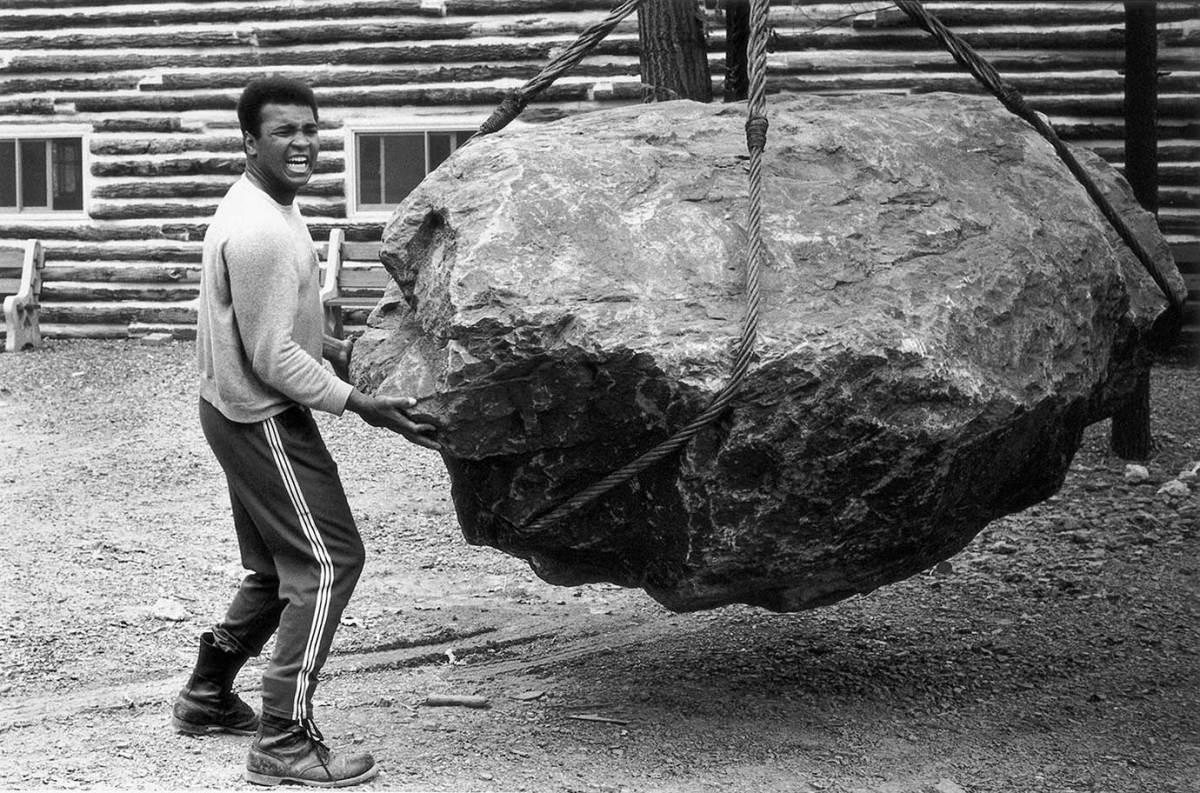
At his training camp cabin, Ali pushes a boulder during a photo shoot in Deer Lake, Penn., in August 1973. Ali was training for his rematch against Ken Norton, who broke his jaw five months earlier.
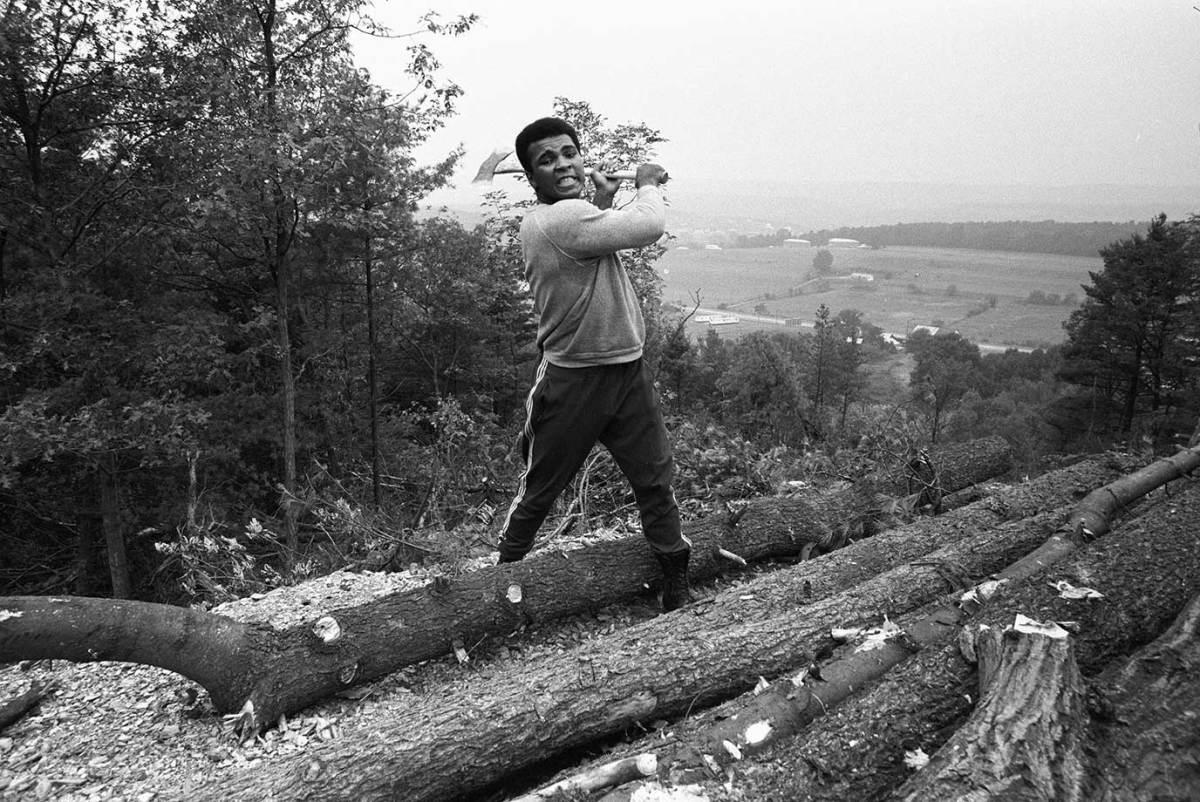
Ali chops wood at his cabin in Deer Lake. He referred to the training camp as "fighter's heaven" and used it to prepare for fights away from the spotlight.
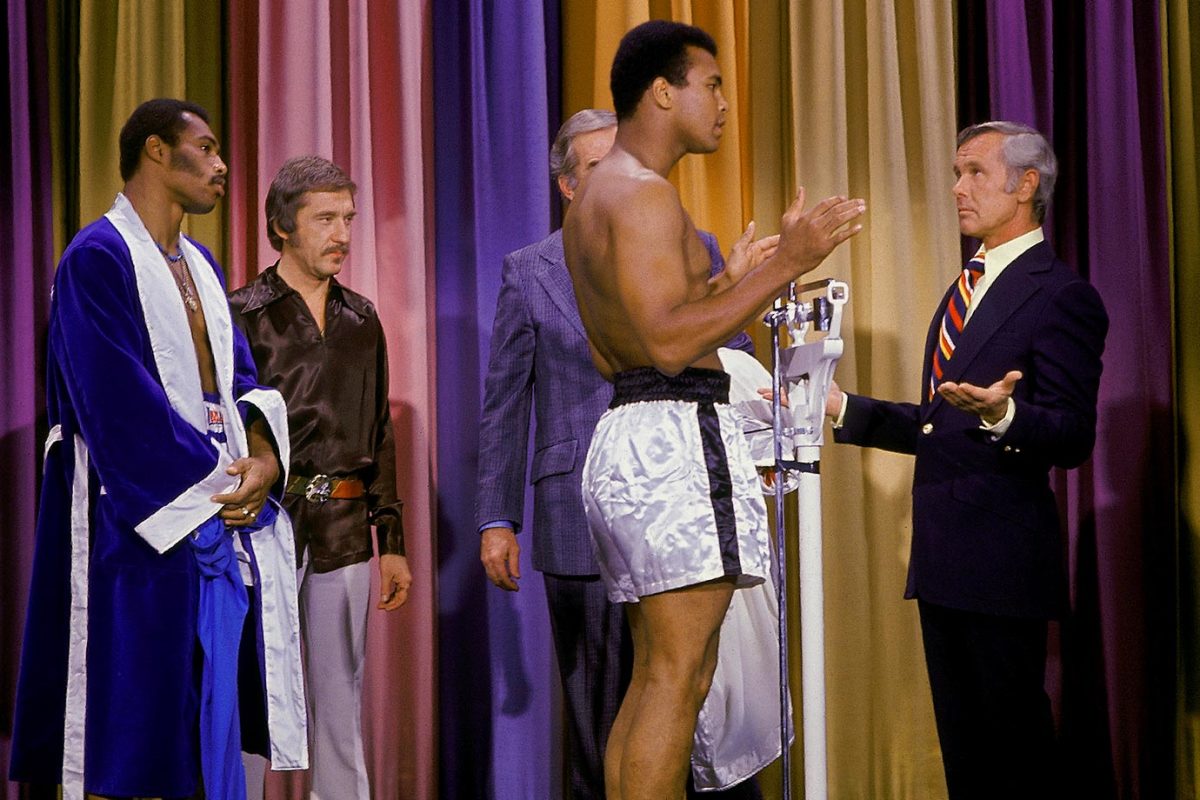
The fighters weigh in on the Tonight Show with Johnny Carson ahead of Ali and Ken Norton's September 1973 fight.
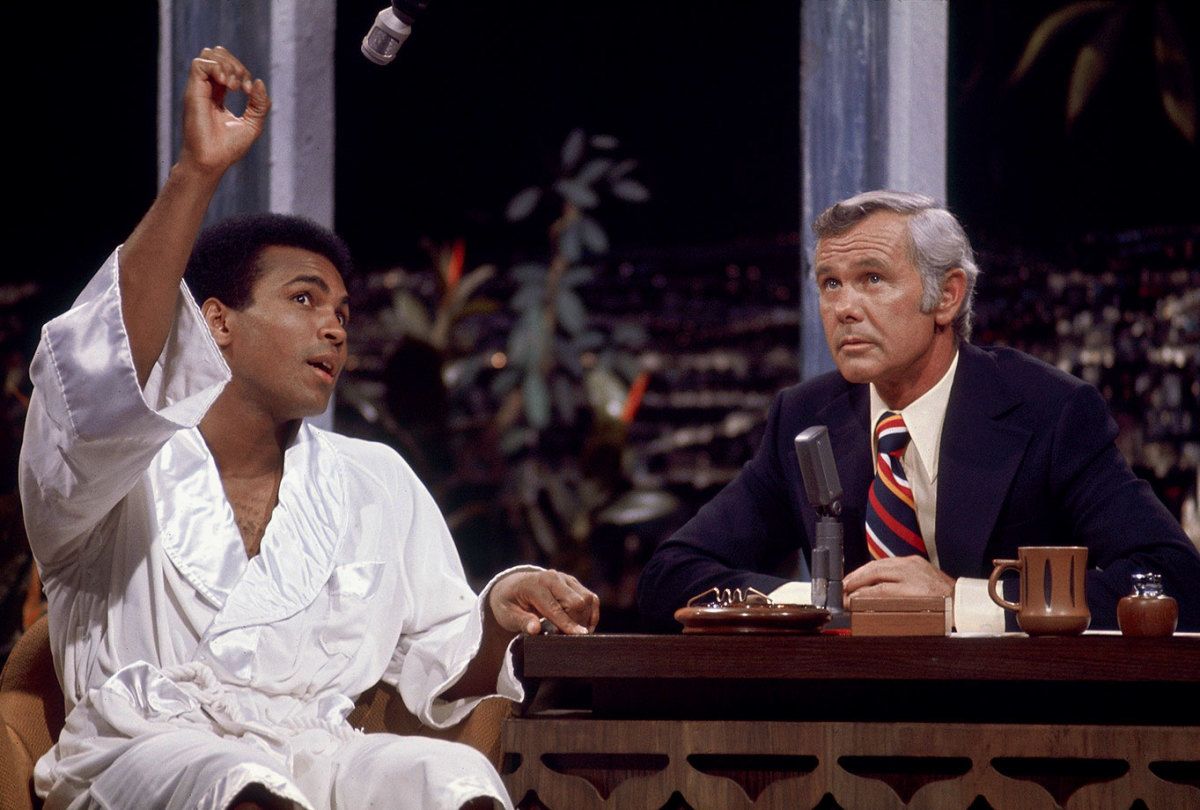
Johnny Carson listens to Ali on the Tonight Show three days before his rematch with Norton. Ali would avenge his earlier loss to Norton, winning a narrow split decision.
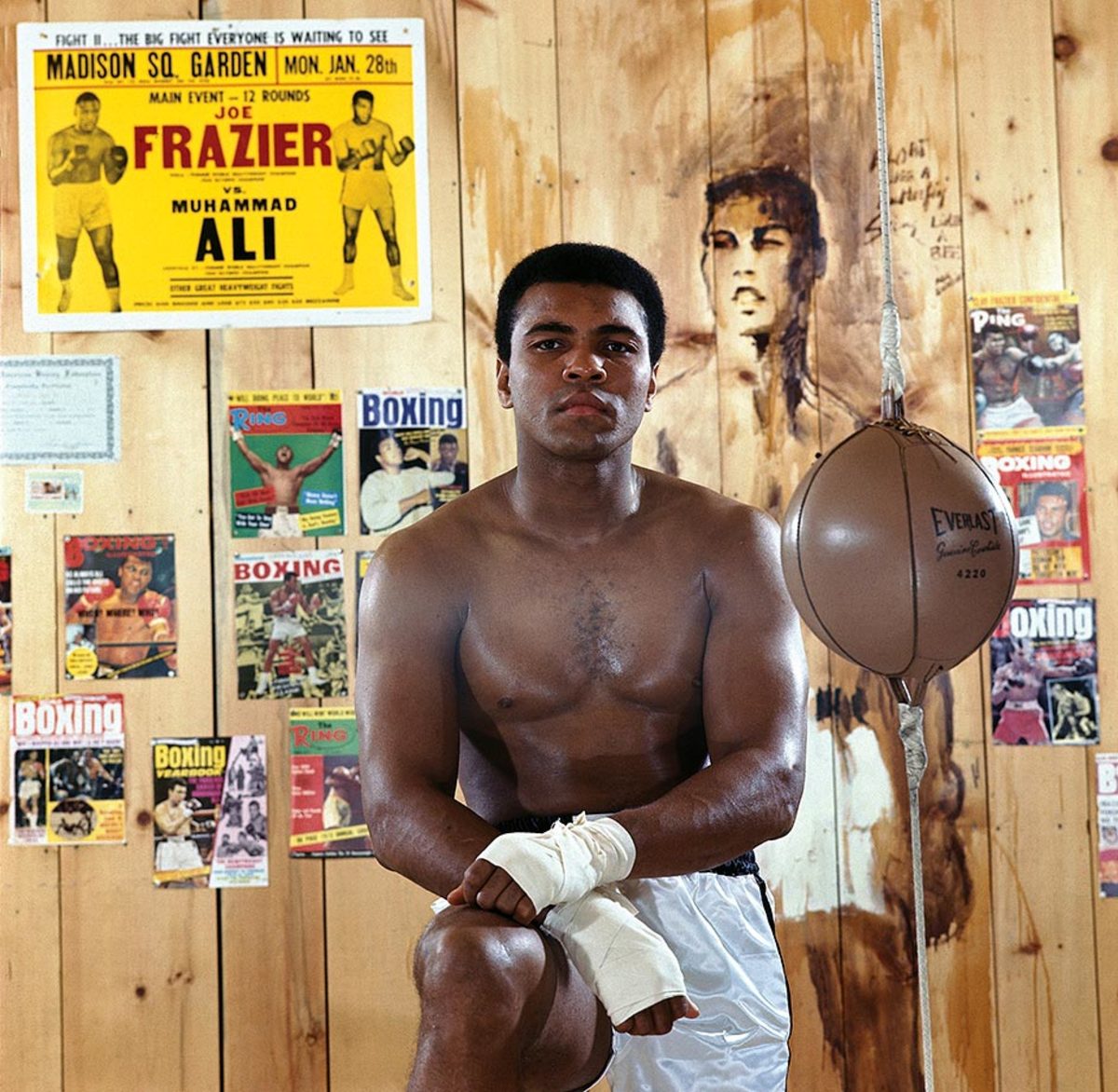
Ali poses in front of posters and magazine covers from throughout his career at his training camp cabin in Deer Lake in 1974.
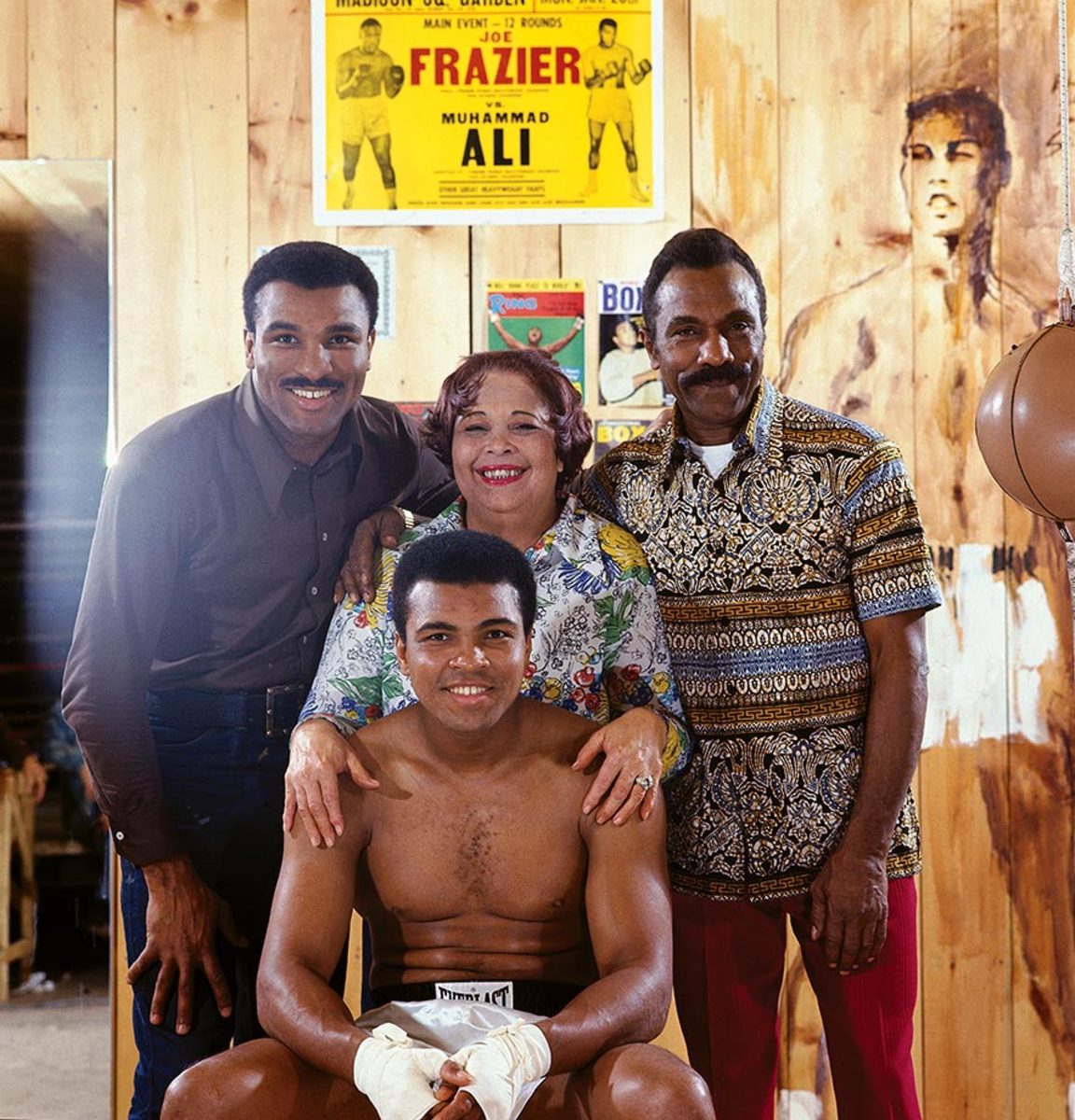
Ali poses with members of his family in front of a poster from his first fight with Joe Frazier. Ali's brother, Rahman Ali; mother, Odessa Clay; and father, Cassius Clay Sr. stand behind the boxer.
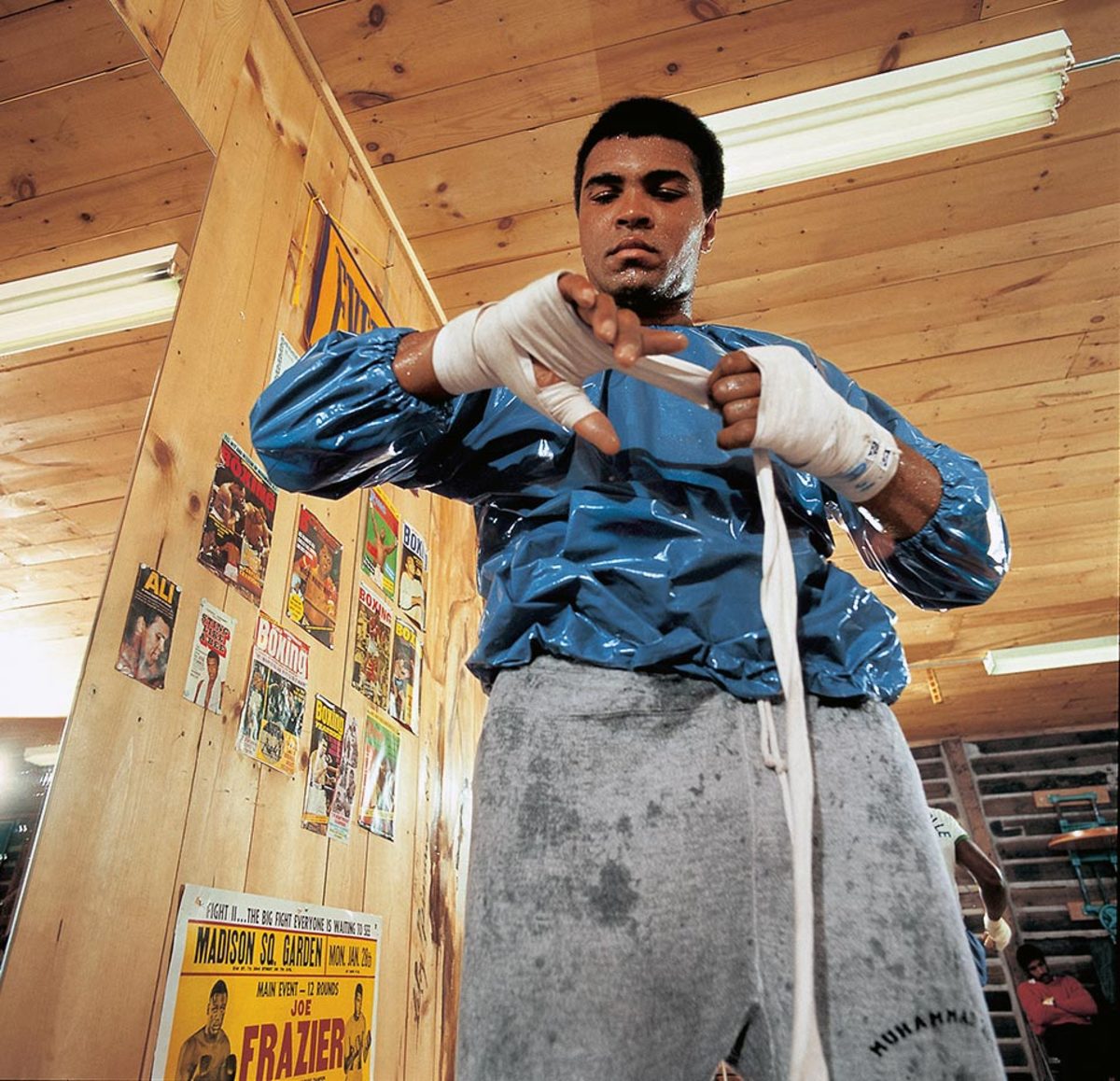
Less than three weeks before his rematch with Joe Frazier on Jan. 28, 1974, Ali wraps his hands while wearing a sauna suit at his training camp cabin.
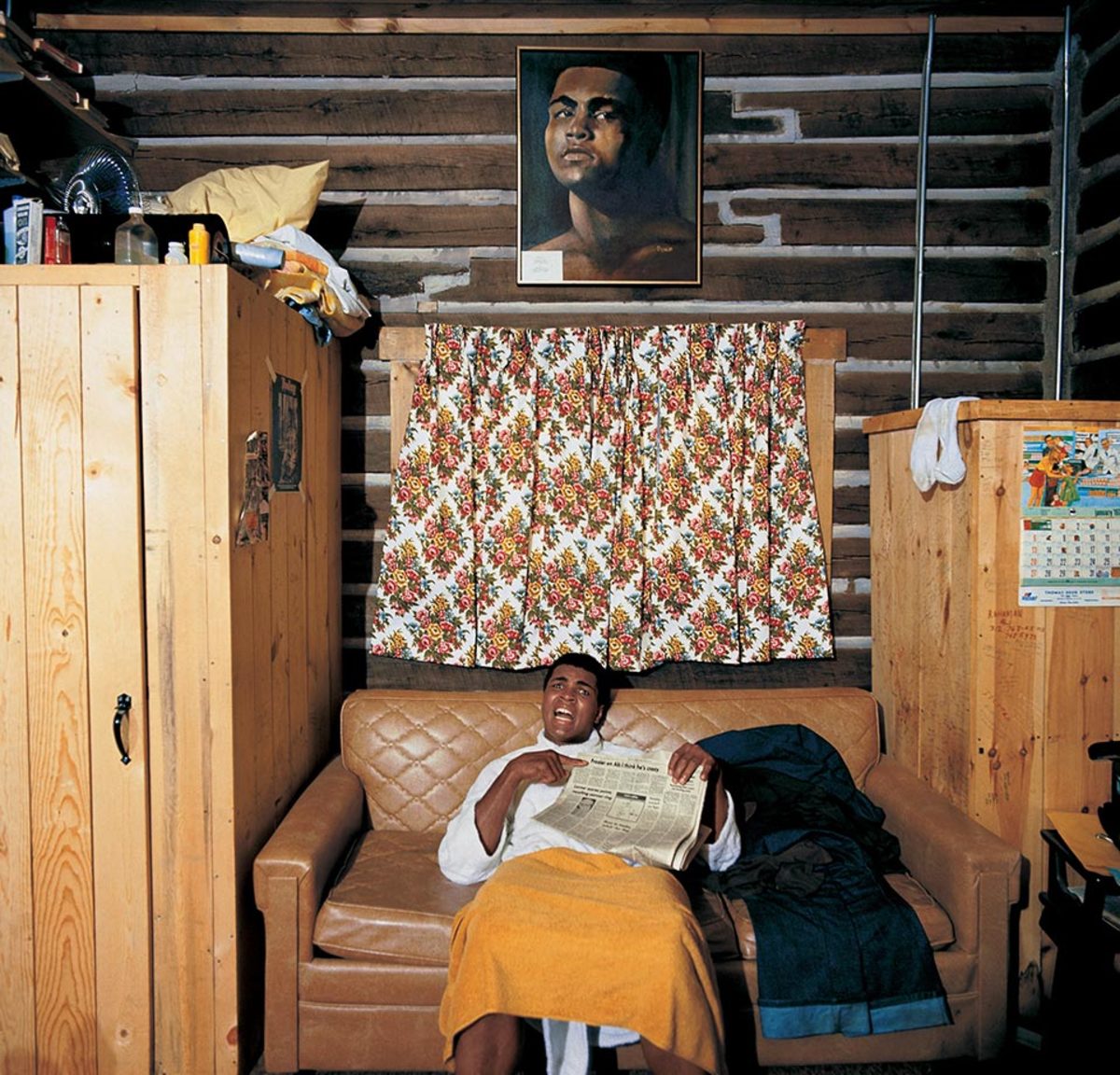
Ali holds a newspaper at his cabin in January 1974. He is pointing to a headline that reads, "Frazier On Ali, I Think He's Crazy." Ali and Frazier fought for the second time later that month with Ali winning by a unanimous decision.
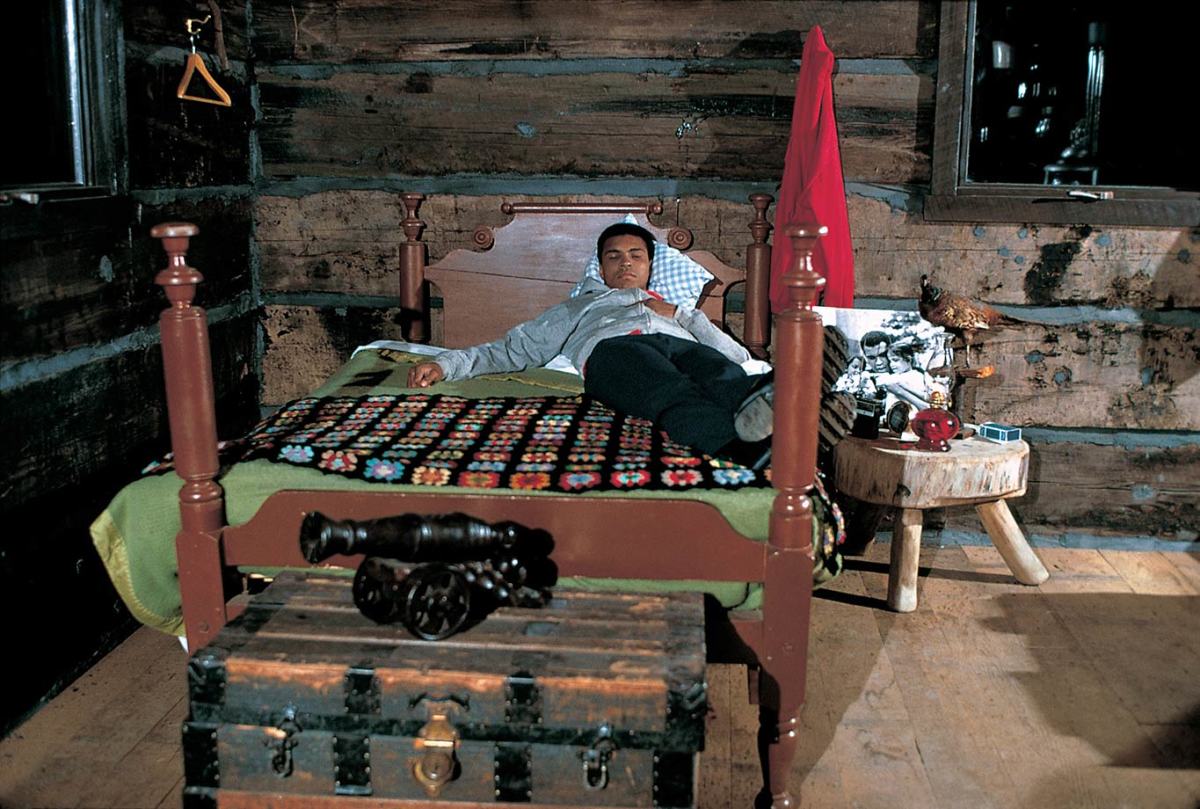
Ali lies on his bed at his cabin during the January 1974 photo shoot.
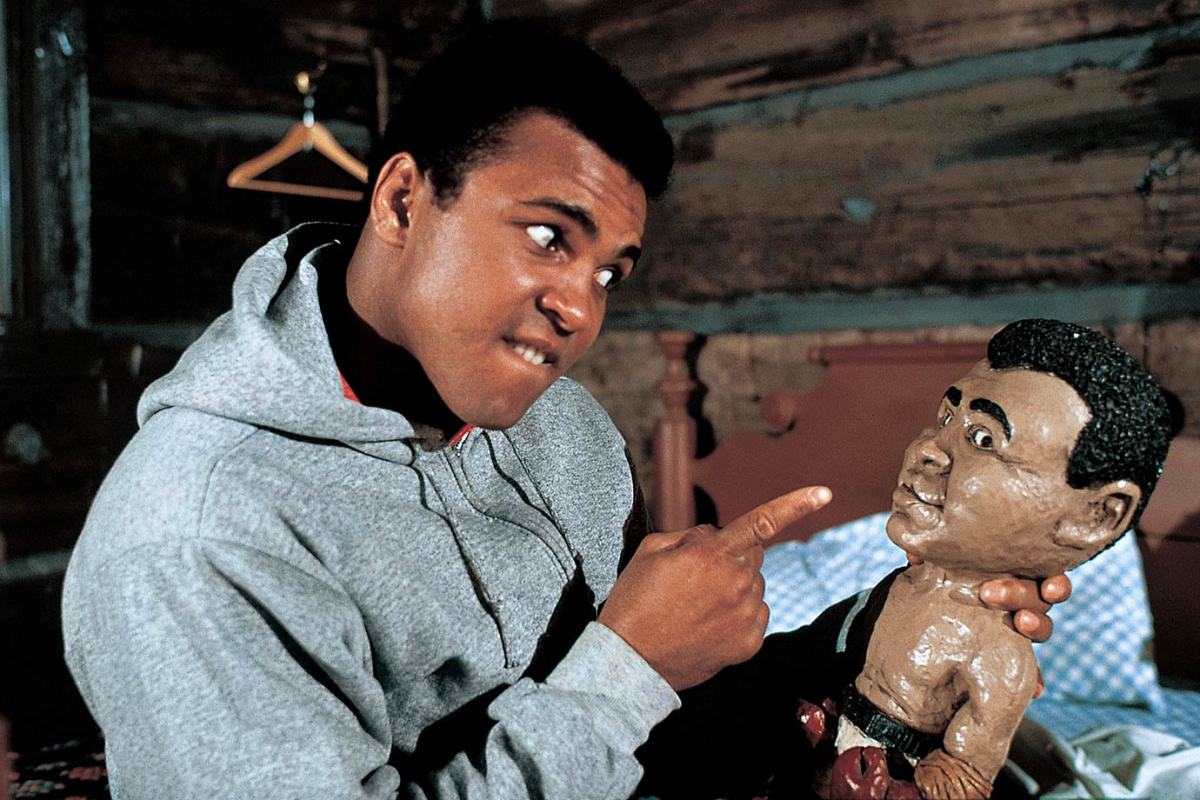
His smaller incarnation stares straight back as Ali plays with a doll of himself during the same 1974 shoot at his training camp cabin.
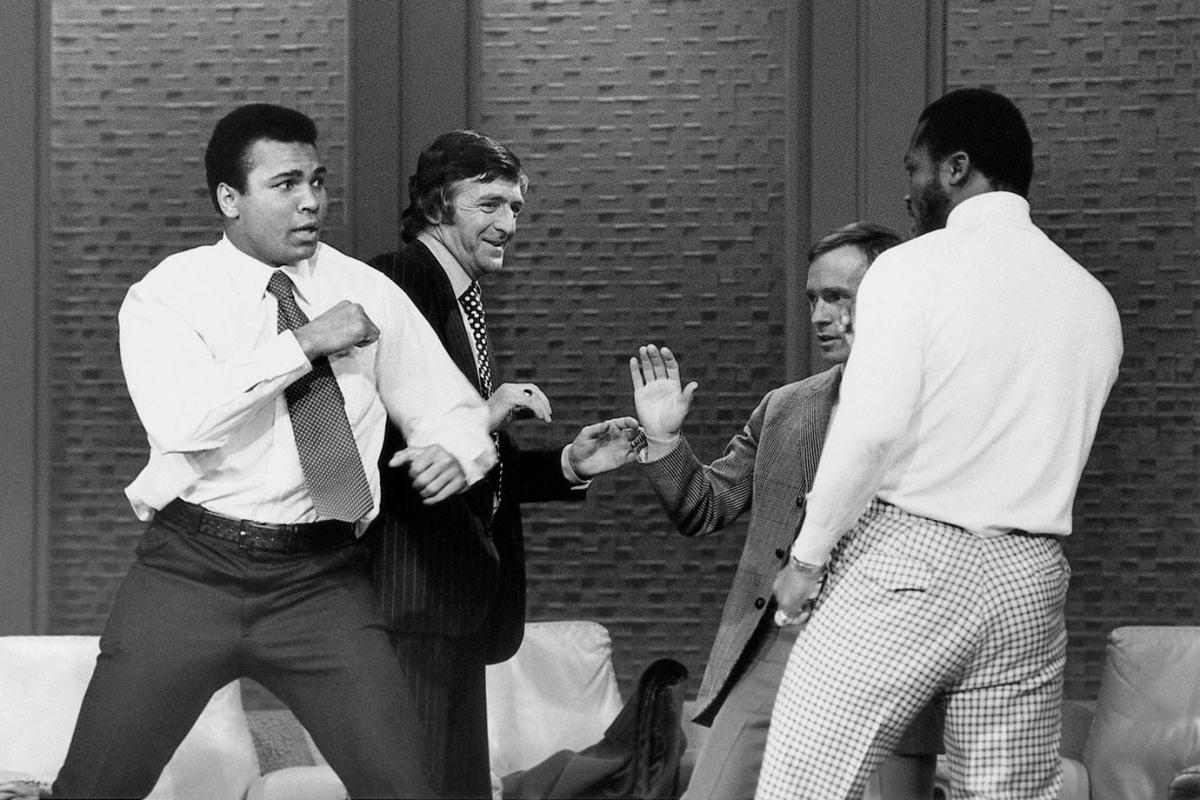
Ali and Joe Frazier fight on the set of The Dick Cavett Show while reviewing their 1971 bout in advance of their 1974 rematch. Ali called Frazier ignorant, to which Frazier took exception. As the studio crew tried to calm Frazier down, Ali held Frazier by the neck, forcing him to sit down and sparking a fight. The television set fight amped up anticipation of their January 1974 bout.
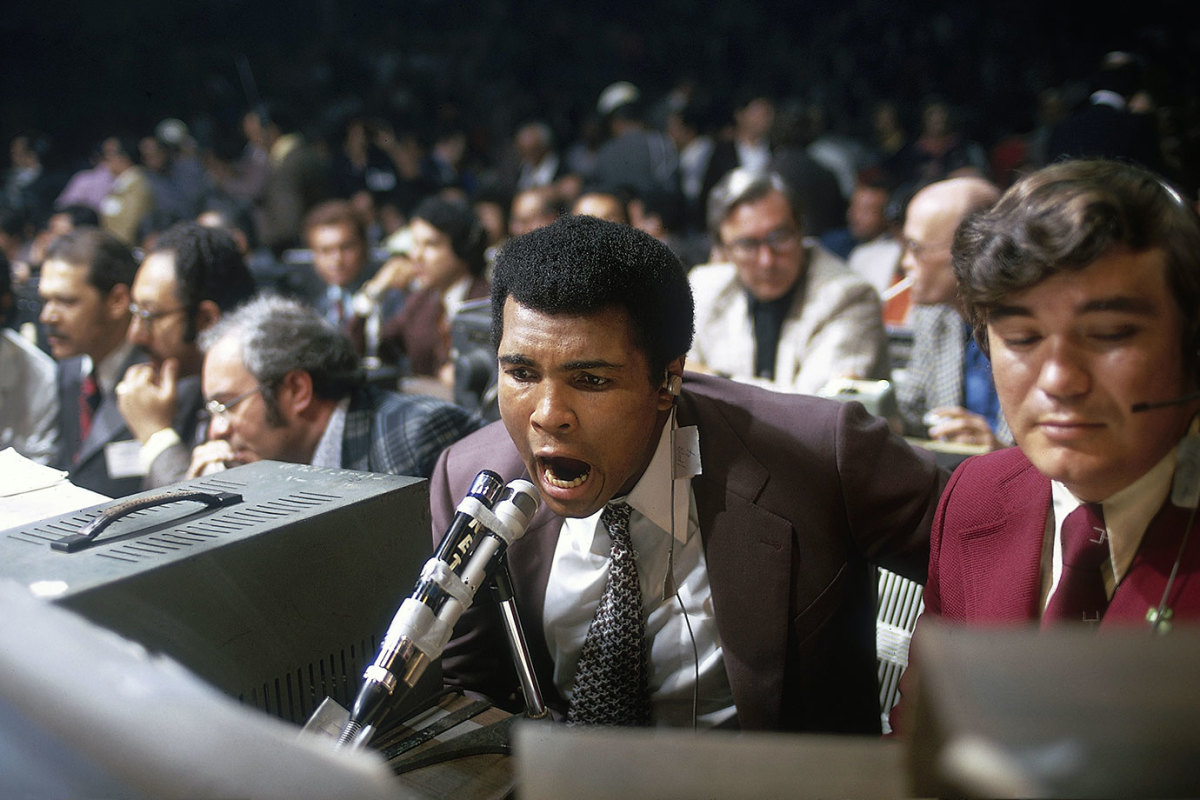
Exploring a different side of the sport, Ali broadcasts the fight between George Foreman and Ken Norton in March 1974. Foreman won the fight by technical knockout in the second round, setting up the showdown with Ali in Zaire.
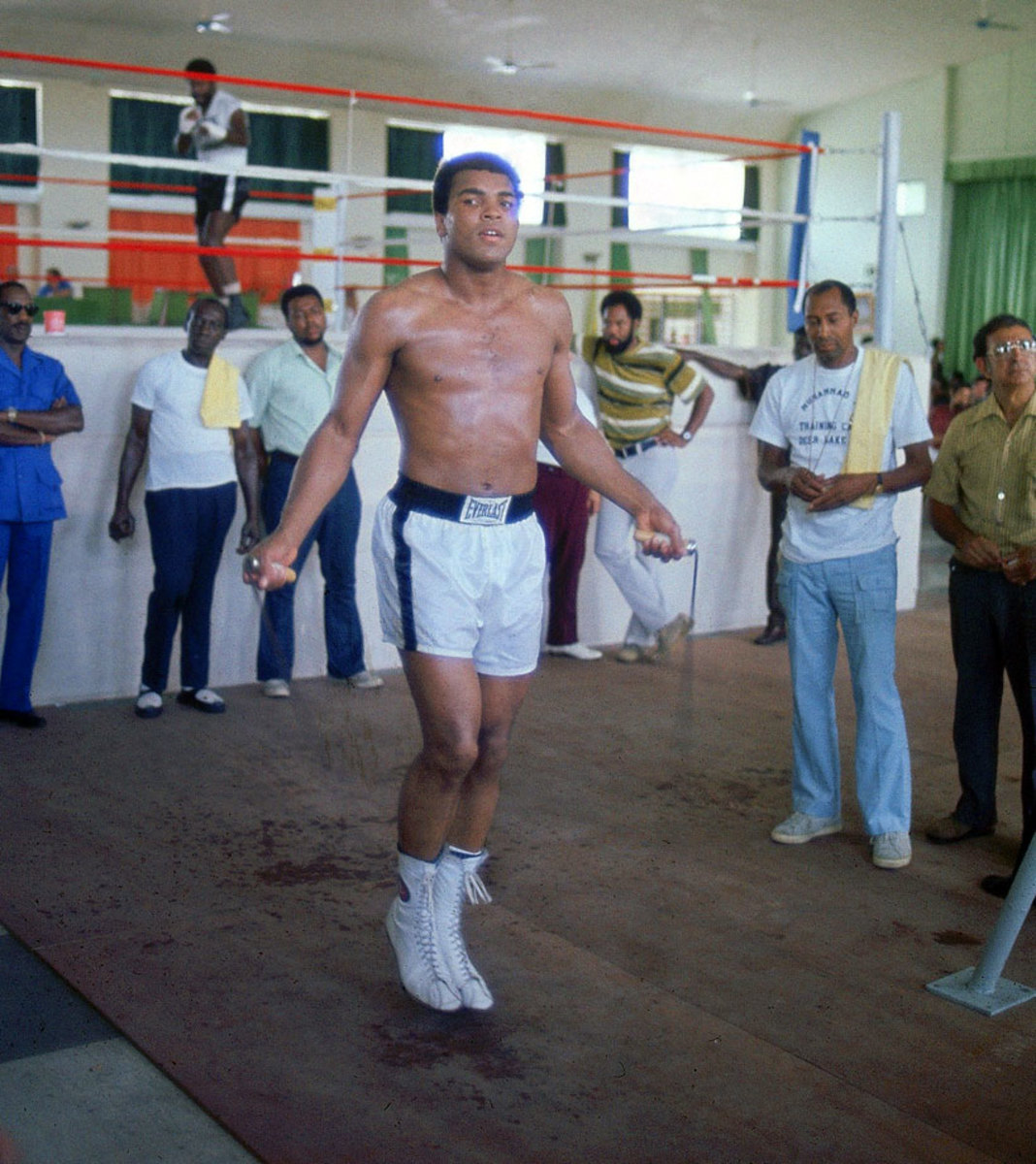
Ali jumps rope at the Salle de Congres in Kinshasa, Zaire, while training for his heavyweight title fight against George Foreman. Both Ali and Foreman spent most of the summer of 1974 training in Zaire to adjust to the climate.
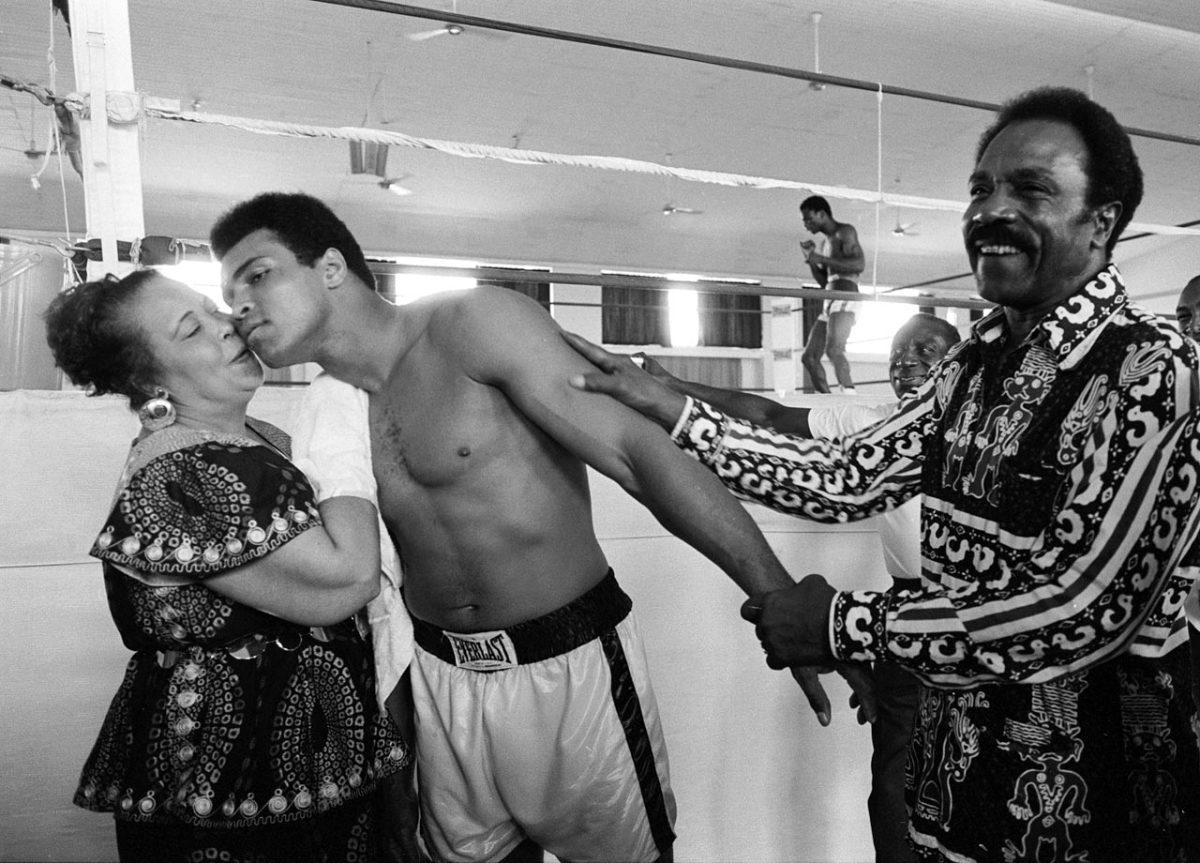
While training before his fight with George Foreman, Ali kisses his mother, Odessa Clay, while his father, Cassius Clay Sr., looks on. Ali's superior strategy and ability to take a punch led him to his upset victory as he absorbed body blows from Foreman before he responded with powerful combinations to Foreman's head.
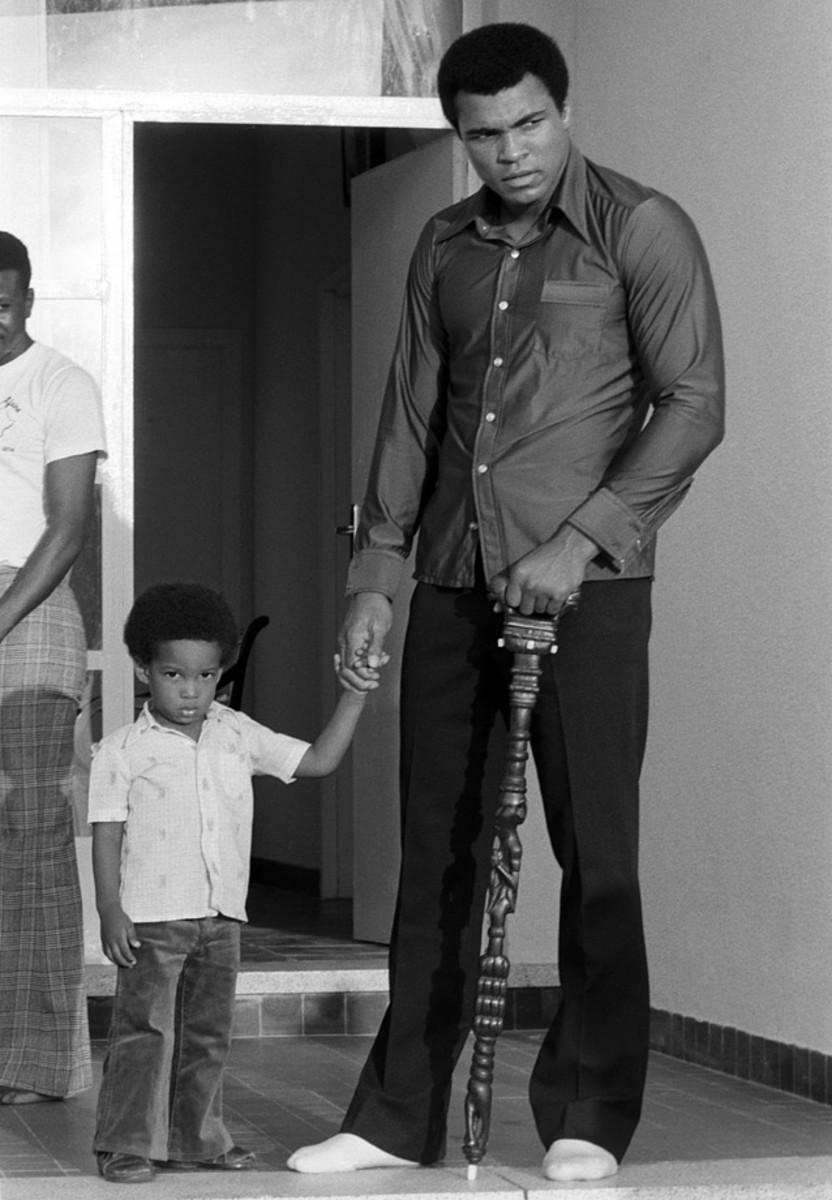
Four days before the fight, Ali holds the hand of his son Ibn in Zaire. Ali successfully courted the favor of the Zaire crowd, prompting chants of "Ali bomaye!" — translated as "Ali, kill him!"
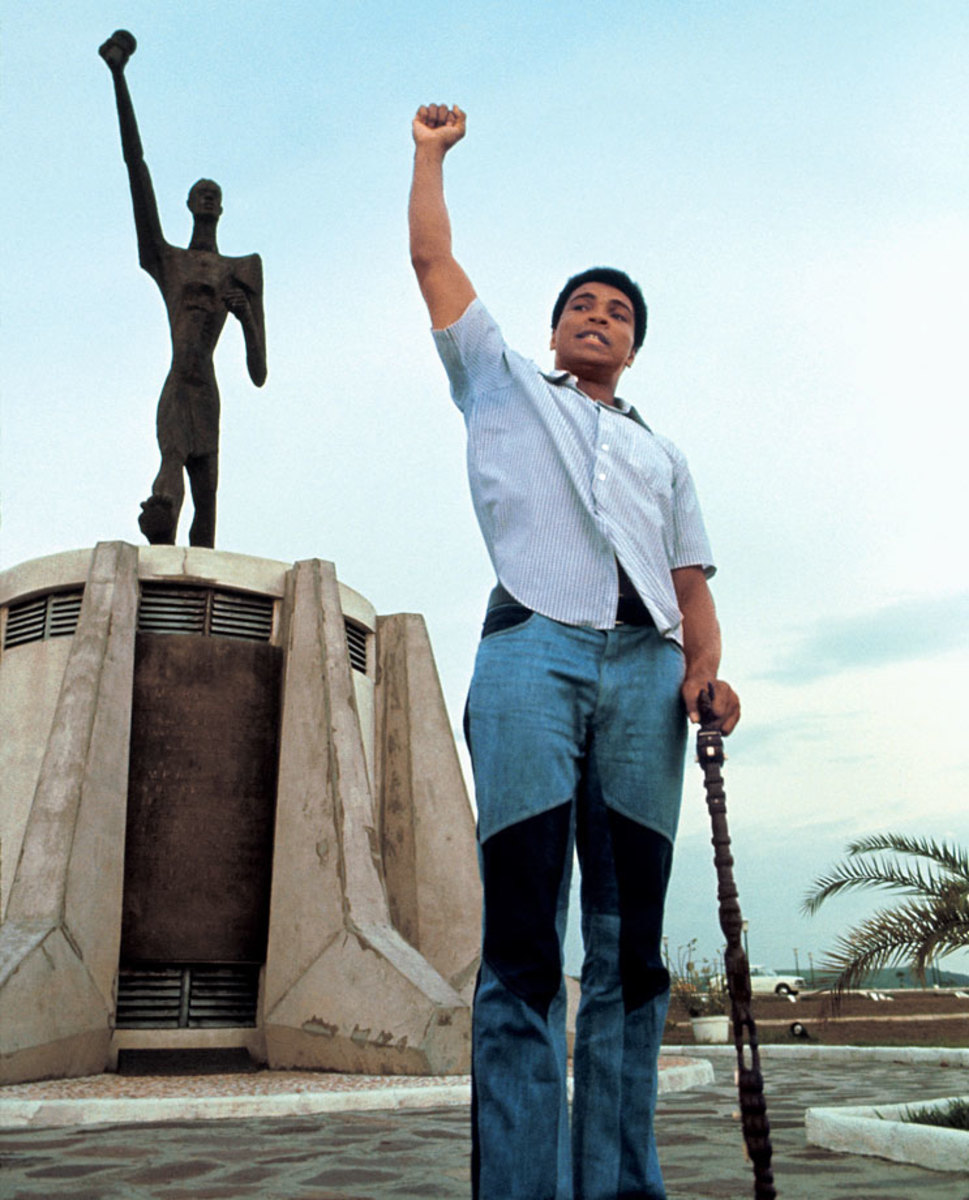
Ali poses in front of the Le Militant statue at the presidential complex that was the site of Ali's January heavyweight title bout with Foreman. The fight was originally set for a month earlier, but Foreman suffered a cut near his eye during training, forcing a delay.
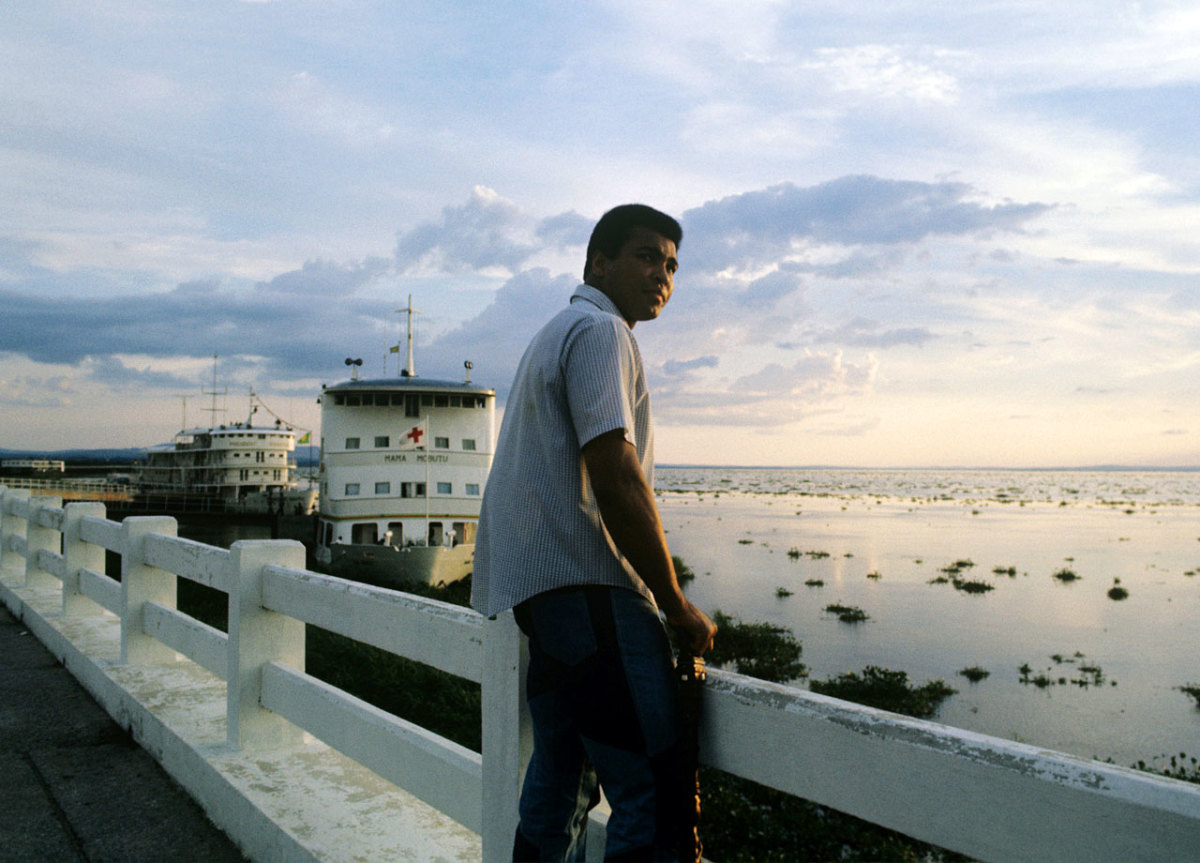
Ali stands against the railing on the River Zaire watching the sunset four days before the Rumble in the Jungle. The fight was sponsored by Zaire to achieve the $5 million purse promoter Don King had promised both Ali and Foreman.
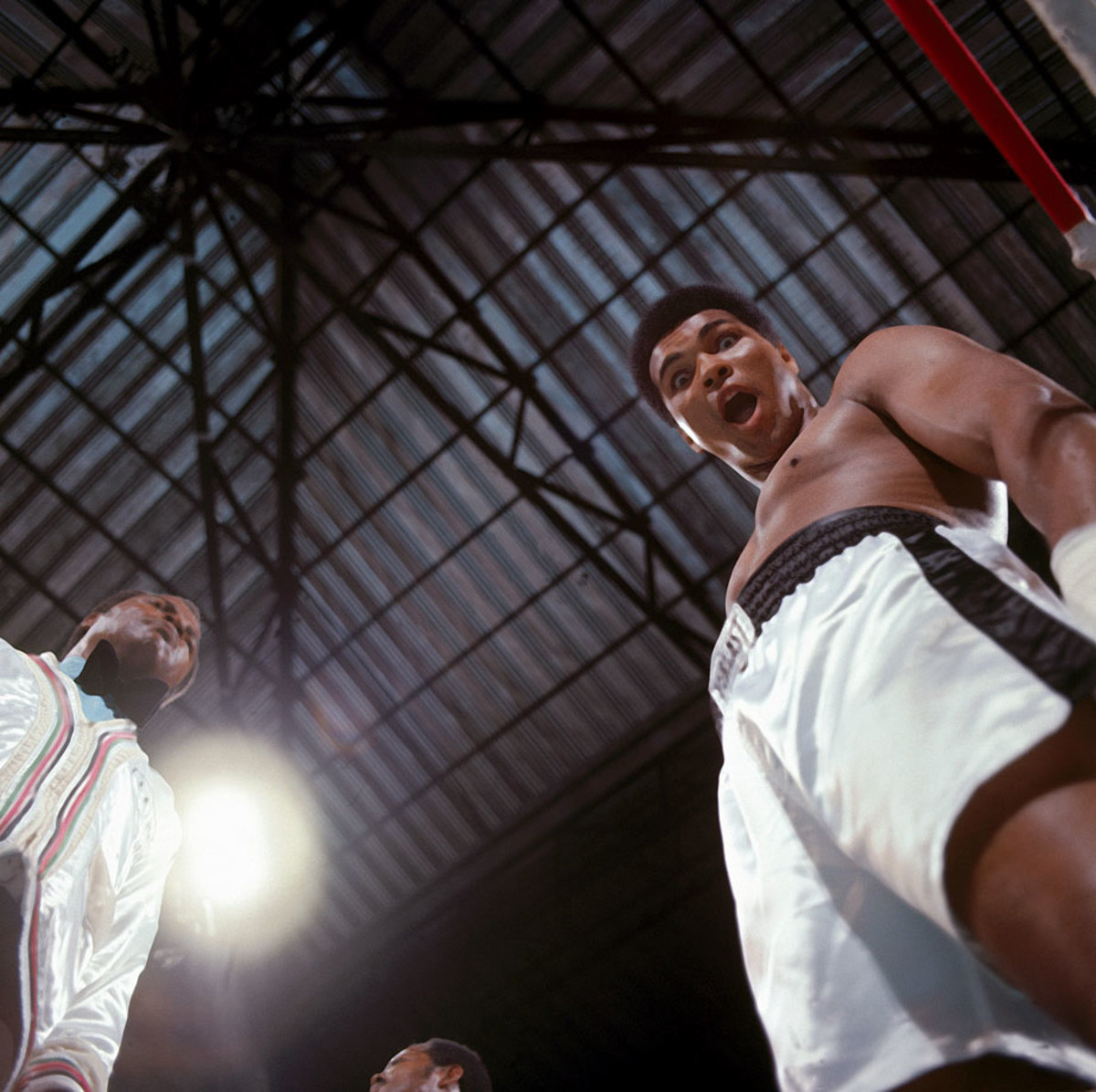
Before employing his famous rope-a-dope strategy against Foreman, Ali makes a face at the camera. Ali allowed Foreman to throw many punches but only into his arms and body, and when Foreman tired himself out from the mostly ineffective punches, Ali took control of the fight.
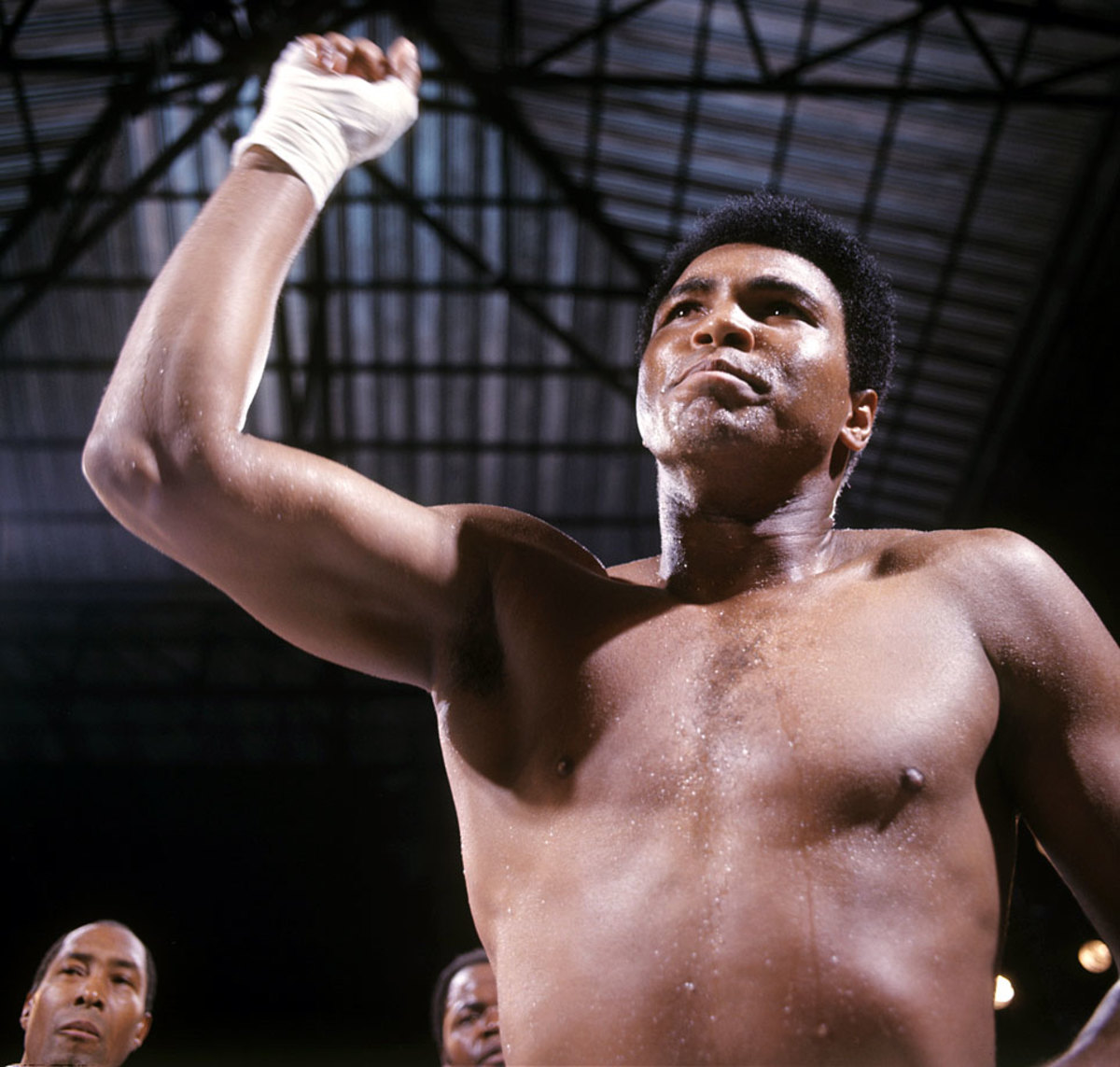
Ali points before his bout with Foreman. The victory over his favored opponent made him the heavyweight champion of the world for the first time since he was stripped of his titles in 1967.
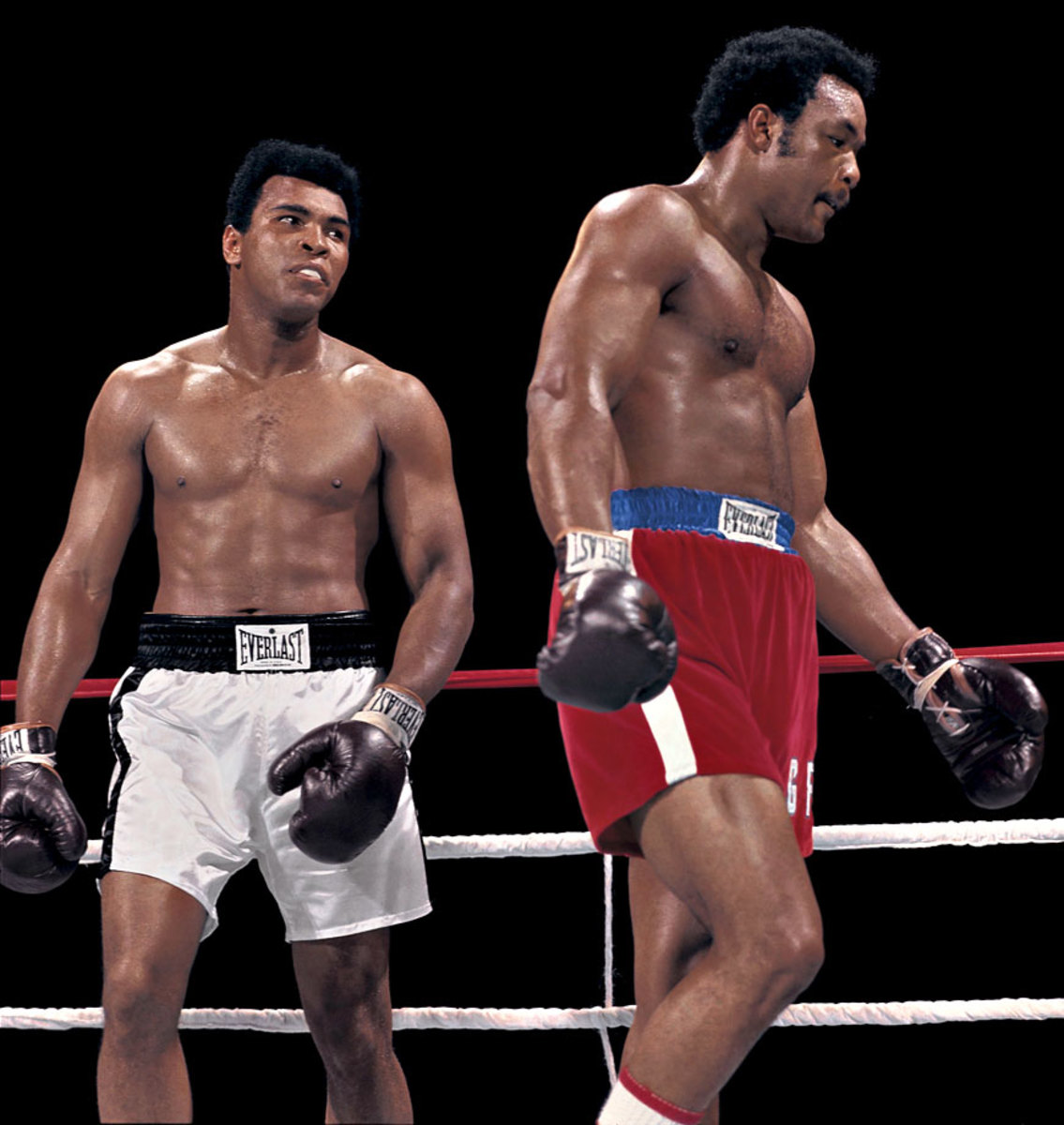
Ali stares at George Foreman during the Rumble in the Jungle. Ali earned his shot at the heavyweight title by defeating Joe Frazier in January 1974, avenging a loss three years earlier.
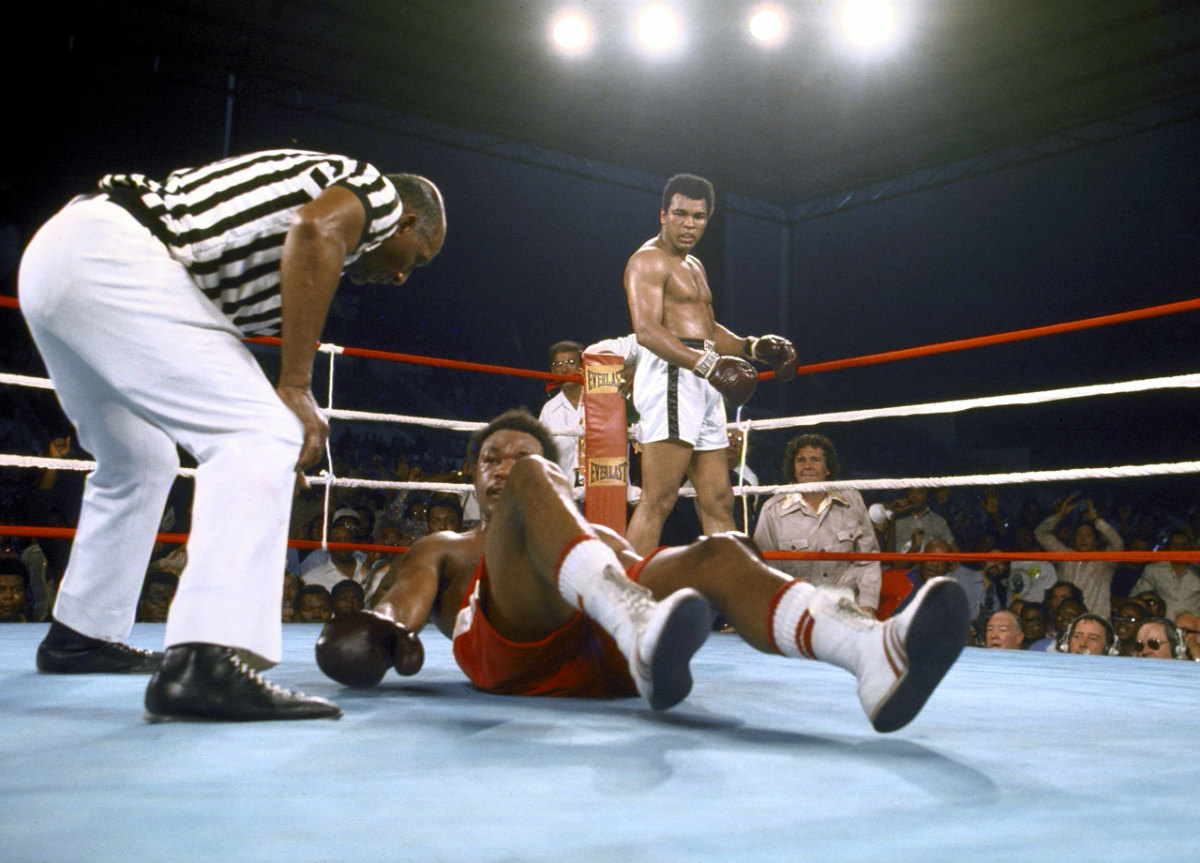
Foreman lies down on the canvas as Ali stands in the background during the Rumble in the Jungle. Ali knocked Foreman down with a five-punch combination in the eighth round, and referee Zack Clayton counted him out.
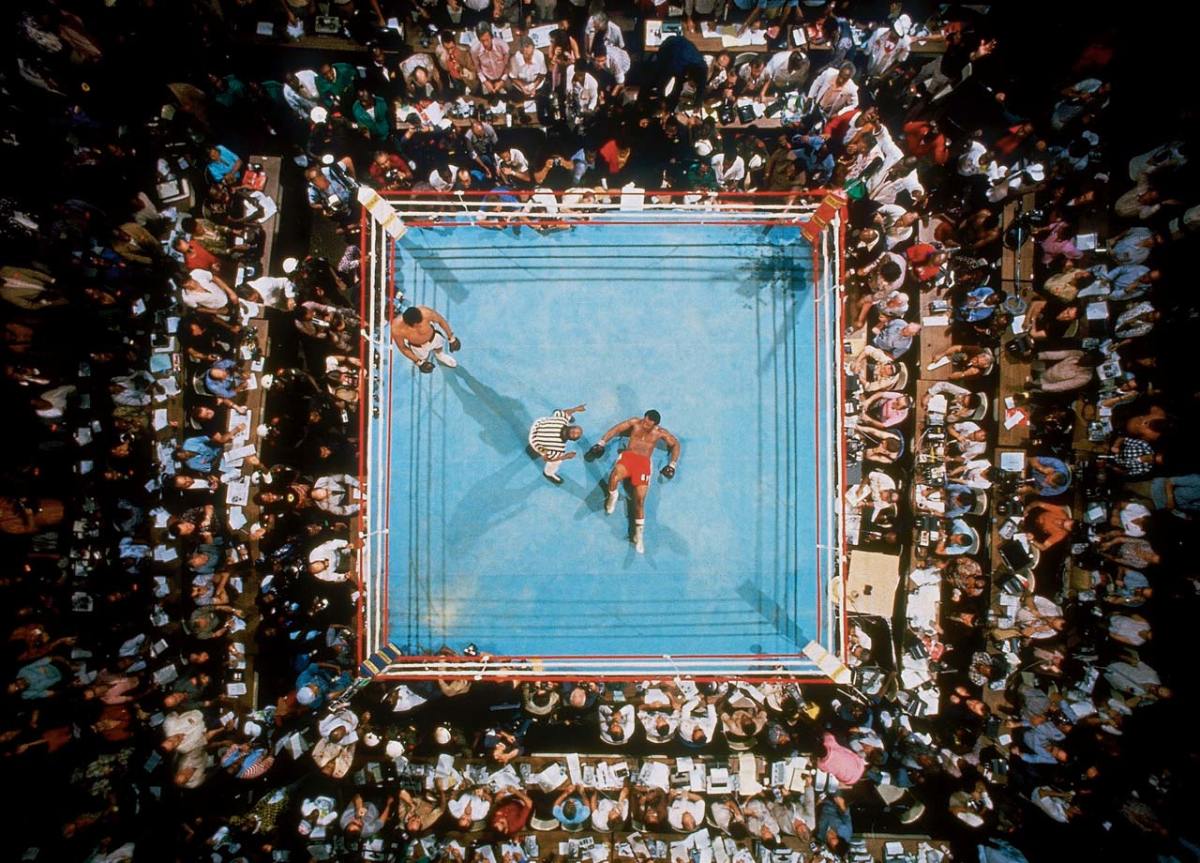
Big George stares at the ceiling as referee Zack Clayton counts him out in the eighth round. The victory made Ali, once again, the heavyweight champion of the world.
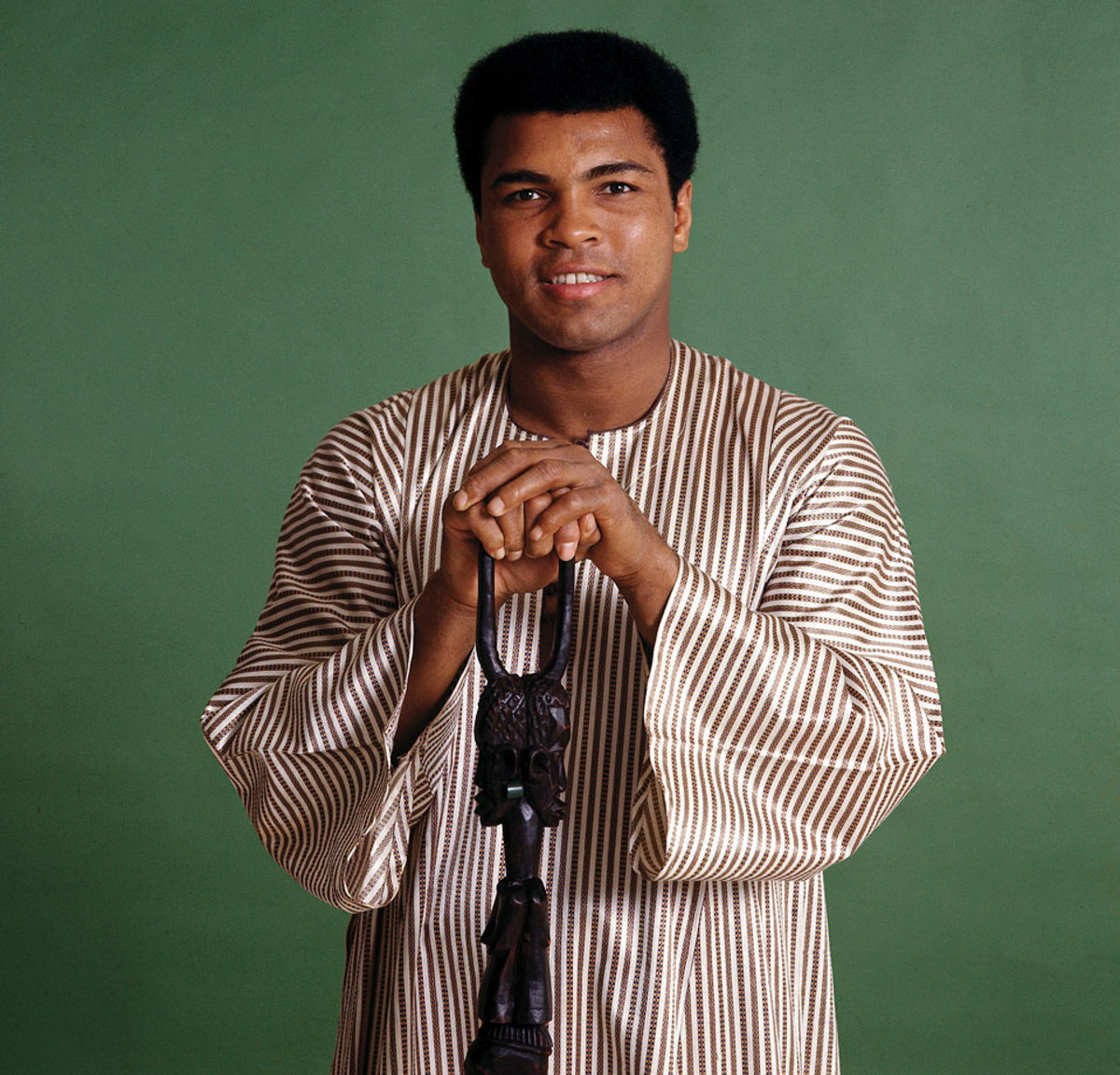
Ali poses for a portrait after being selected as the Sports Illustrated Sportsman of the Year in 1974. Ali wore a dashiki, a men's garment widely worn in West Africa. He also brought the walking stick given to him by Zaire's president.
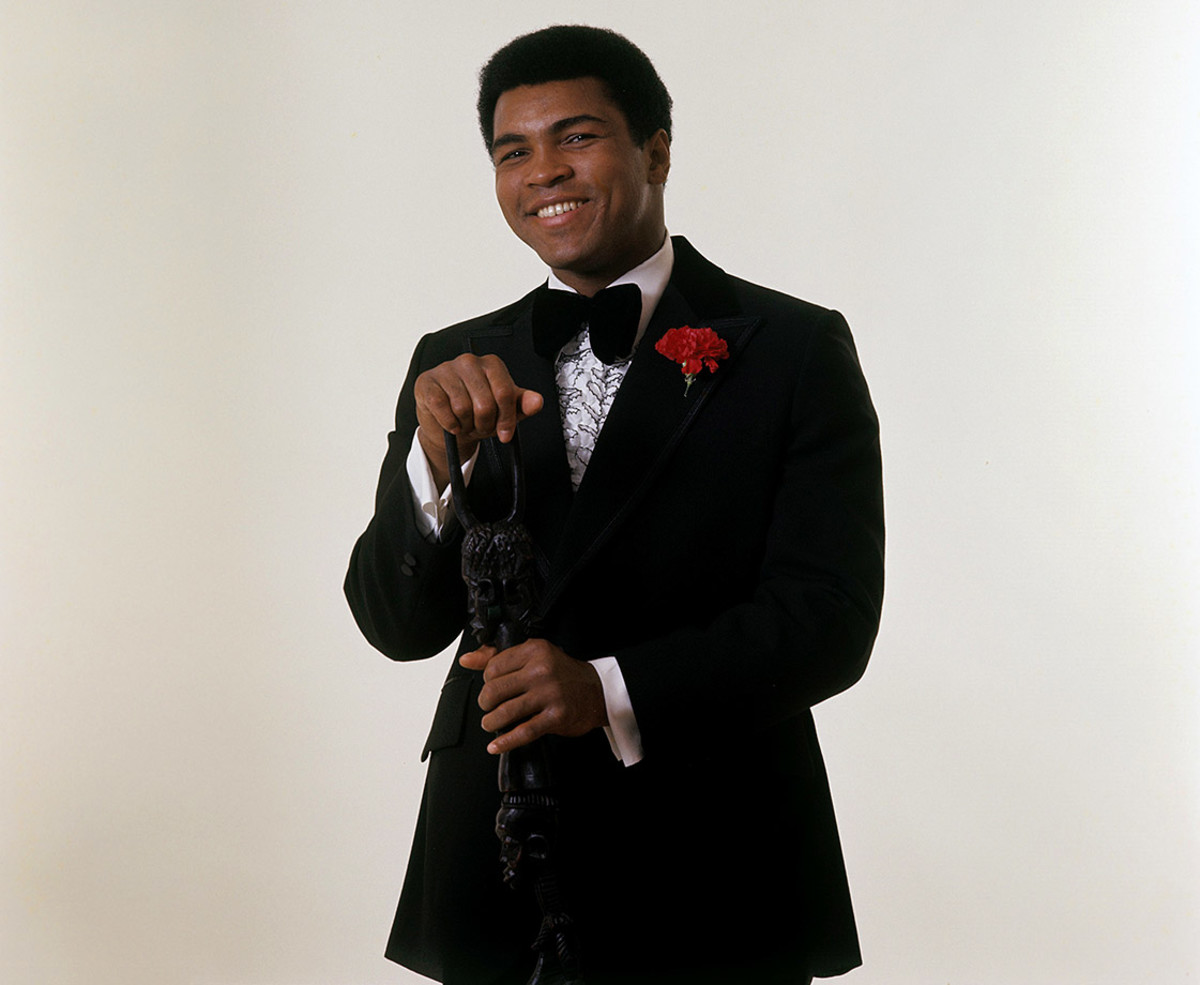
This time Ali wears a tuxedo, but keeps the walking stick, during the November photo shoot for Sports Illustrated's Sportsman of the Year.
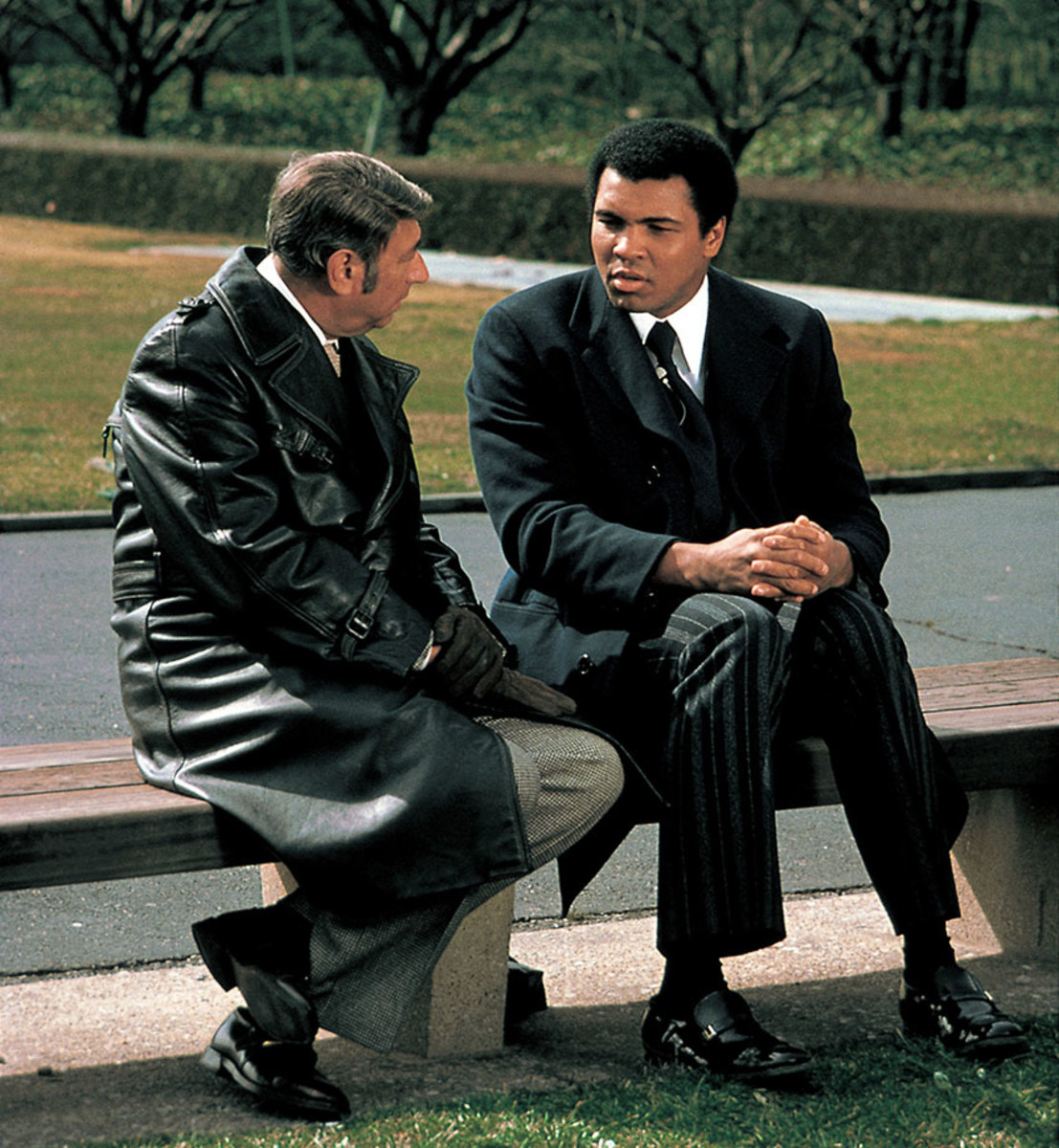
Ali talks with Howard Cosell outside of the United Nations Headquarters for a segment on the Wide World of Sports. Later that day, Ali held a press conference to announce that he would donate part of the proceeds from his fight against Chuck Wepner to help Africans in the Sahel drought.
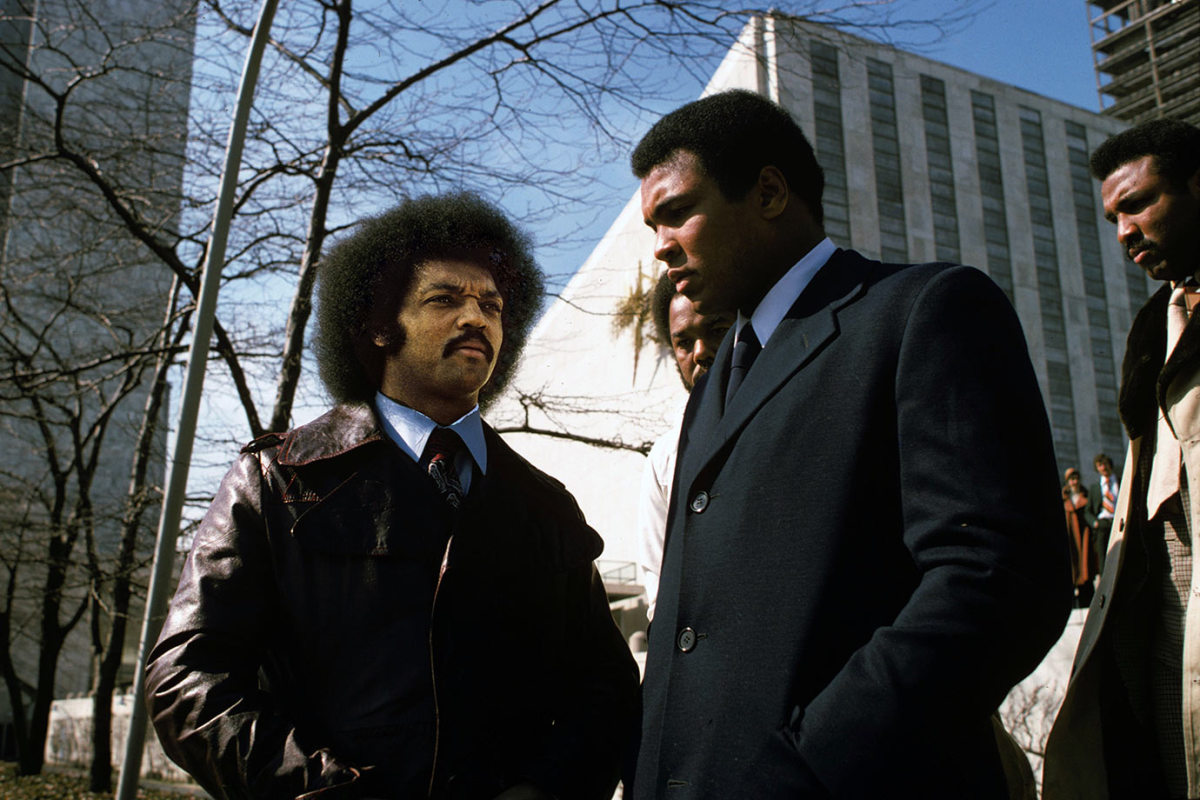
Ali talks with Reverend Jesse Jackson outside of the United Nations Headquarters before a press conference to announce that he would donate part of the proceeds from his fight against Chuck Wepner to help Africans in the Sahel drought.
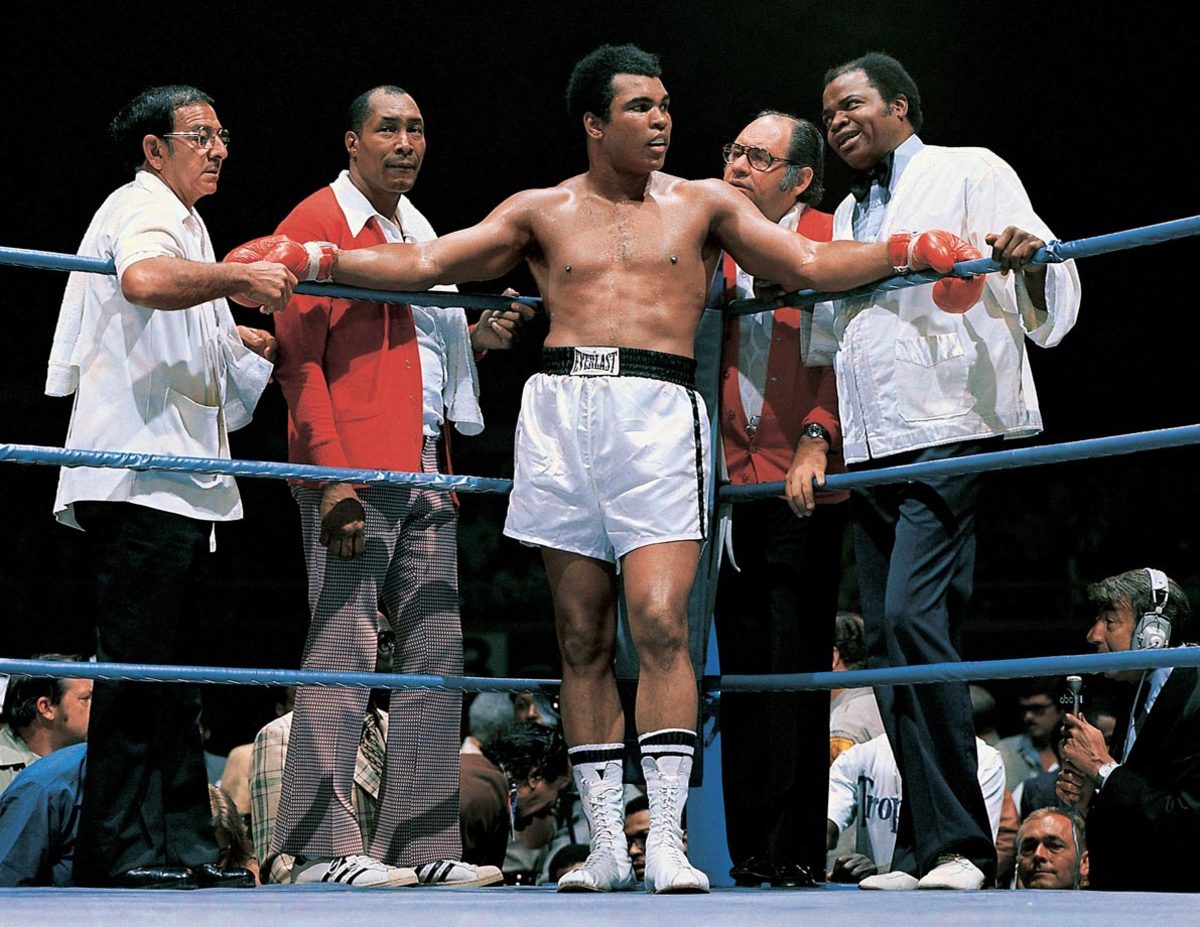
Ali stands with trainer Angelo Dundee, assistant trainer Wali Muhammad, physician Dr. Ferdie Pacheco and assistant trainer Drew Bundini Brown before his bout with Ron Lyle in May 1975. Ali won the fight by technical knockout in the 11th round.
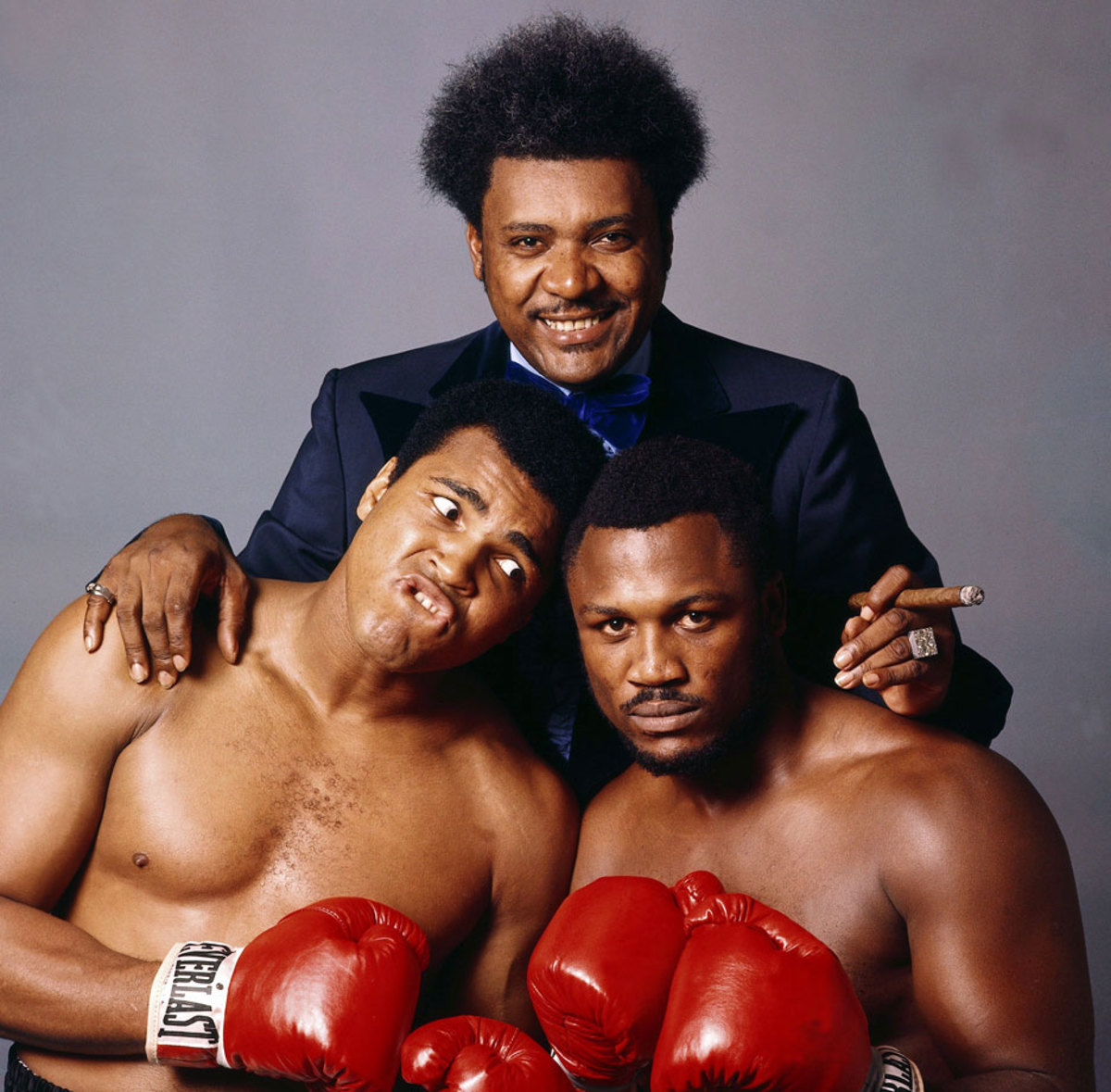
Along with Don King and Joe Frazier, Ali sat for a portrait leading up to the Thrilla in Manila. Ali verbally abused Frazier during the buildup to the fight, telling the media that "it will be a killa and a thrilla and a chilla when I get the gorilla in Manila."
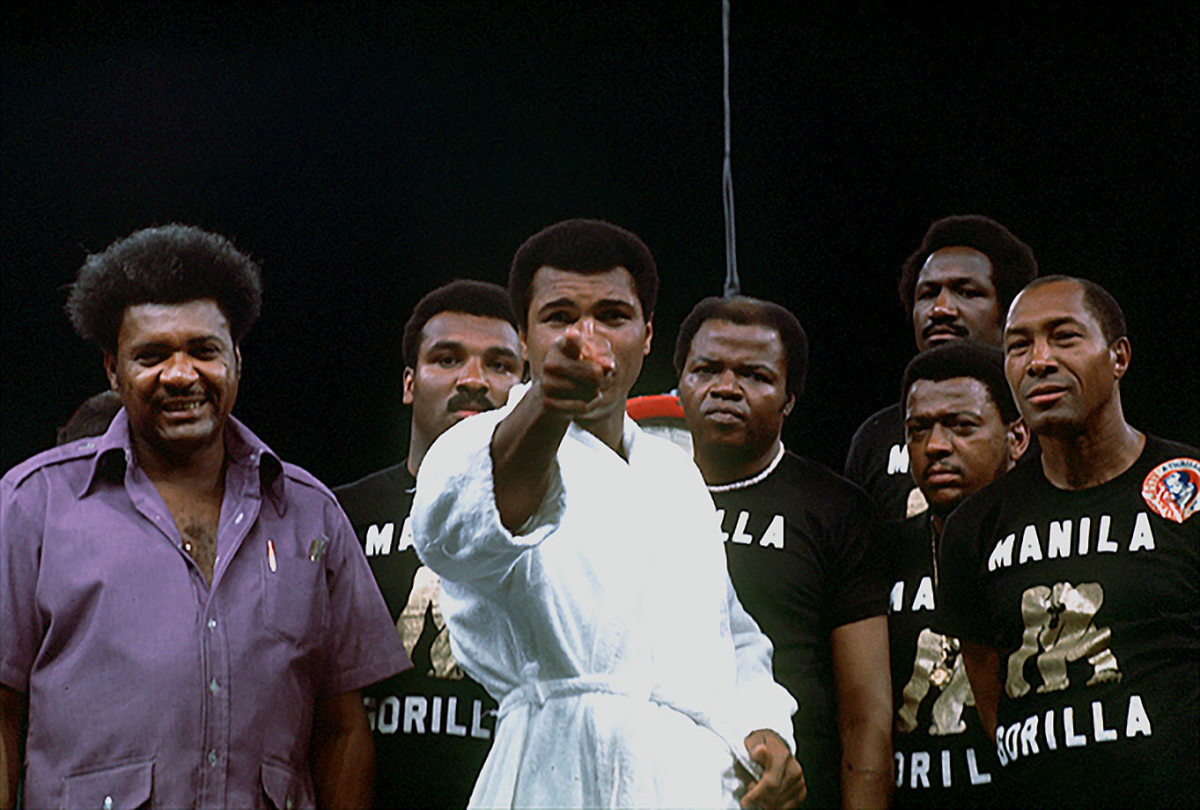
Ali points at the camera with Don King and his training staff behind him before the weigh-in for the Thrilla in Manila in October 1975. Philippine president Ferdinand Marcos offered to sponsor the bout and hold it in Metro Manila to divert attention from the turmoil in the country that had forced the imposition of martial law in 1972.
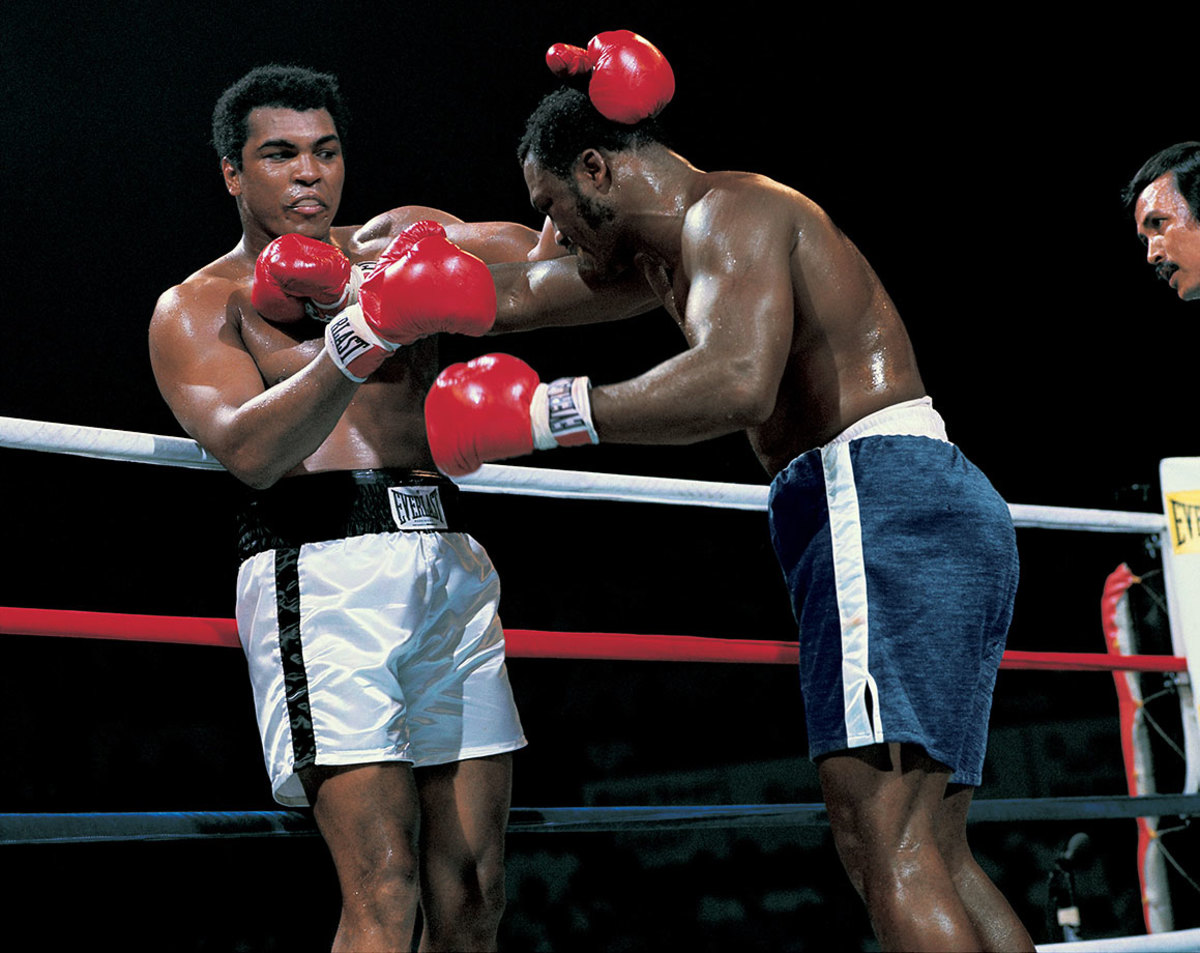
Wrapping up Joe Frazier proved more difficult than Ali expected, having thought Frazier would represent an easy payday and be unable to live up to his billing. The fight turned out to be a brutal affair.
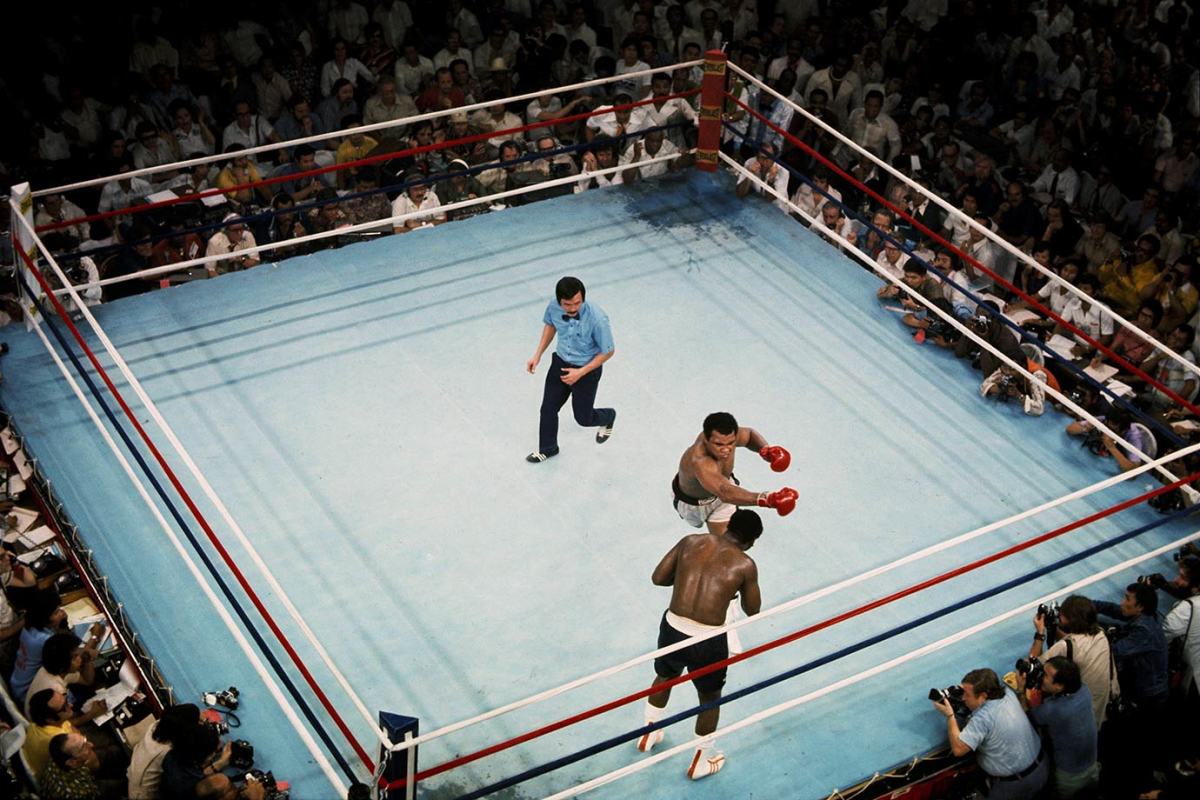
Frazier faces an Ali right hook in their fight in Quezon City, Philippines. The two fighters traded vicious blows during their 14 rounds. "Man, I hit him with punches that'd bring down the walls of a city," Frazier said. Ali withstood the blows to win by TKO in the 15th round.
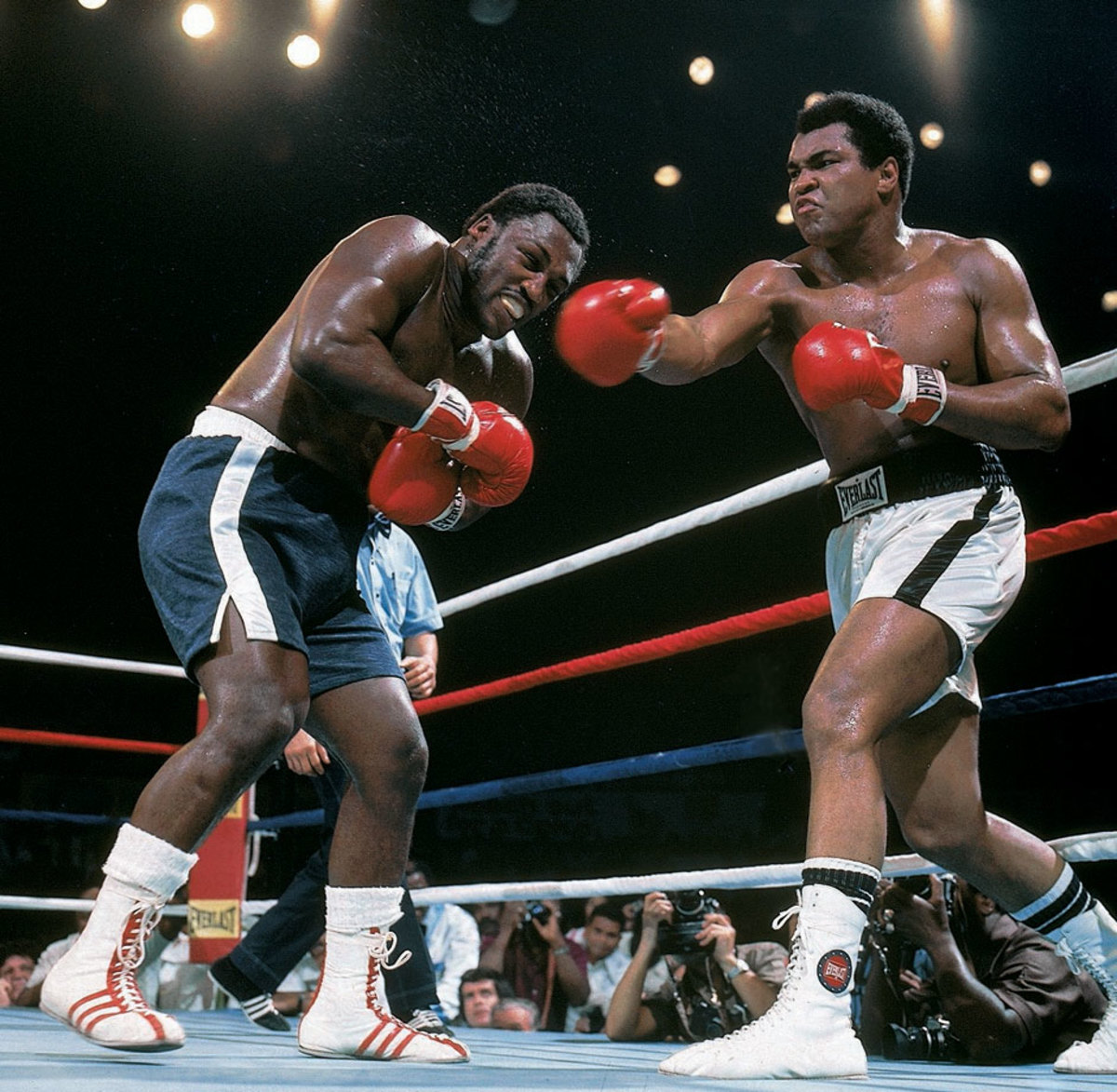
The third fight between Ali and Frazier, Ali won the bruising battle between the two powerful punching heavyweights when Frazier's trainer, Eddie Futch, stopped the fight before the 15th round.
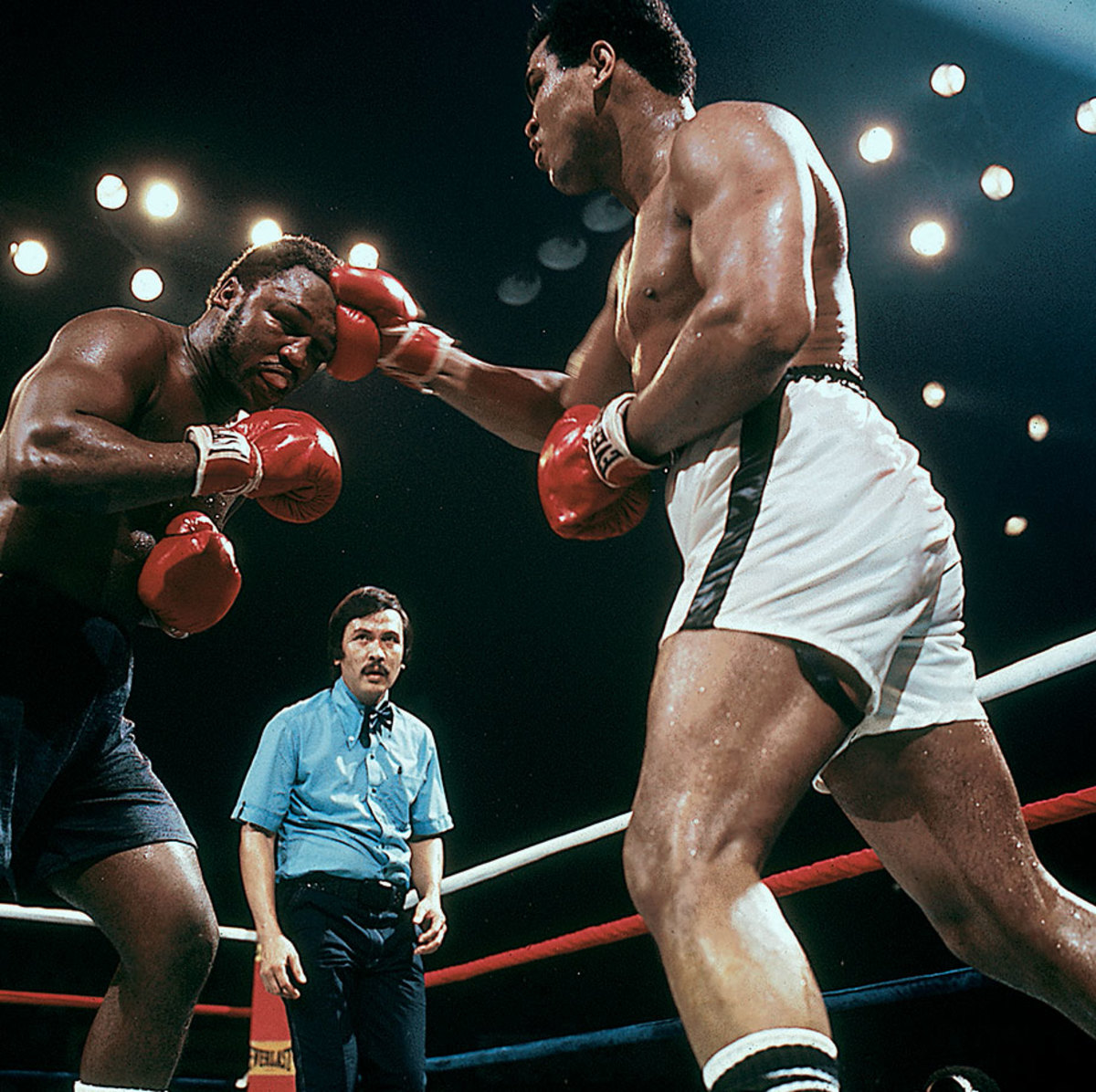
A back and forth exchange, Ali controlled the early rounds of the Thrilla in Manila before Frazier fought back with powerful hooks. Ali finished strong, regaining momentum in the later rounds.
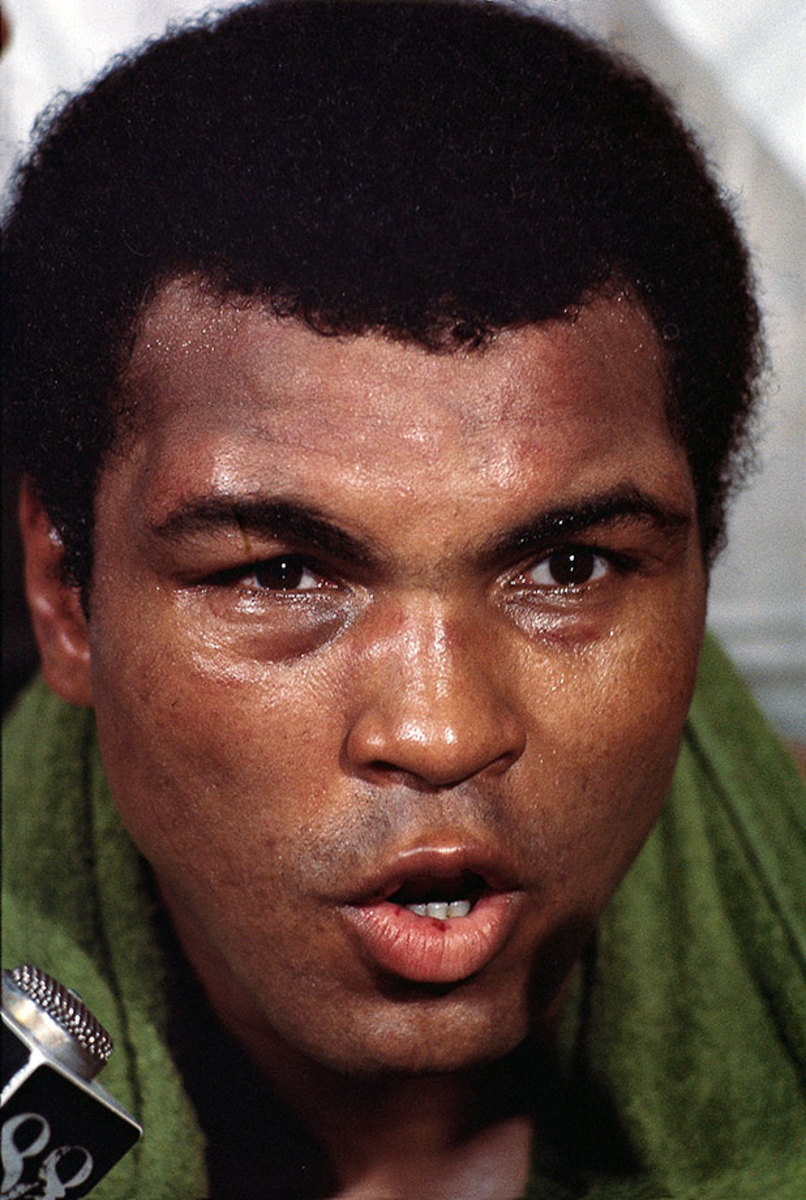
Ali speaks to the press after winning the Thrilla in Manila bout with Frazier.
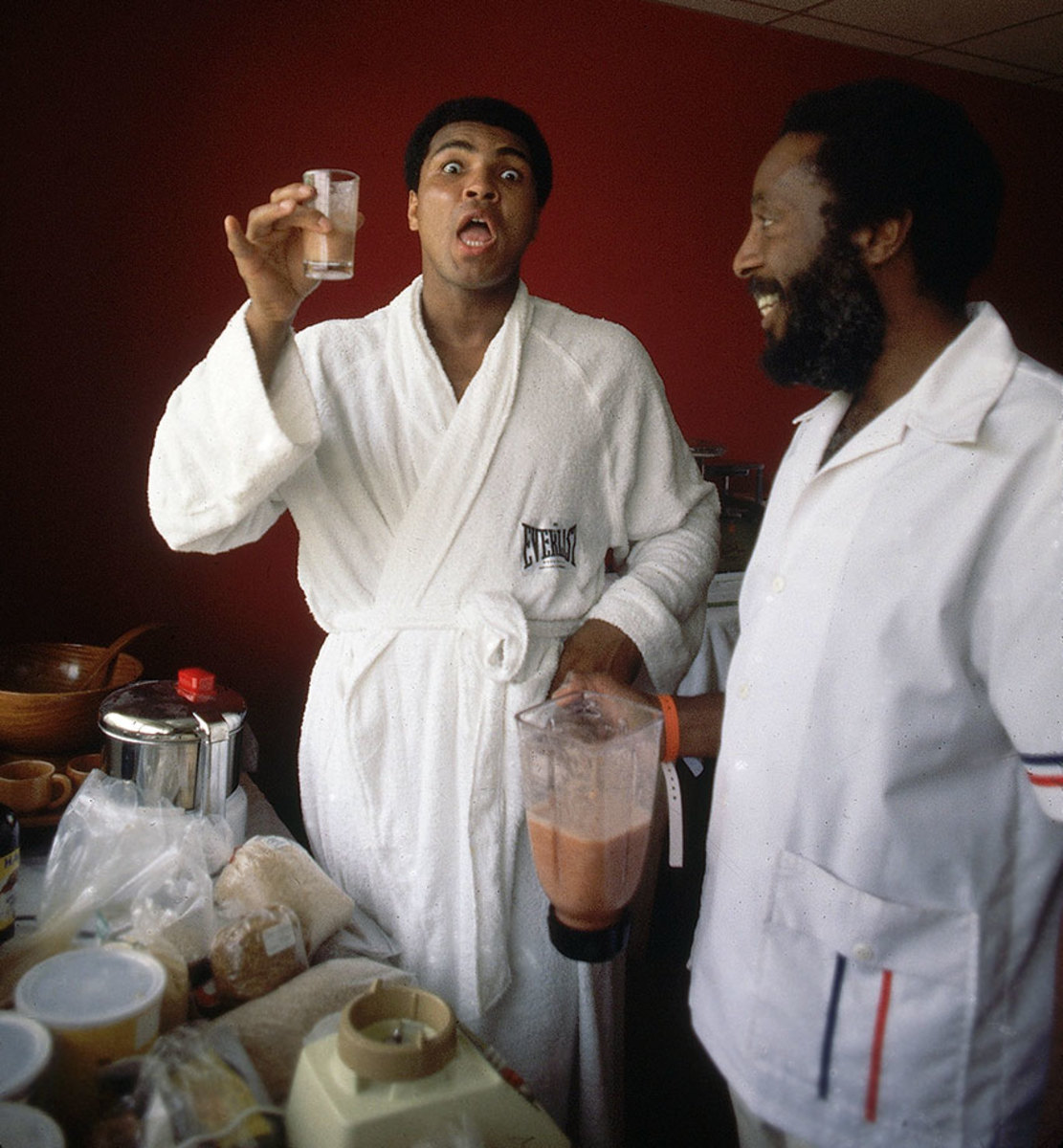
Ali holds a drinking concoction given to him by Dick Gregory, an advocate of a raw fruit and vegetable diet, in 1976.
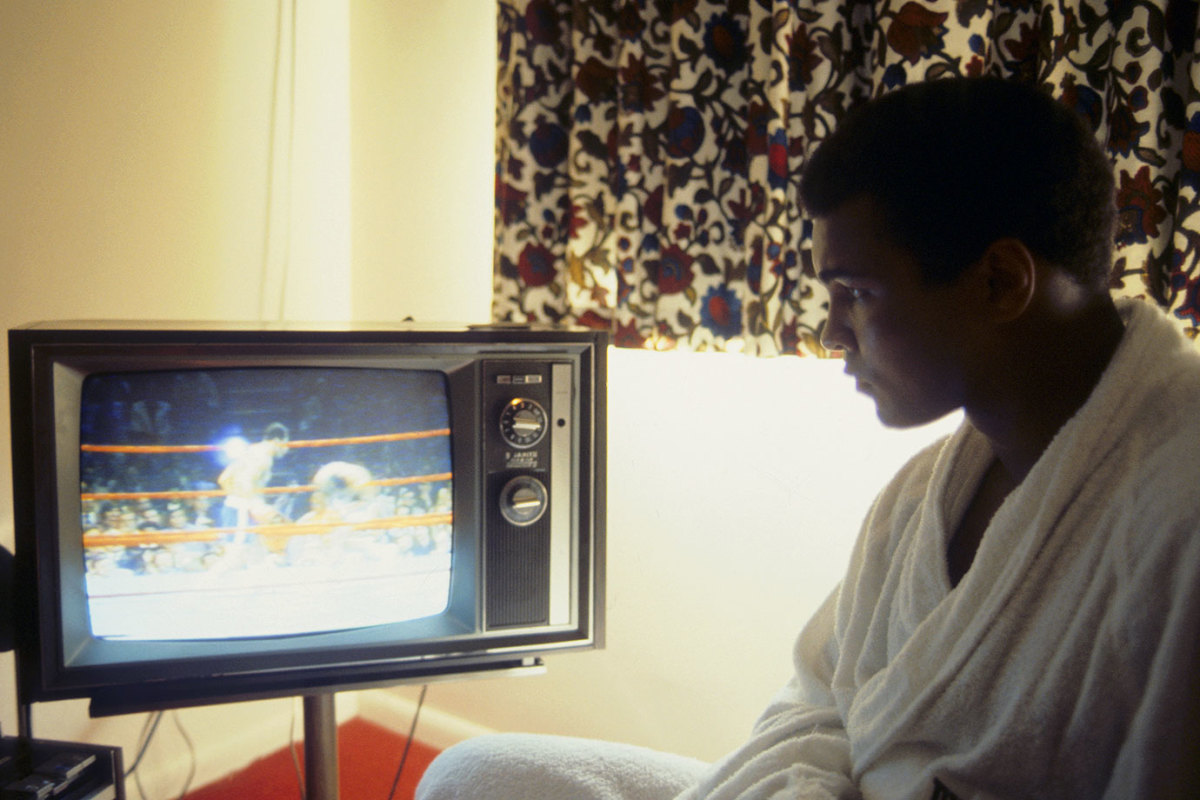
Before his 1976 fight against Ken Norton at Yankee Stadium, Ali watches a fight on television from his hotel room. A police strike at the time of the fight created a dangerous environment outside the stadium that all but eliminated walk-up sales.
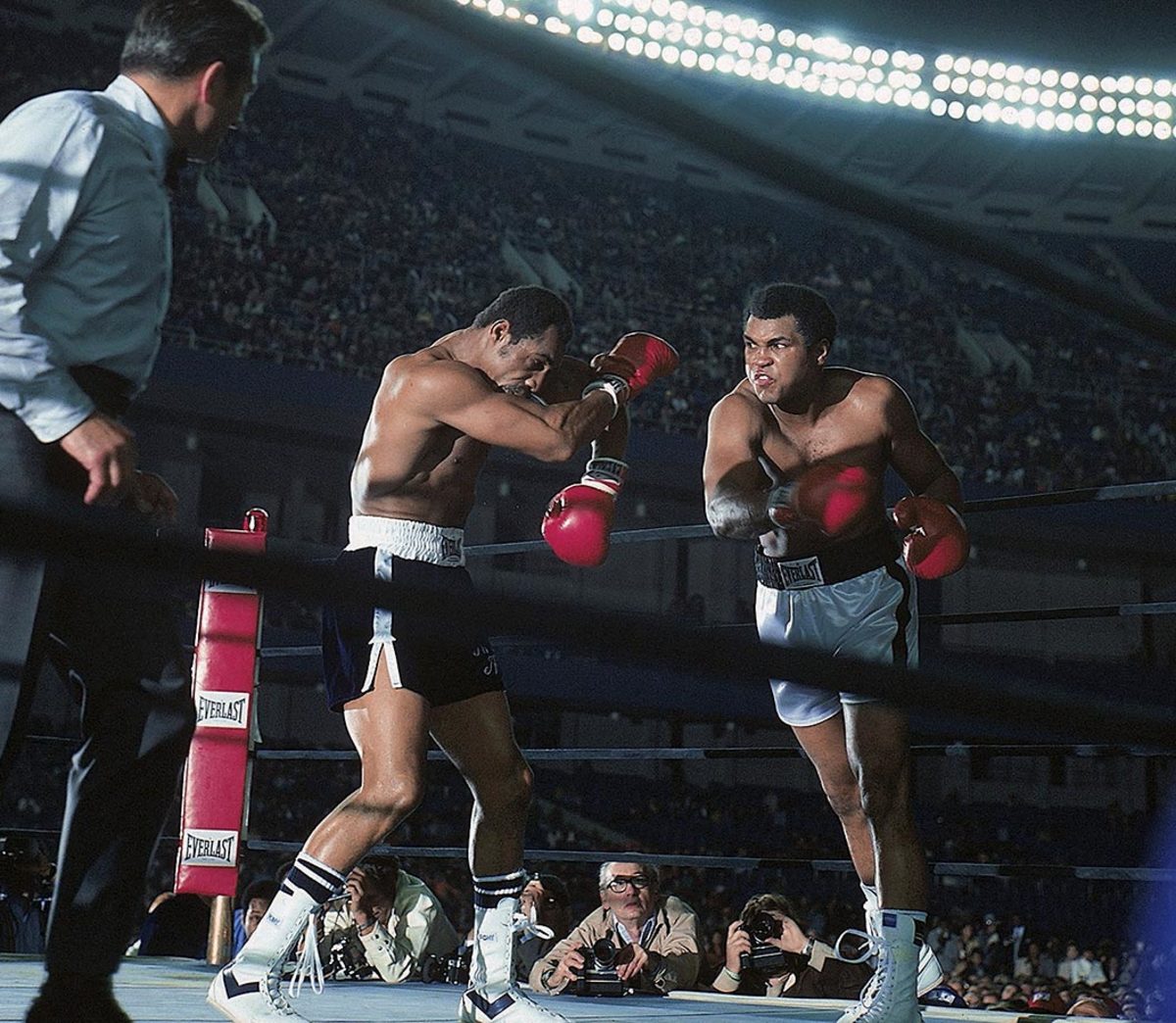
Norton takes a right hook during the heavyweight title fight against Ali. The bout, which Ali won by a unanimous, but controversial, decision, was the last boxing match at Yankee Stadium until 2010.
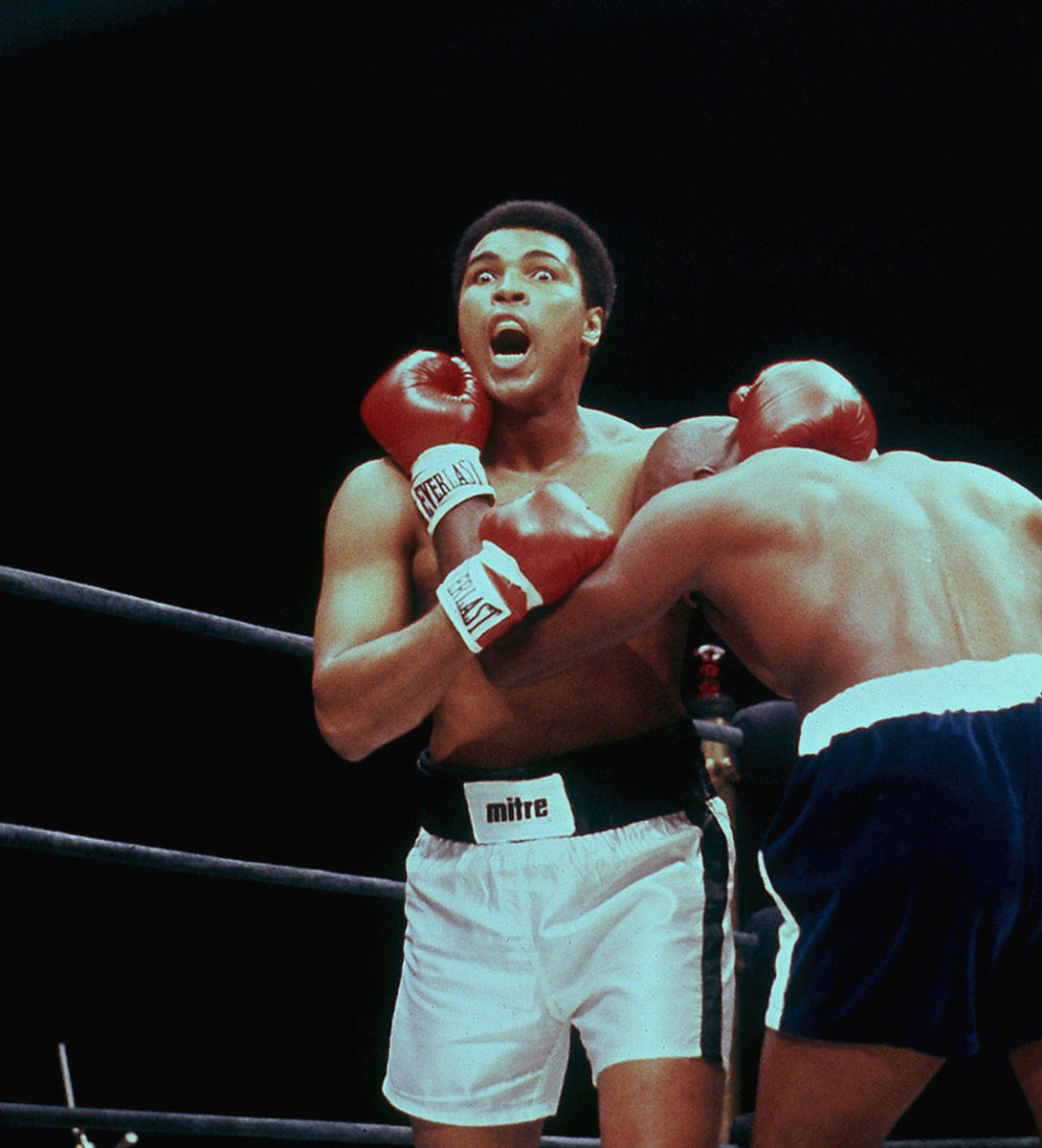
Ali makes a face during his fight with Earnie Shavers in 1977 at Madison Square Garden. Hurt badly by Shavers in the second round, Ali rebounded and outboxed Shavers throughout to build a lead on points before Shavers came on again in the later rounds. Seemingly exhausted going into the 15th and final round, Ali remained victorious by producing a closing flurry that left Shavers wobbling at the bell and the Garden crowd once again in delirium over his Ali magic.
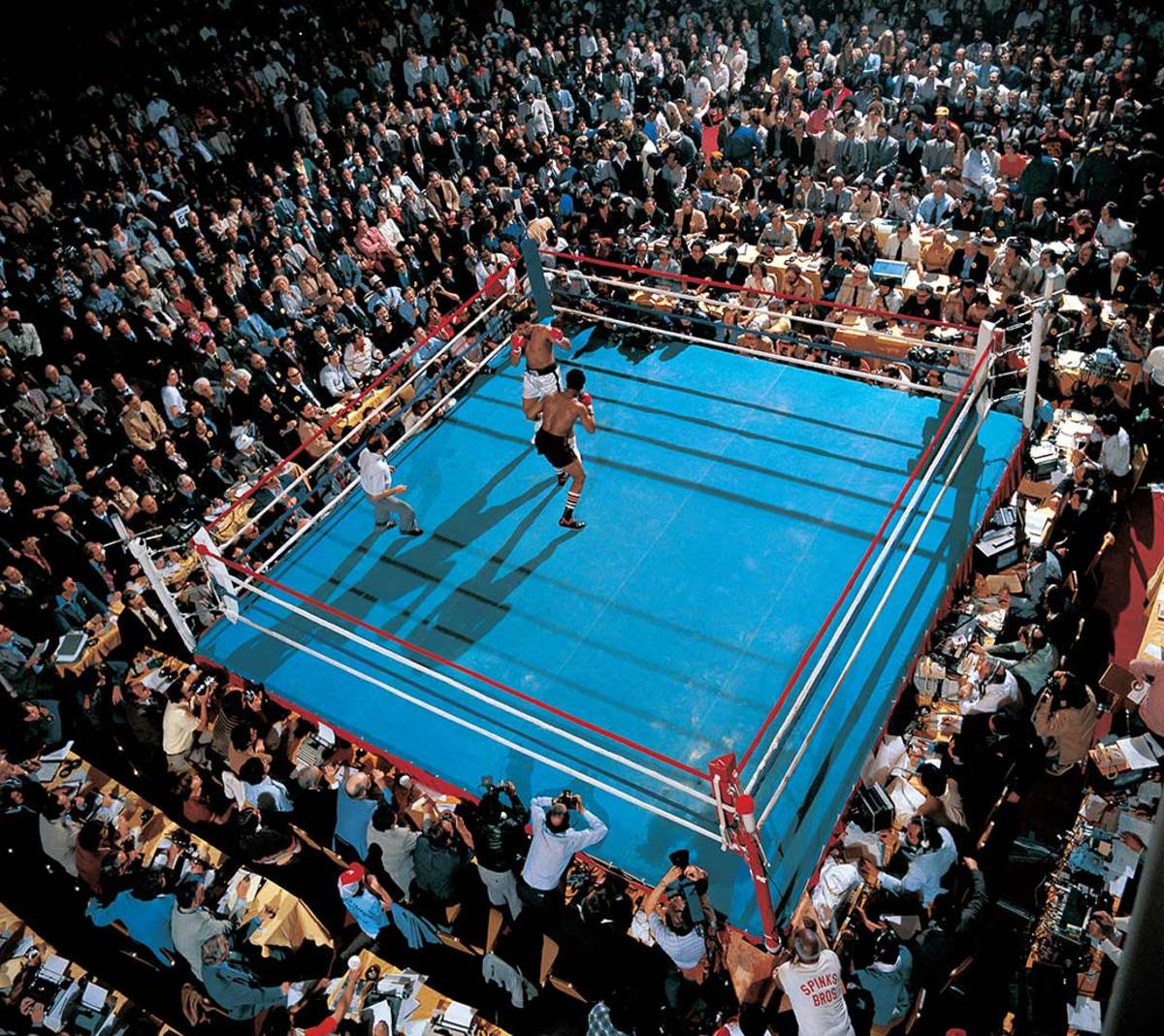
Ali squares off with Leon Spinks at the Las Vegas Hilton Hotel in February 1978. Spinks won the fight in a split decision, ending Ali's 3.5-year reign as the heavyweight champion. It was the only time in Ali's career that he lost his championship title in the ring.
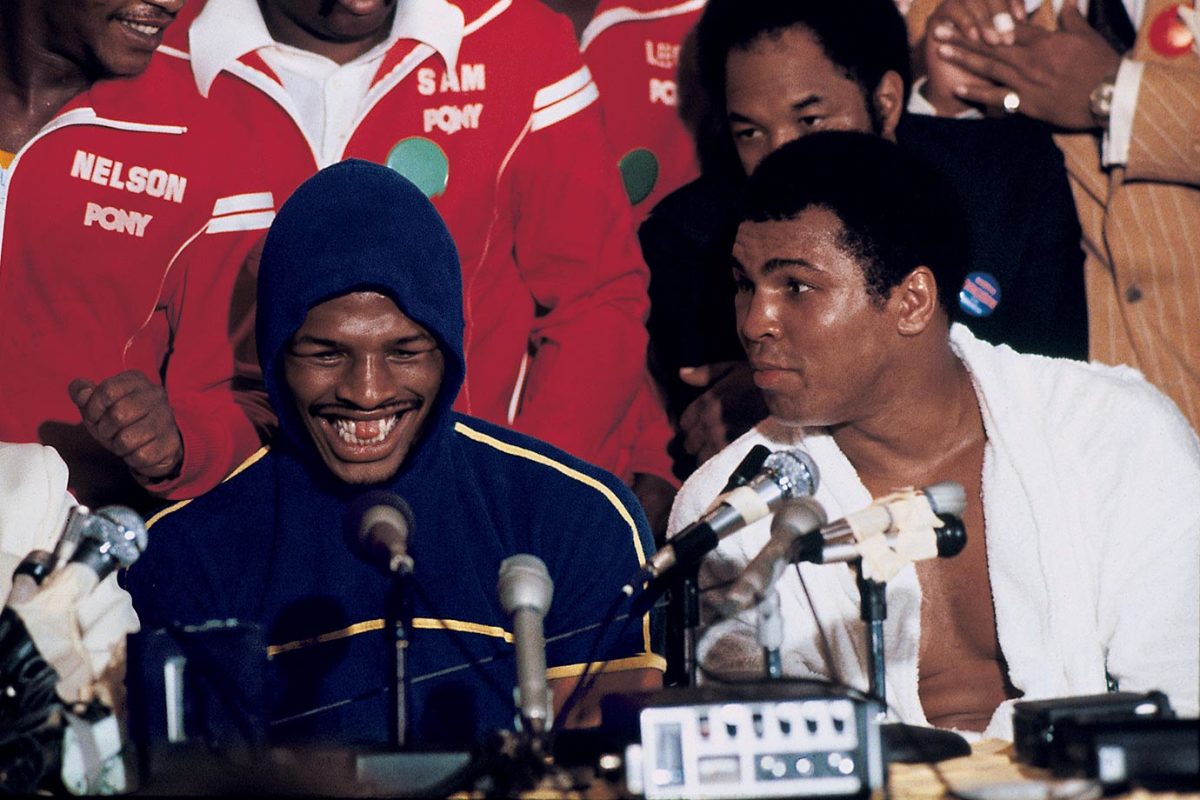
Leon Spinks took center stage over Ali at the press conference after their fight. The victorious Spinks and his gap-toothed grin were featured on the Feb. 19, 1978 cover of Sports Illustrated.
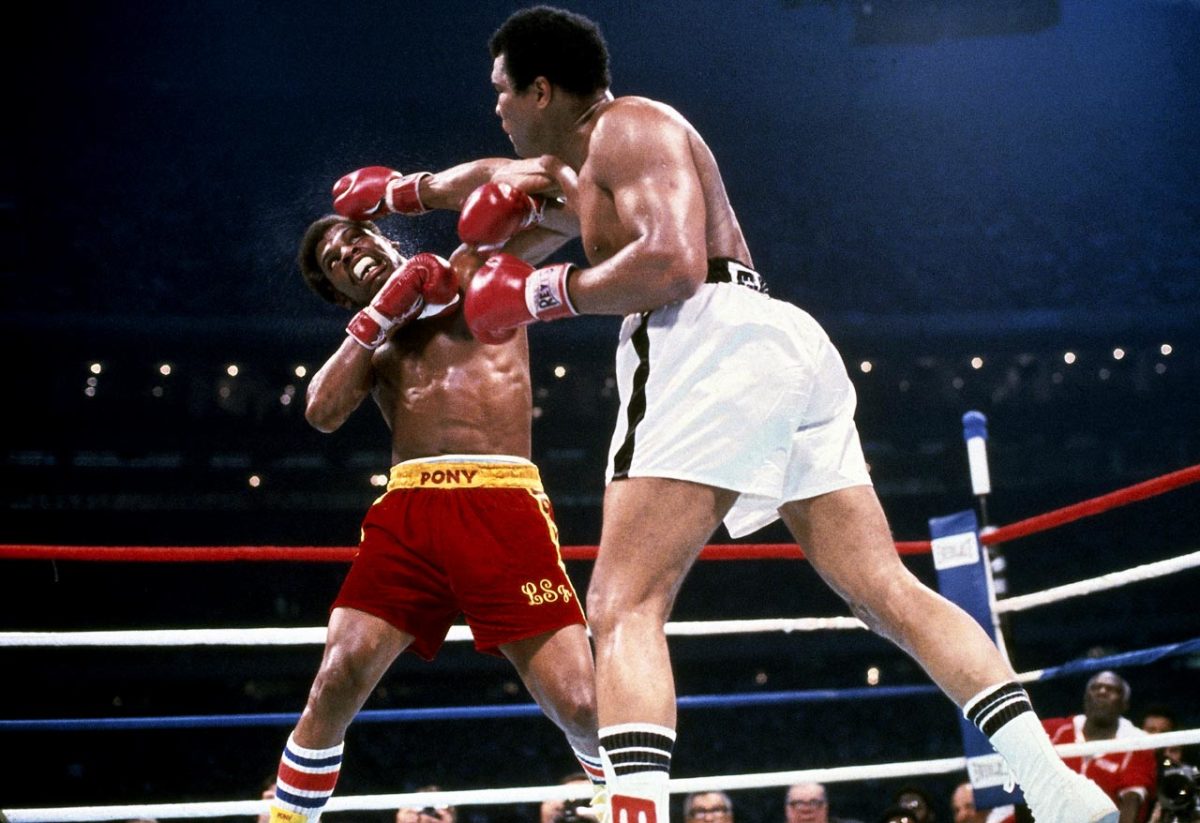
Ali lands a straight right hand to the head of Spinks in the rematch of their title bout in 1978. Ali won on a 15 round decision.
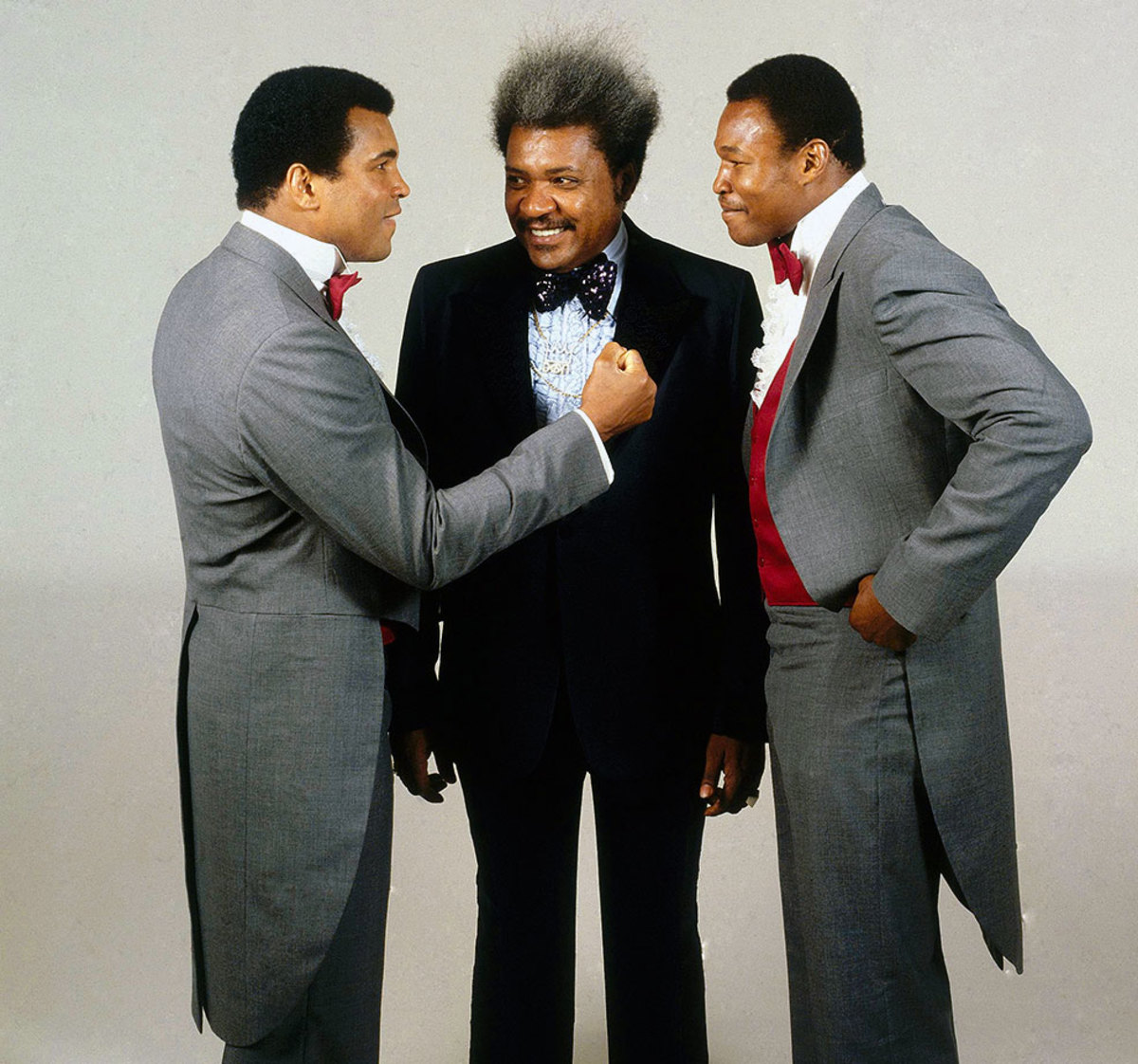
Don King pulled the strings again when Ali faced Larry Holmes before their November 1980 fight. King became a key figure in Ali's career, promoting his biggest fights, the Thrilla in Manila and the Rumble in the Jungle.
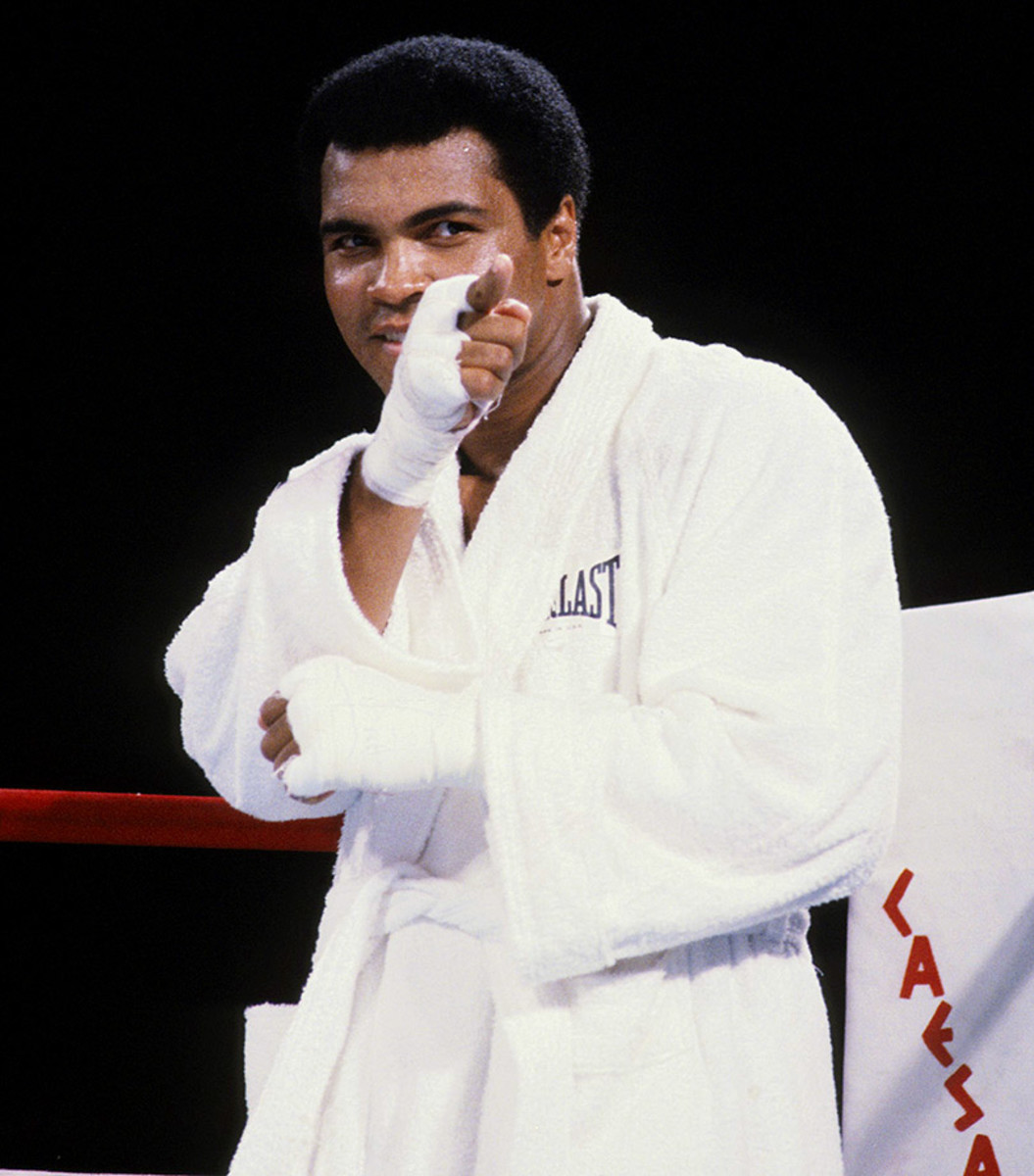
Ali points at Larry Holmes before their bout at Caesars Palace in 1980.
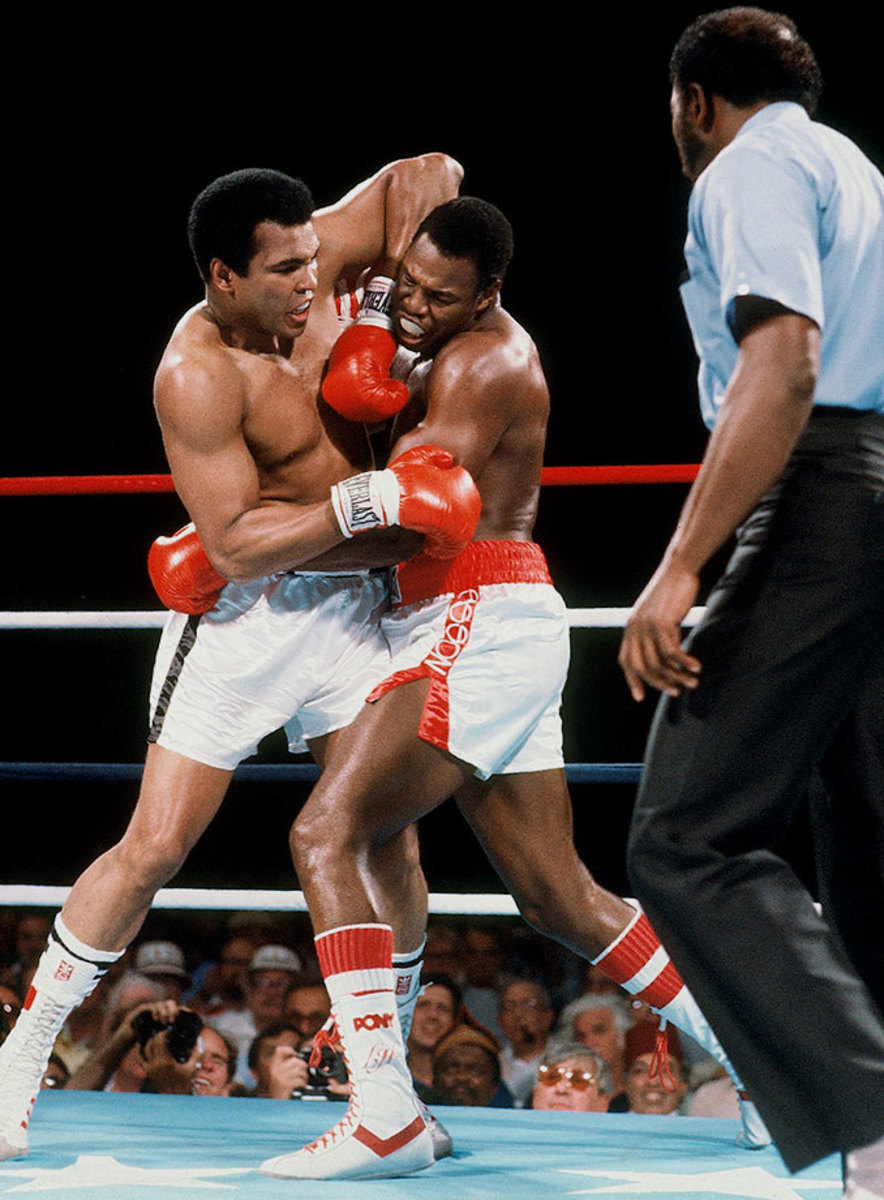
Ali grapples with Holmes during their bout in 1980. Trainer Angelo Dundee stopped the fight in the 11th round, marking the fight as Ali's only career loss by knockout.
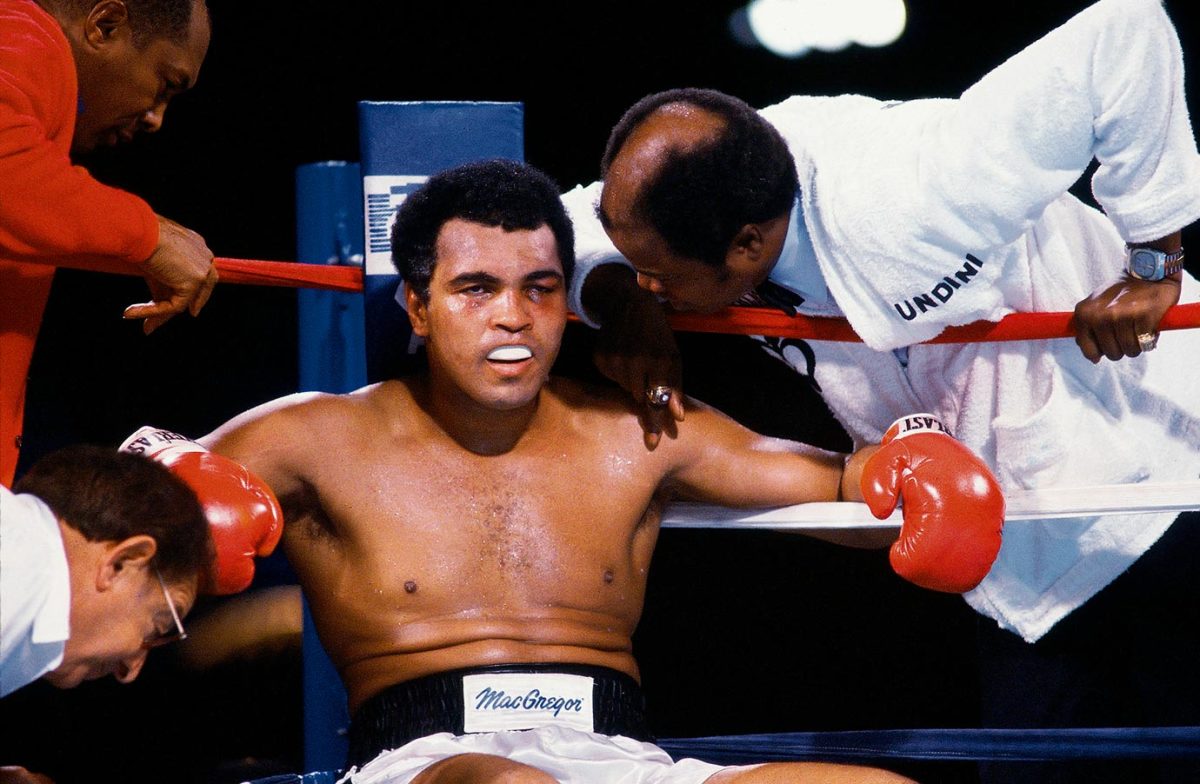
Drew Bundini Brown leans in to speak to Ali, who returned to fight Holmes after a brief retirement. By this time, Ali had already begun developing a vocal stutter and trembling hands and taken thyroid medication to lose weight that left him tired and short of breath.
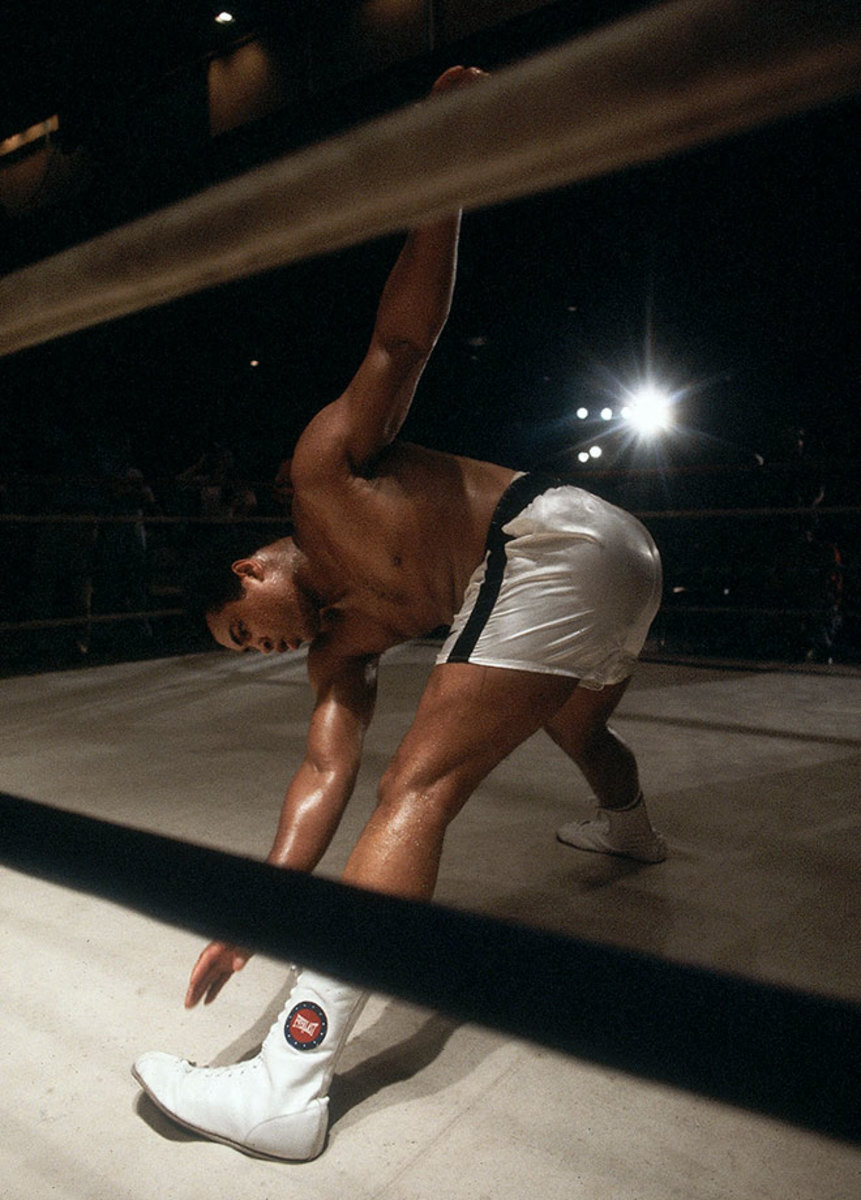
Ignoring pleas for his retirement, Ali stretches before a fight against Trevor Berbick in Nassau, Bahamas. Ali lost to Berbick in a unanimous decision and retired after the bout, the 61st of his career.
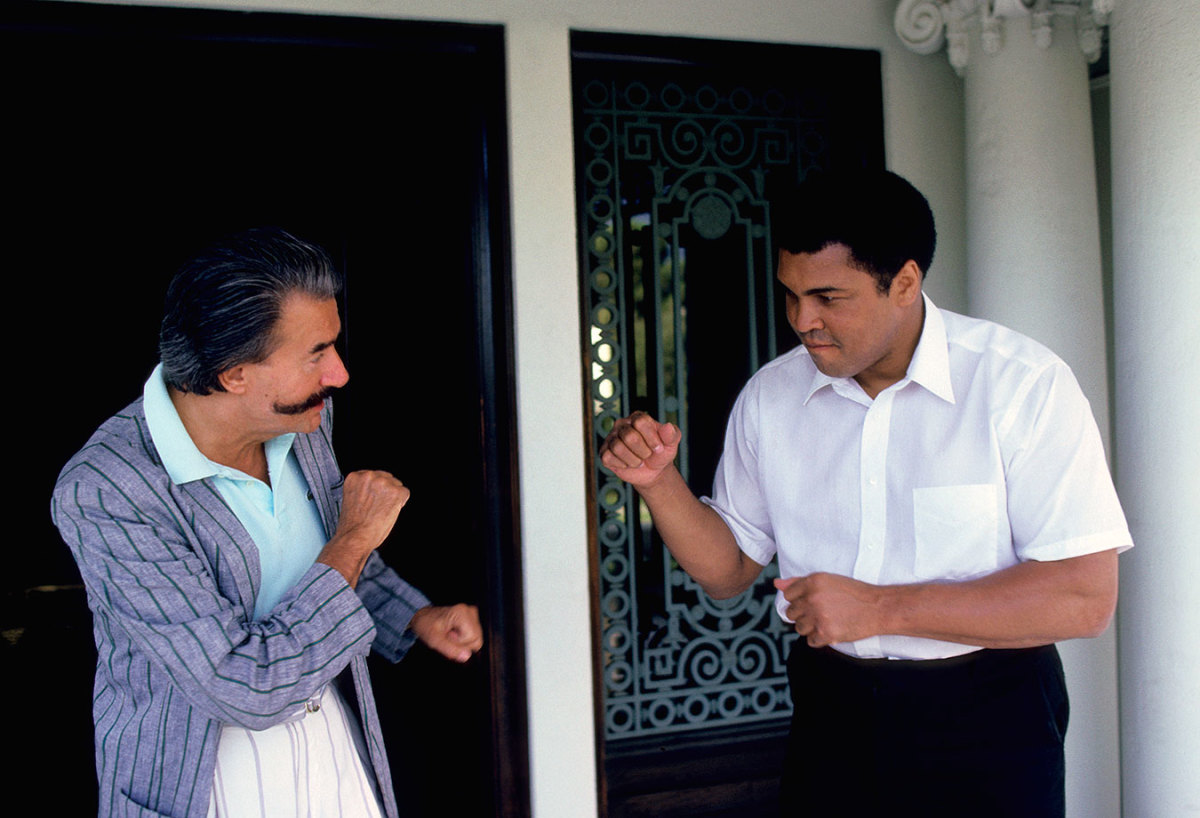
Ali pretends to spar with artist LeRoy Neiman at his home in Los Angeles. Neiman met Ali in 1962 and made many paintings and sketches from throughout Ali's life.
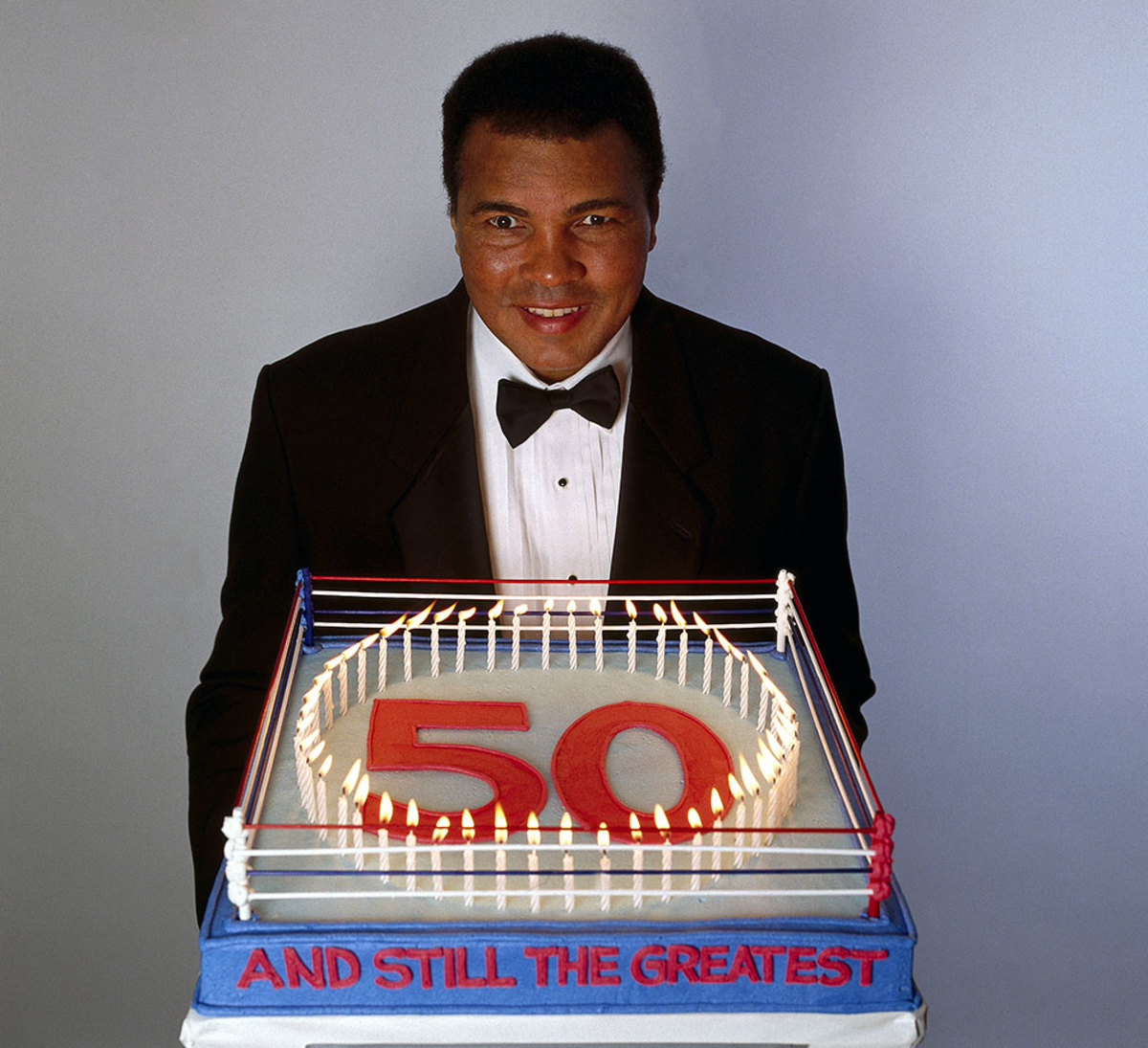
Cake in hand, Ali poses for a 50th birthday portrait in 1991. Although diagnosed with Parkinson's syndrome seven years earlier, Ali was still active, traveling to Iraq during the Gulf War to meet with Saddam Hussein in an attempt to negotiate the release of American hostages.
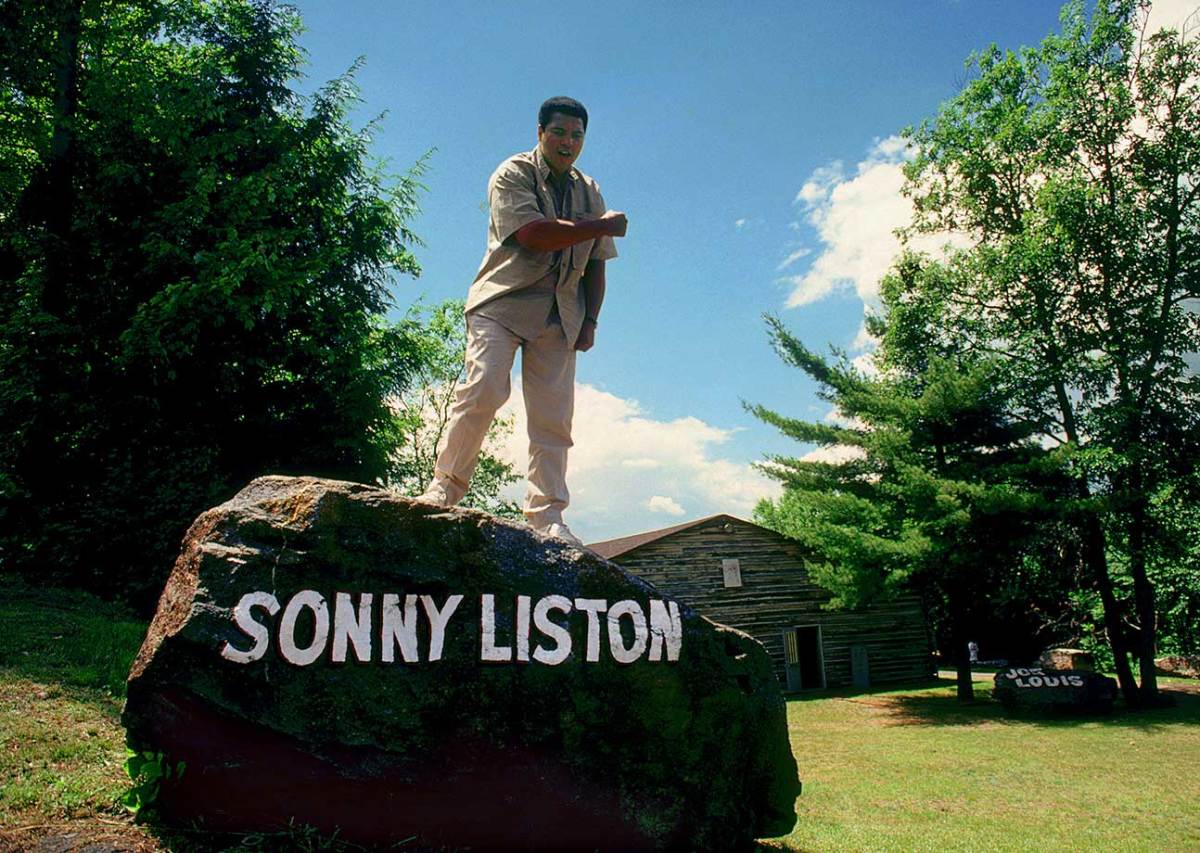
The same year, Ali stands atop of the Sonny Liston rock at his old training camp cabin. Ali and his father painted the names of famous boxers he admired on 18 boulders at the camp.
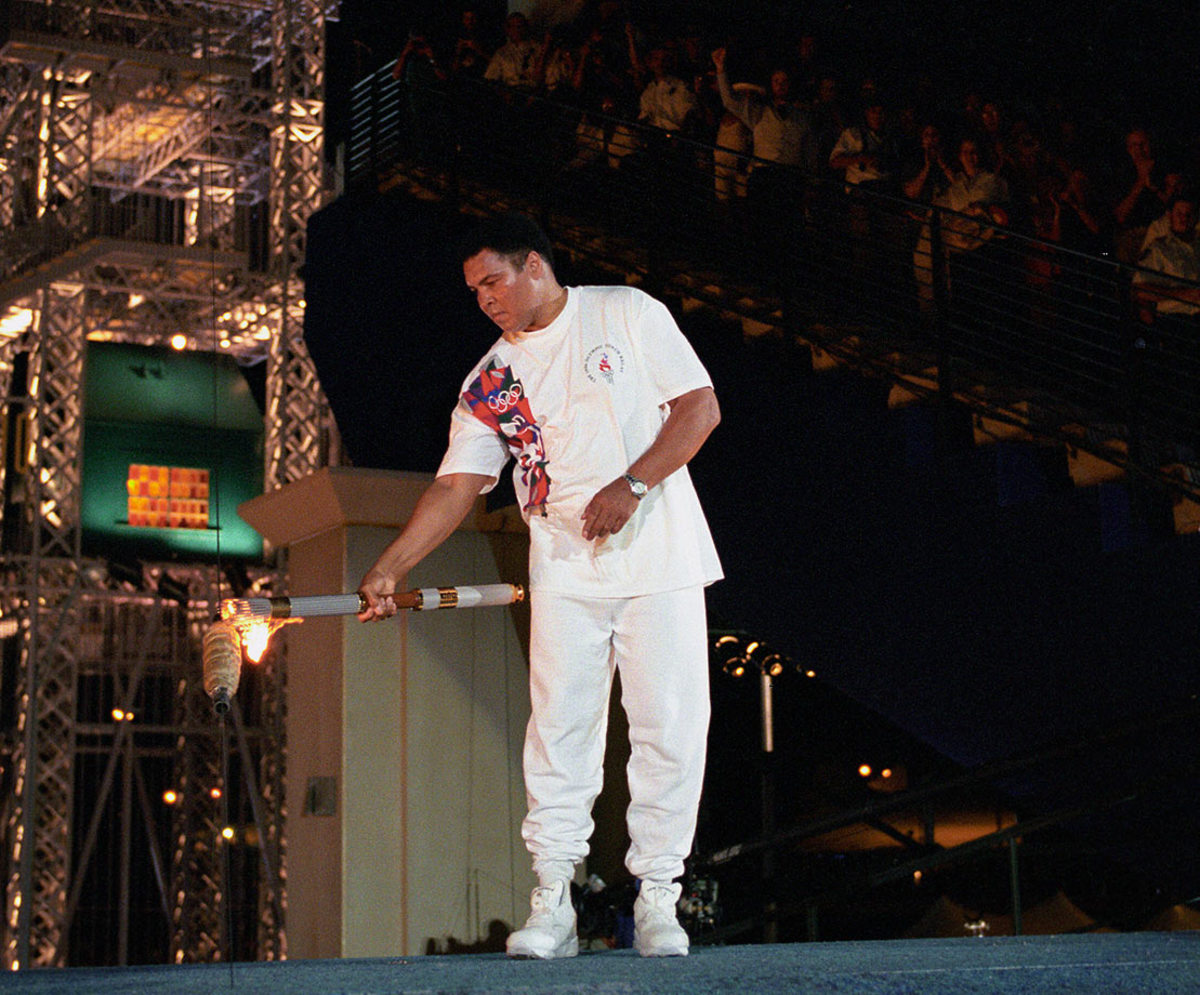
Ali carries the Olympic torch inside Centennial Olympic Stadium at the 1996 Atlanta Olympics. Despite trembling hands, Ali had the honor to light the Olympic flame in the stadium.
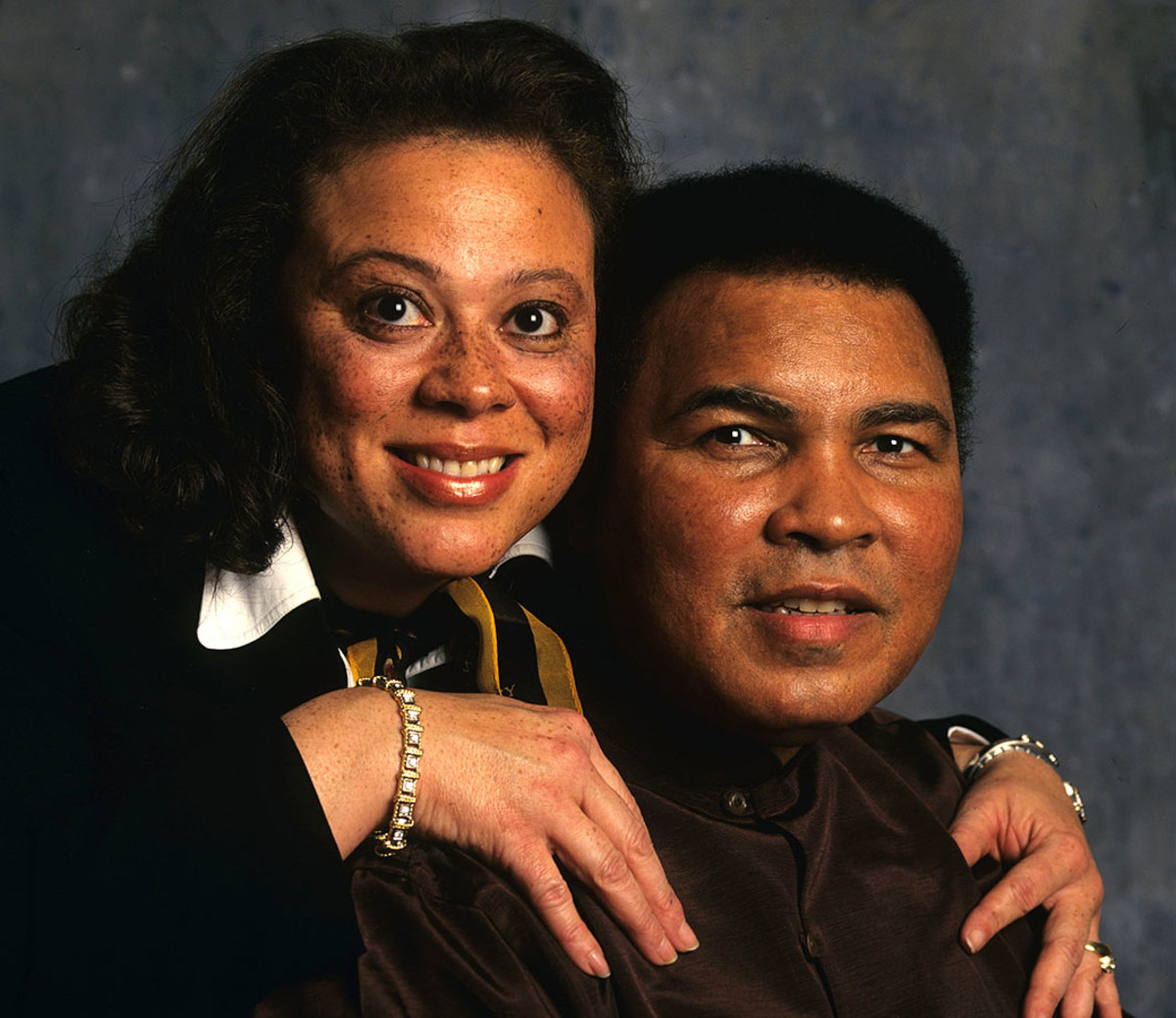
Husband and wife pose for a portrait during a photo shoot in 1997. Muhammad and Lonnie married in 1986 and have an adopted son together, Asaad Amin Ali.
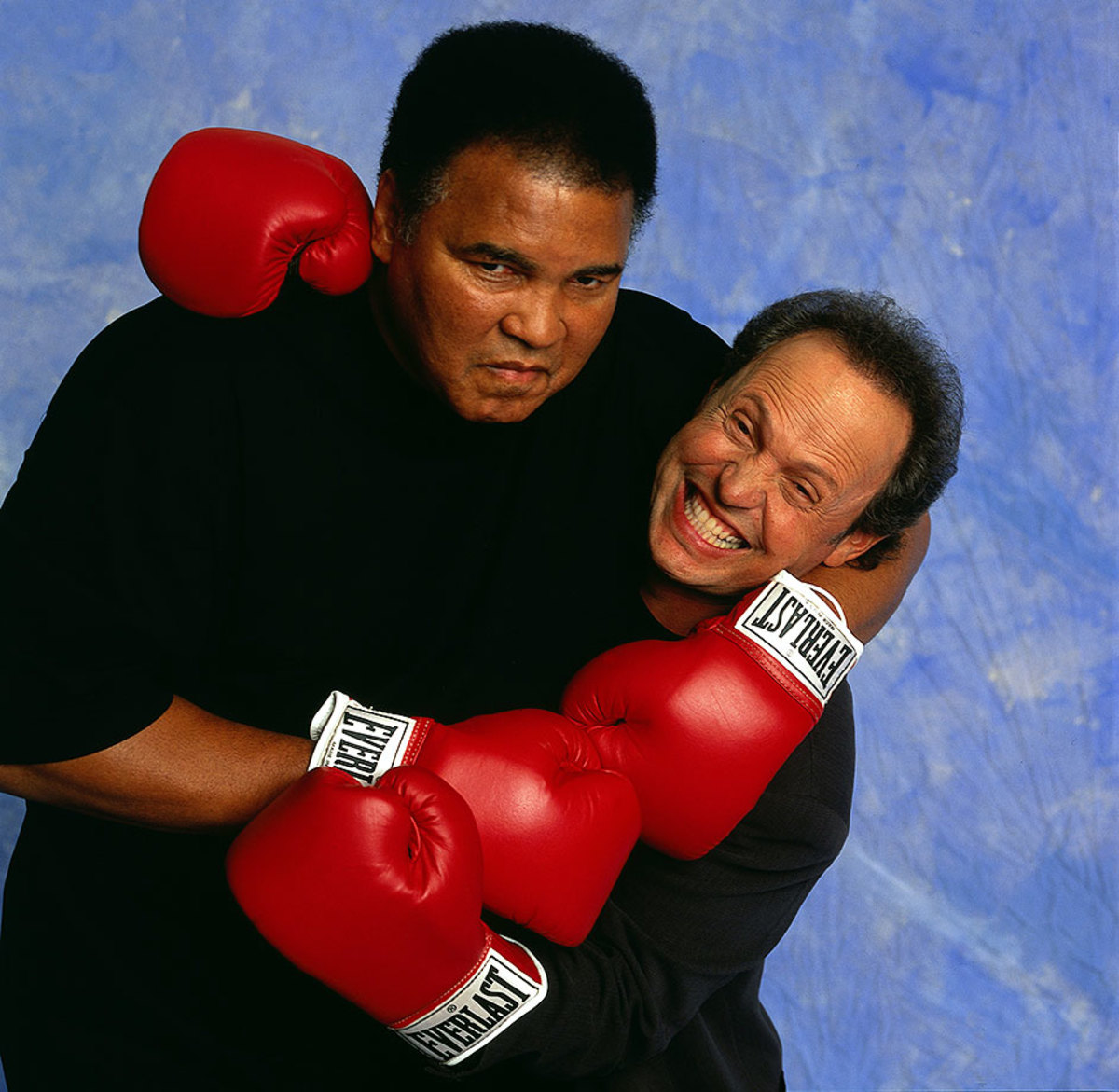
Ali messes around with actor Billy Crystal during a photo shoot in 2000. Crystal's impression of Ali was notorious, and he performed at a tribute to the boxer on his 50th birthday in December 1991.
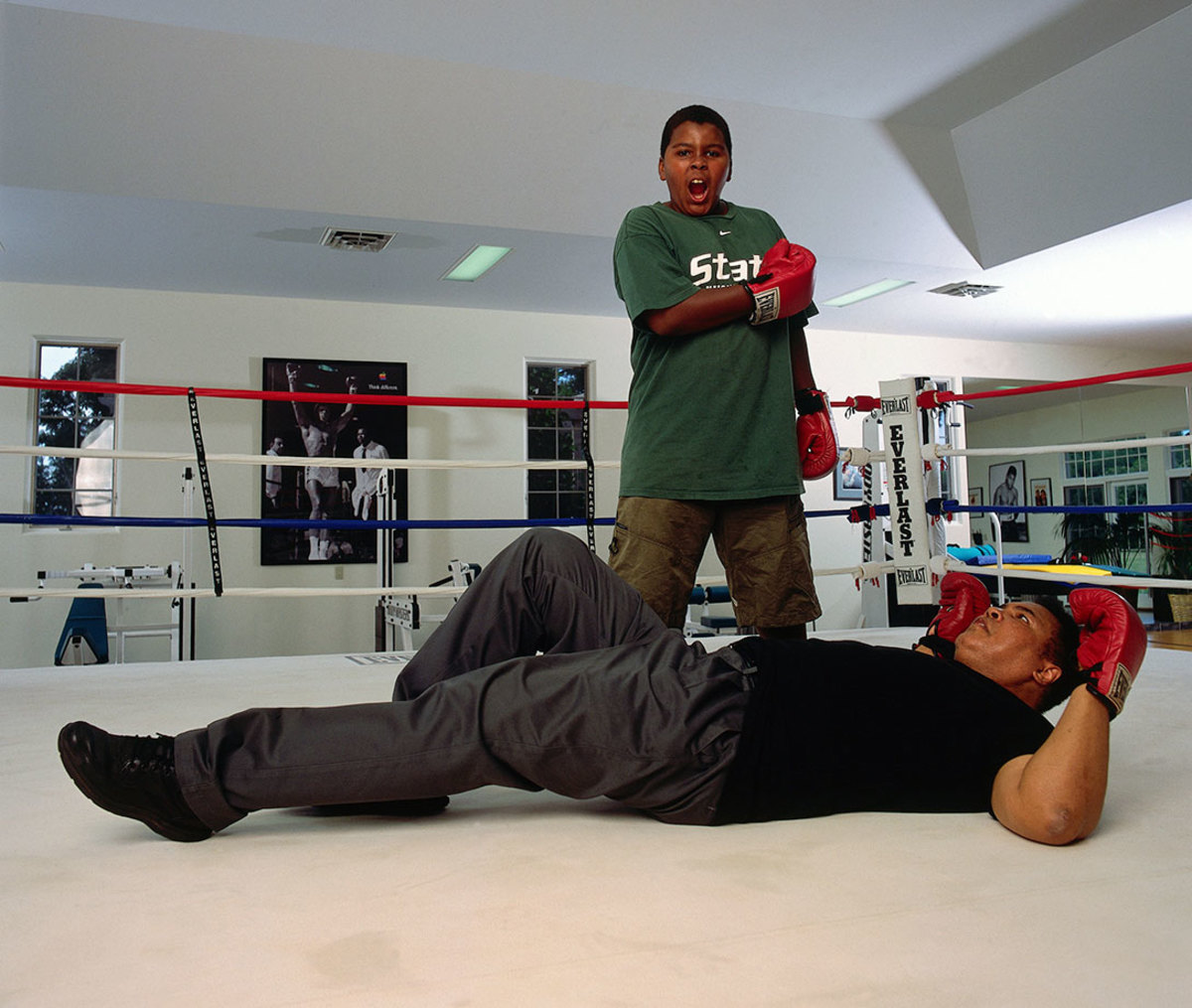
Ali lies on the canvas as his son, Assad Amin Ali, stands over him invoking memories of Ali's victory over Sonny Liston during a photo shoot in the gym at his farm on Kephart Road near Berrien Springs in 2001.
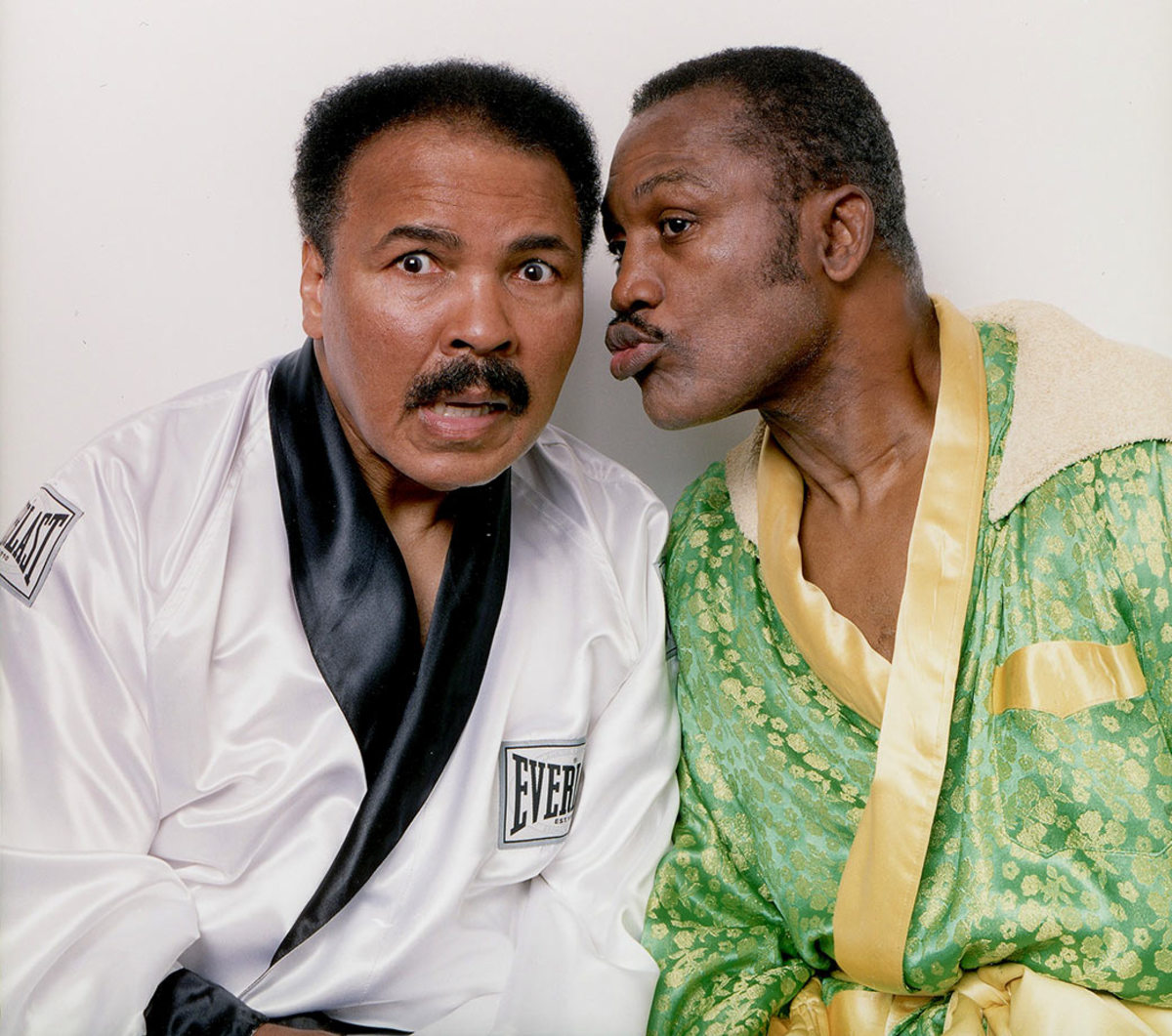
Fierce rivals in the ring, Ali and Joe Frazier pose for a portrait in the boxing robes they wore the night of their first bout at Frazier's Gym in 2003. Ali said after Frazier's death in 2011 that he was "a great champion."
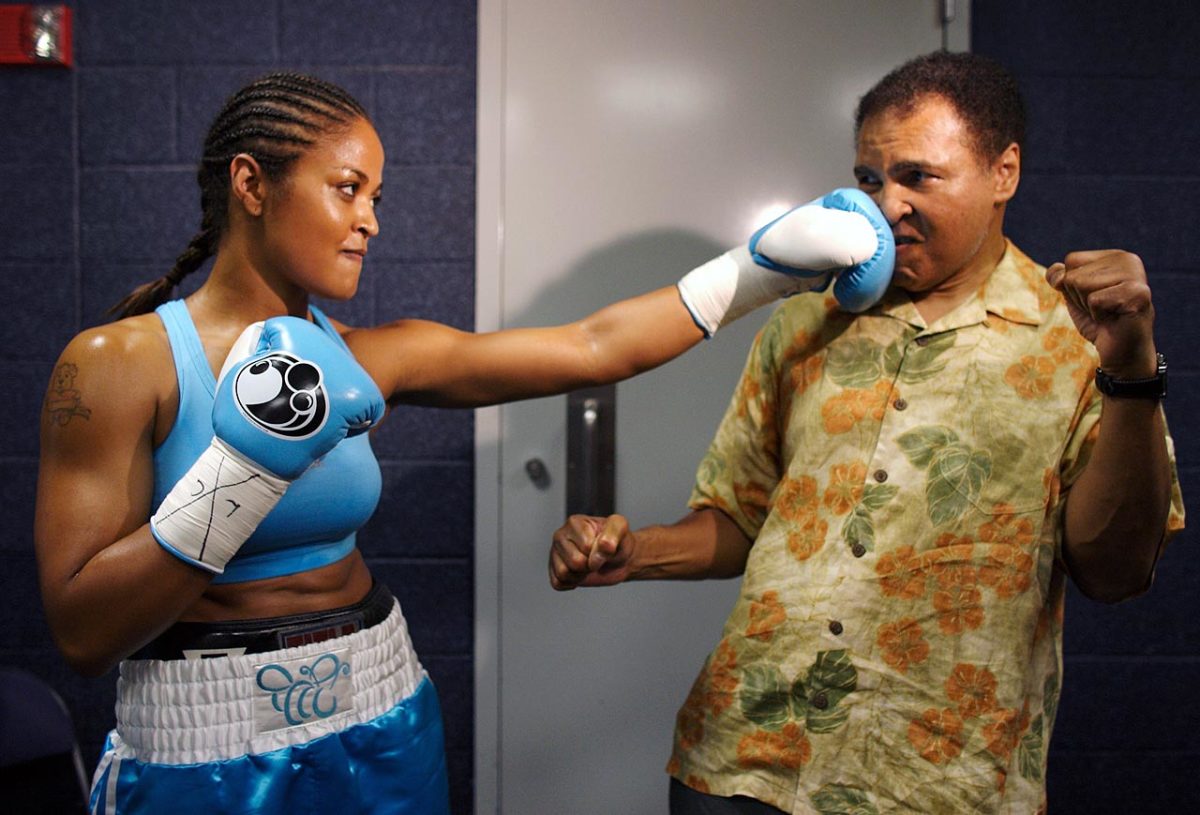
Ali takes a punch from his daughter Laila Ali while sparring before her fight against Erin Toughill in 2005. Laila retired from her own successful boxing career with a professional record of 24-0.
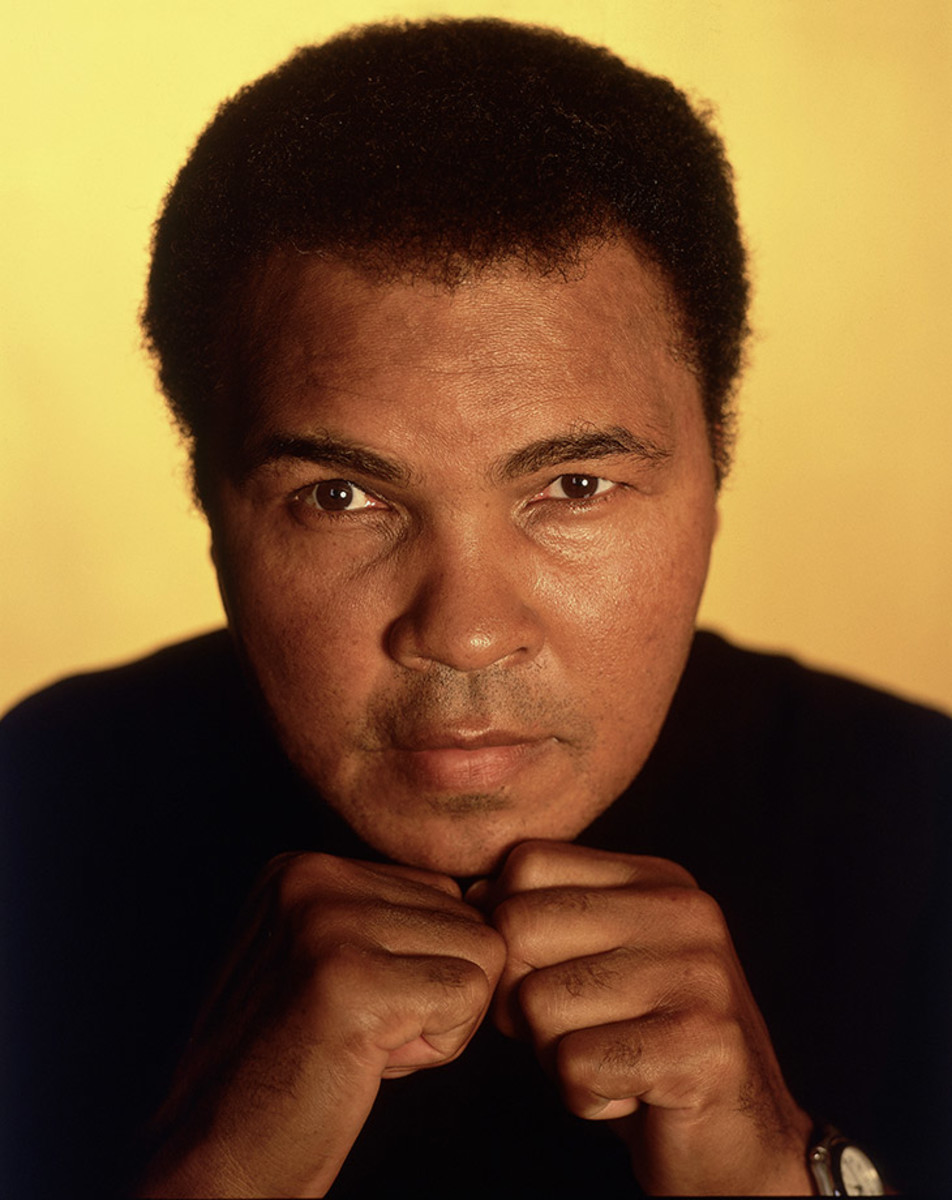
Ali poses with his fists up for a portrait in 2005.
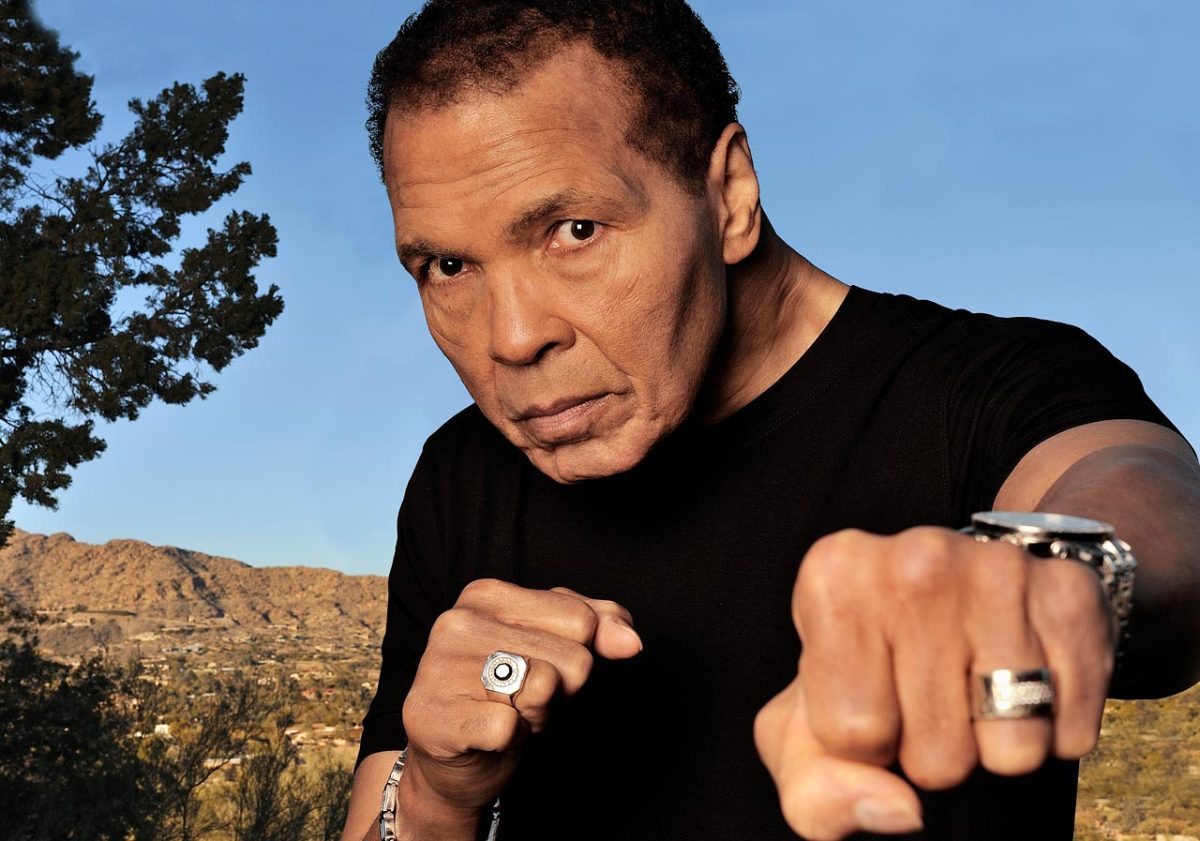
Ali poses with an extended punch in a 2012 photo shoot at his home in Paradise Valley, Ariz., to mark his 70th birthday.
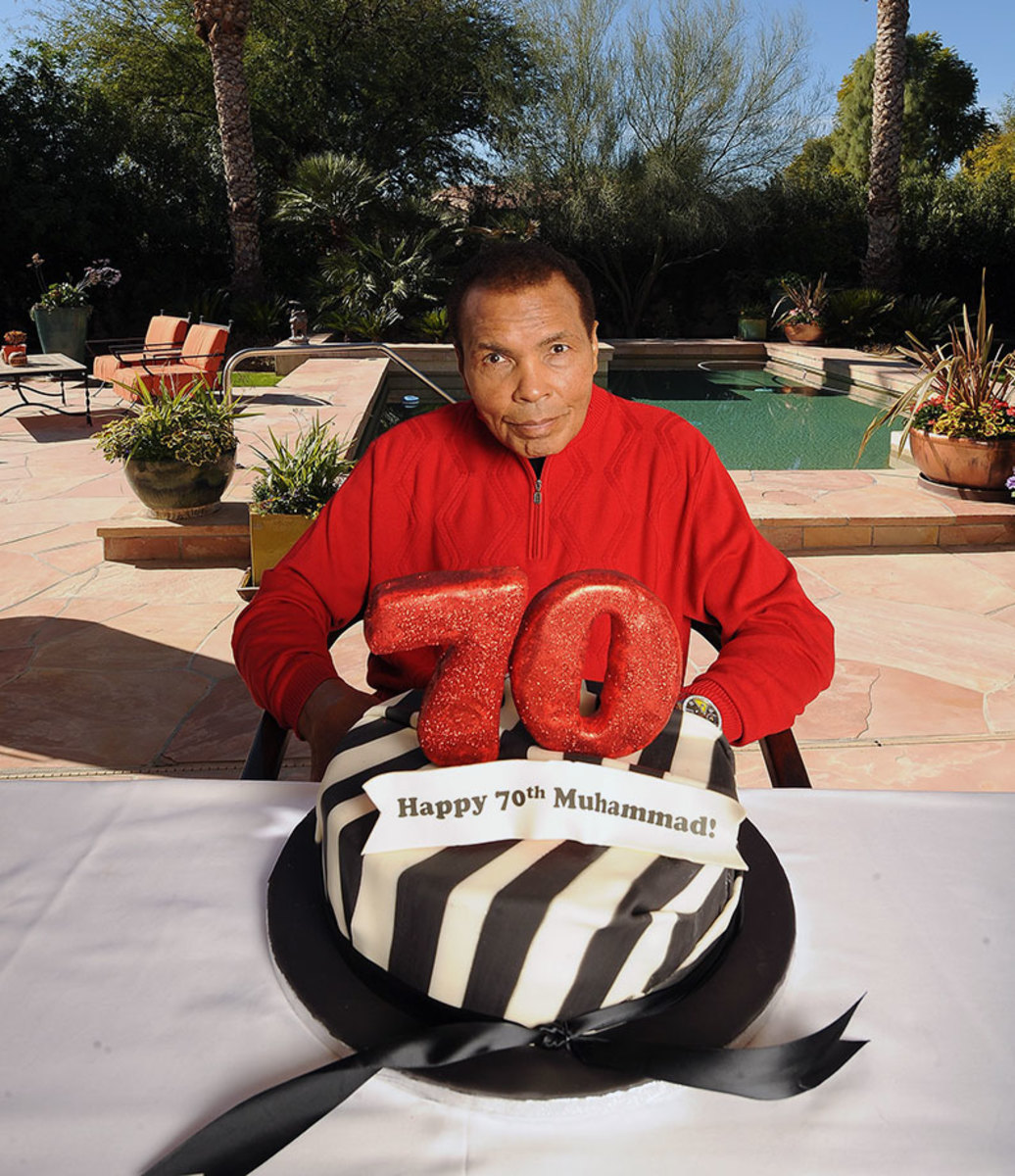
Ali sits in front of a 70th birthday cake in January 2012 at his Arizona home. Later that year he appeared at the opening ceremonies for the 2012 Olympics in London to escort the Olympic flag into the stadium, 52 years after he won gold in Rome.
